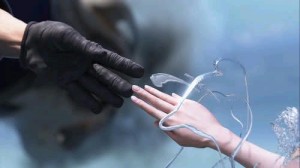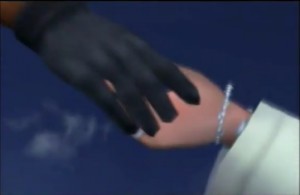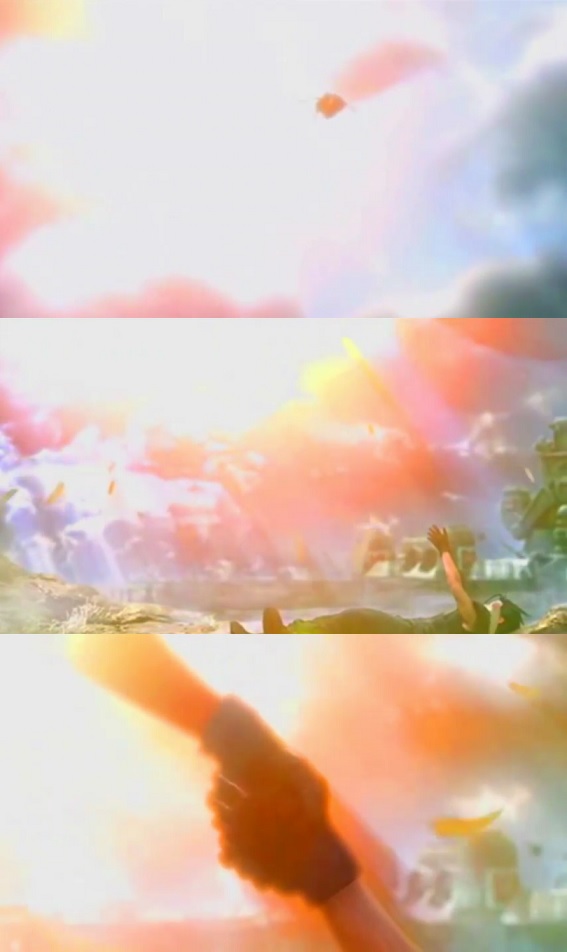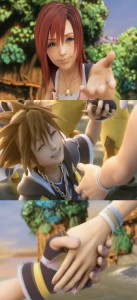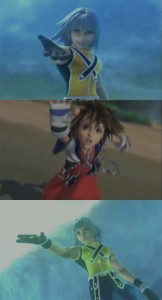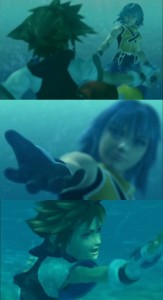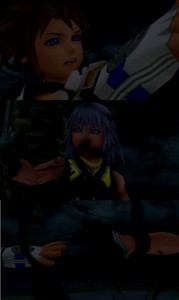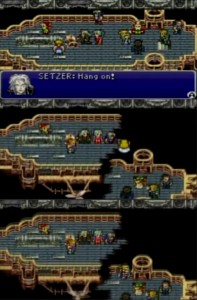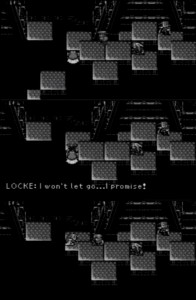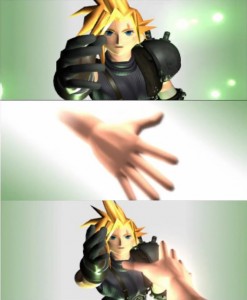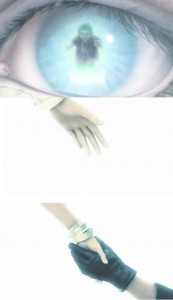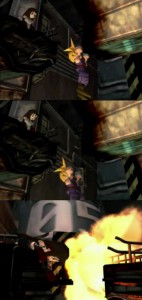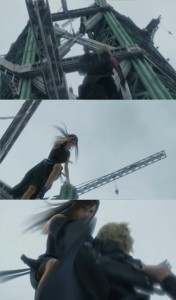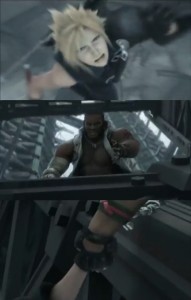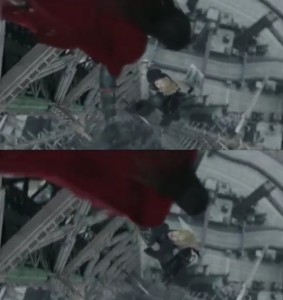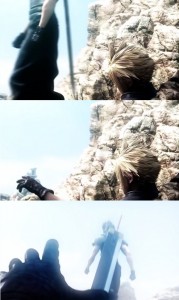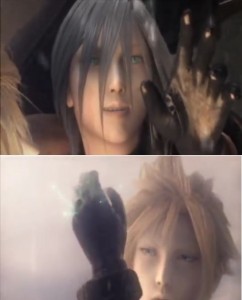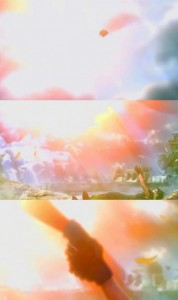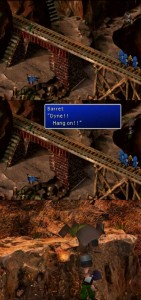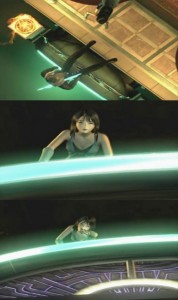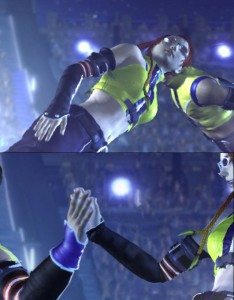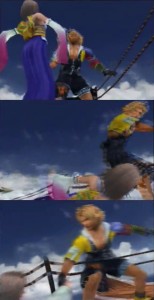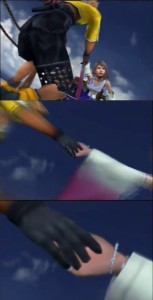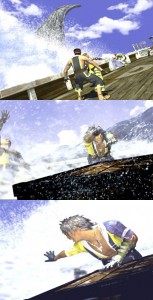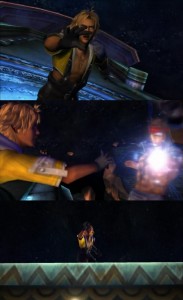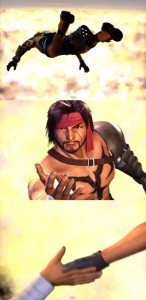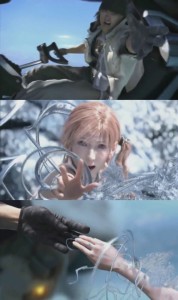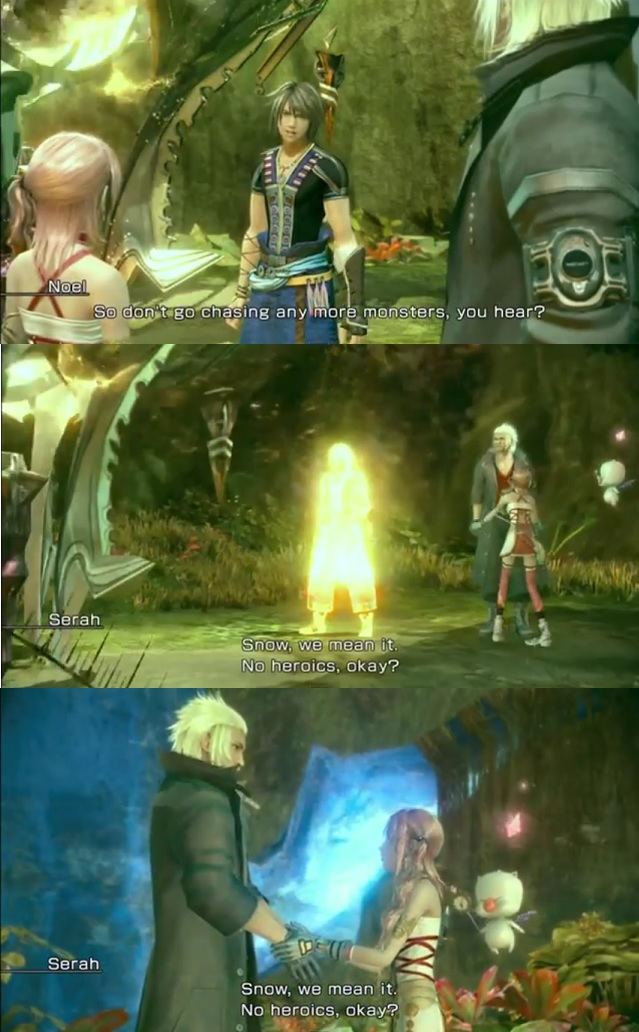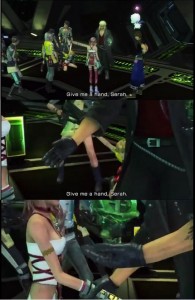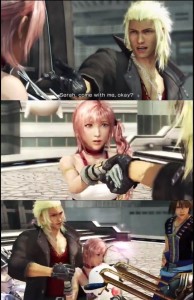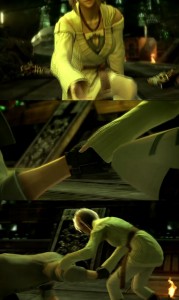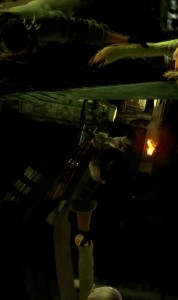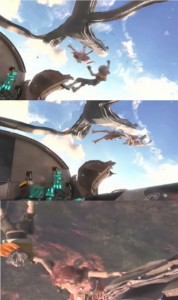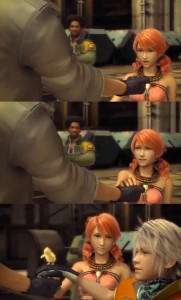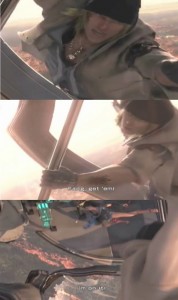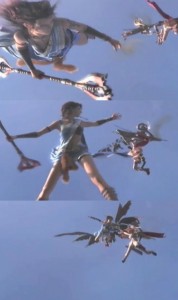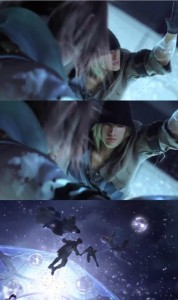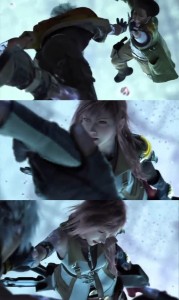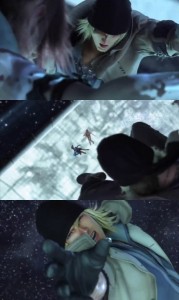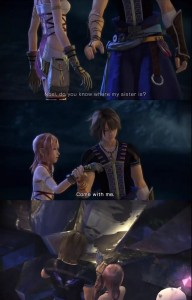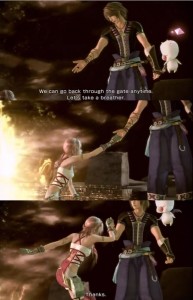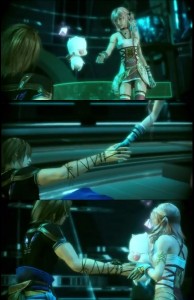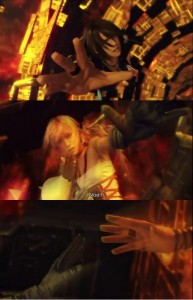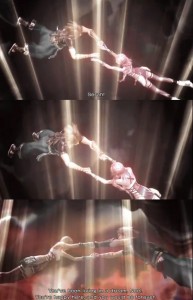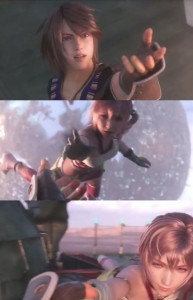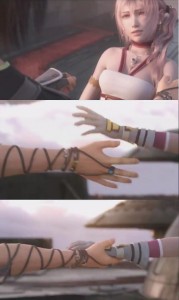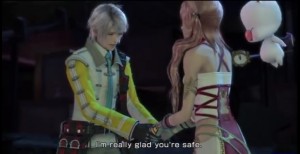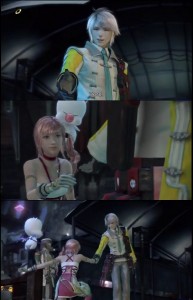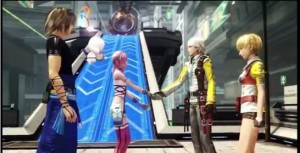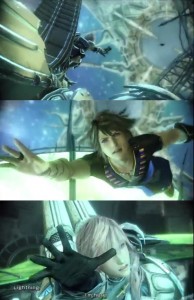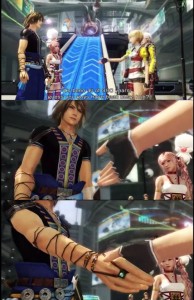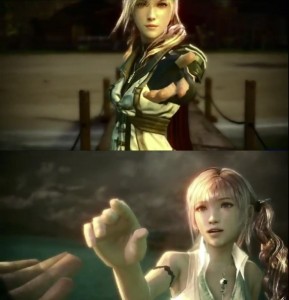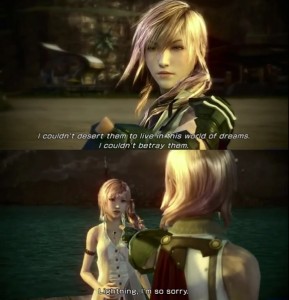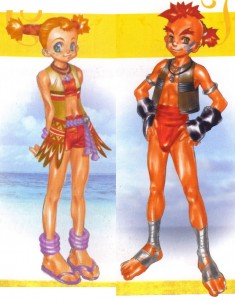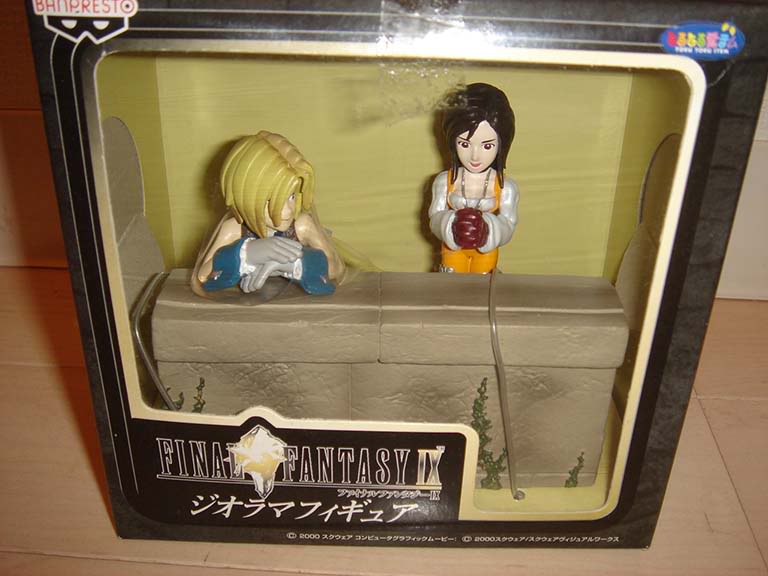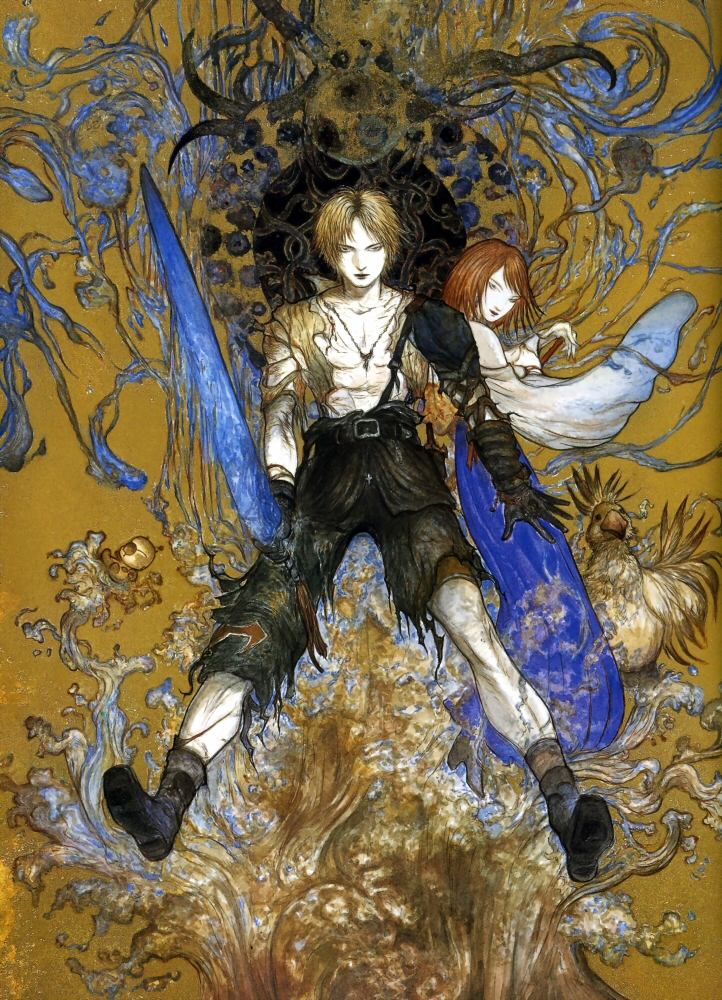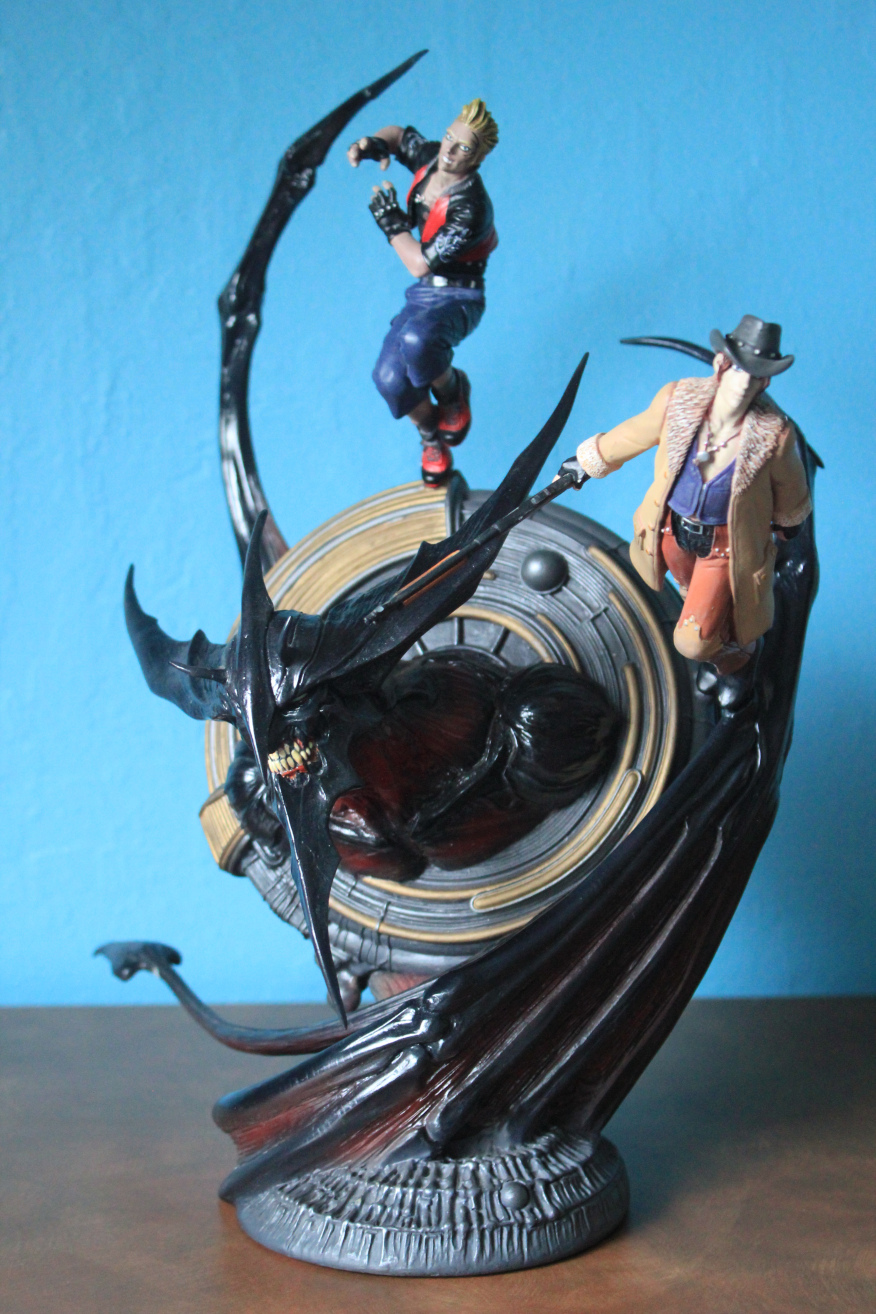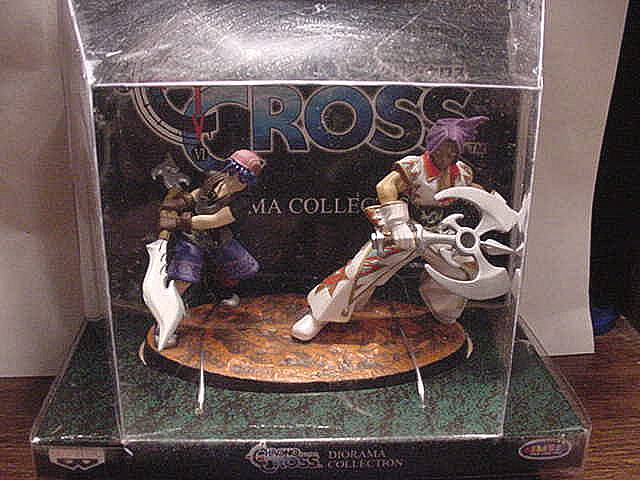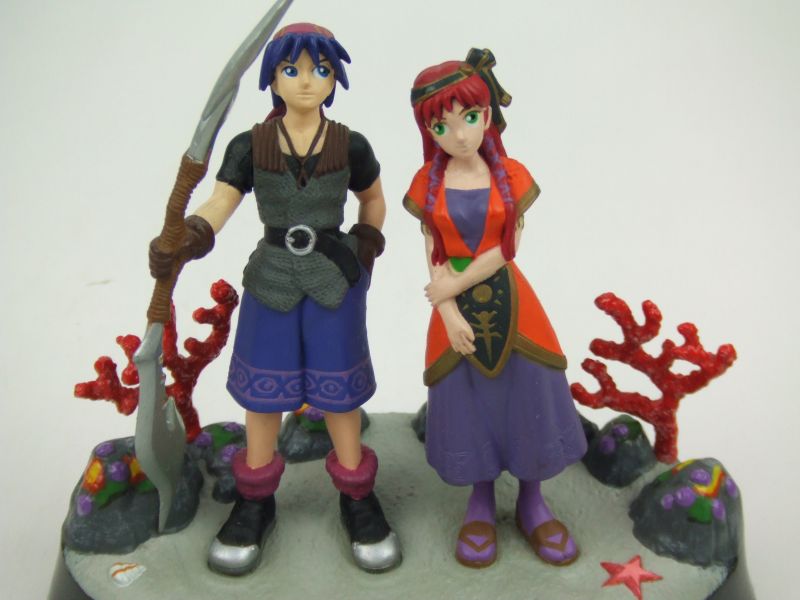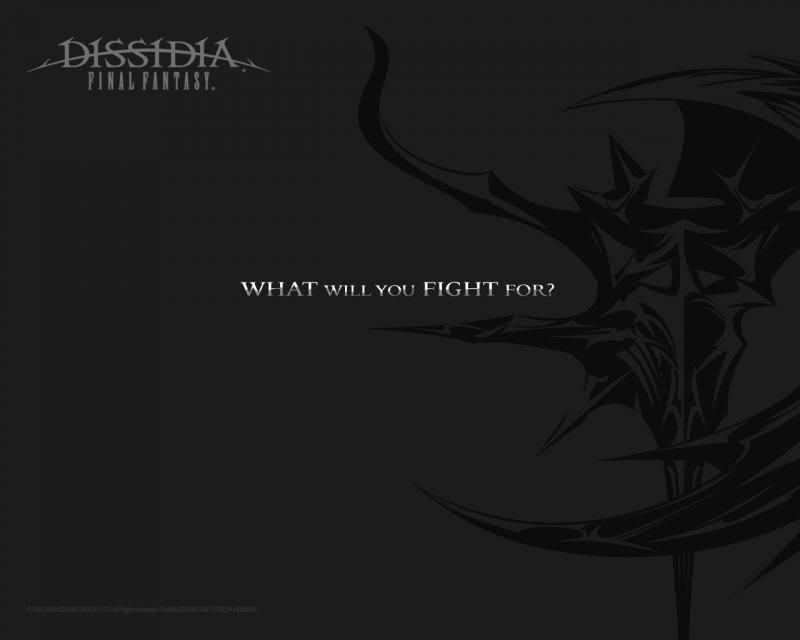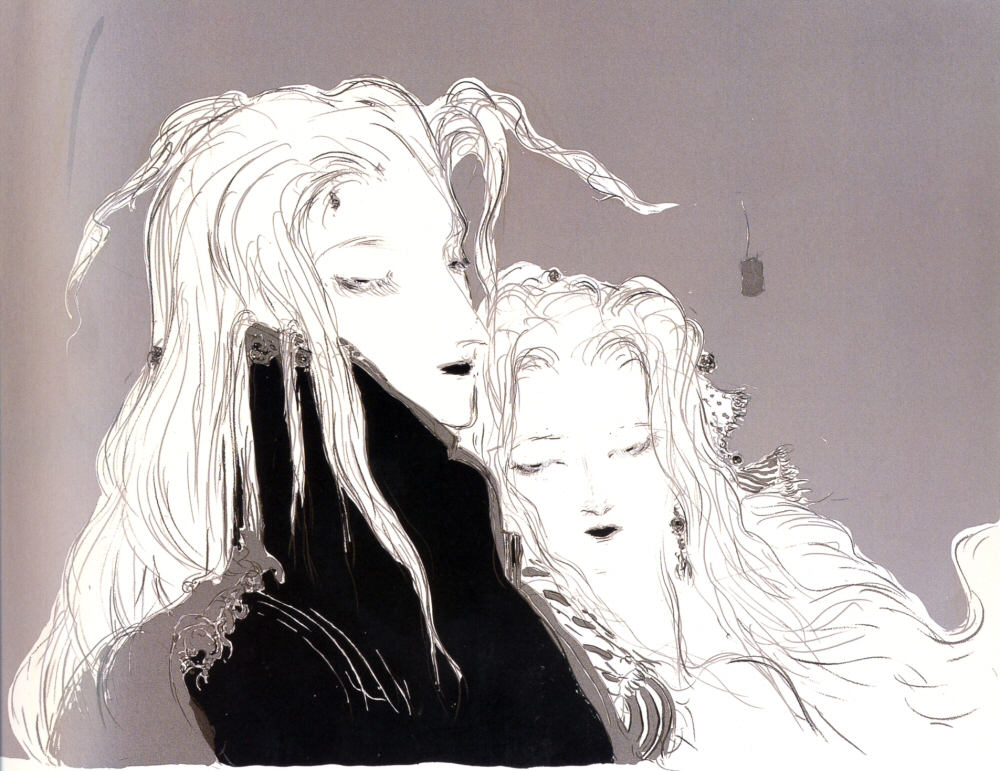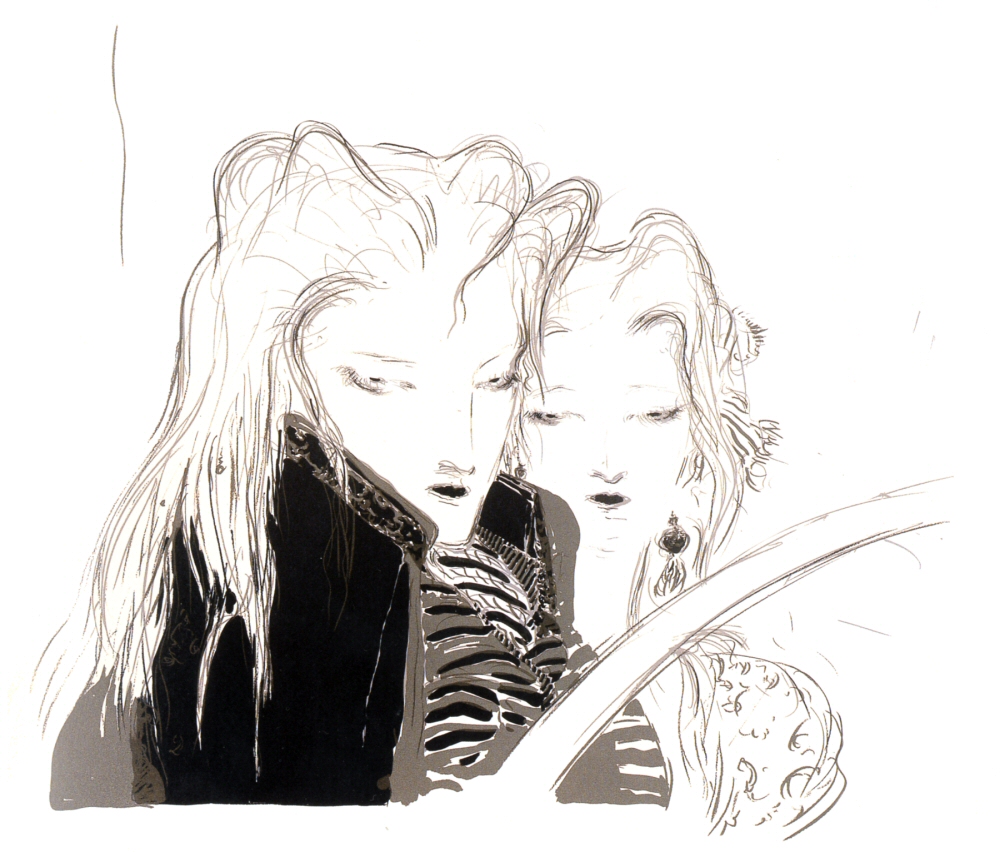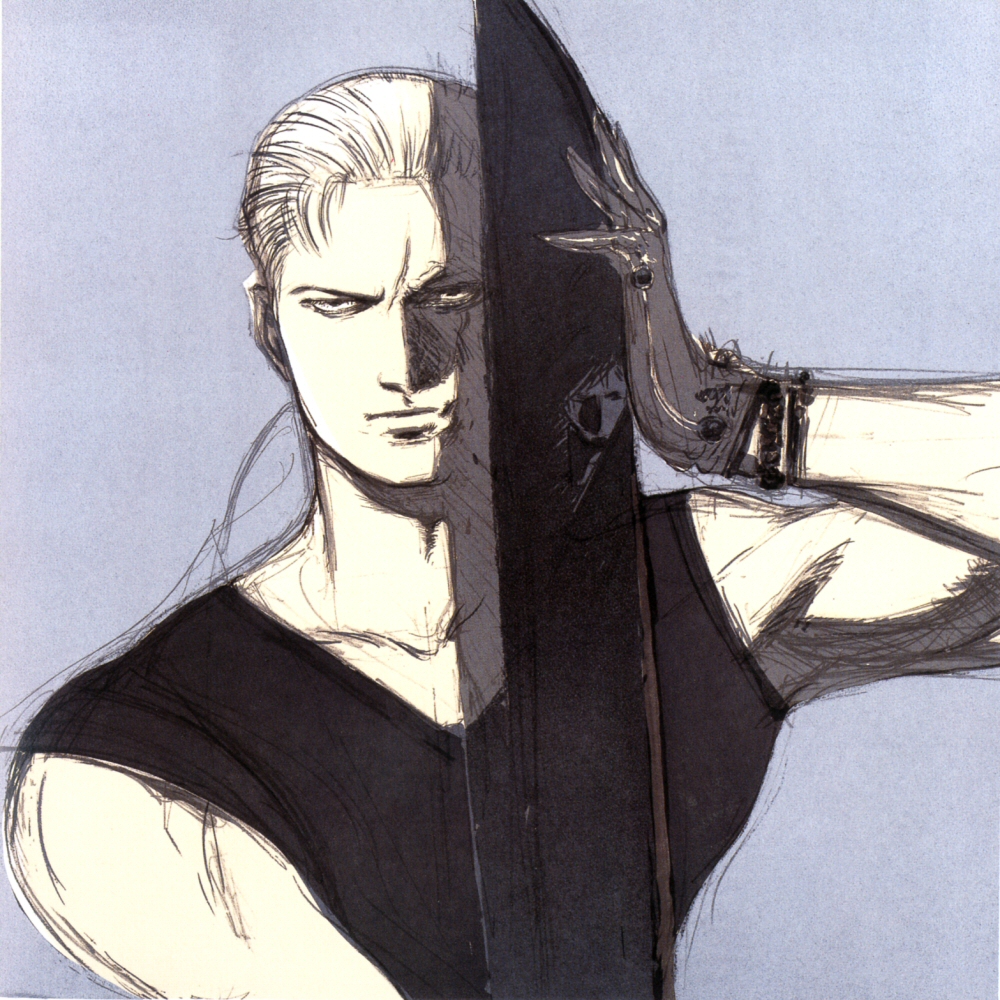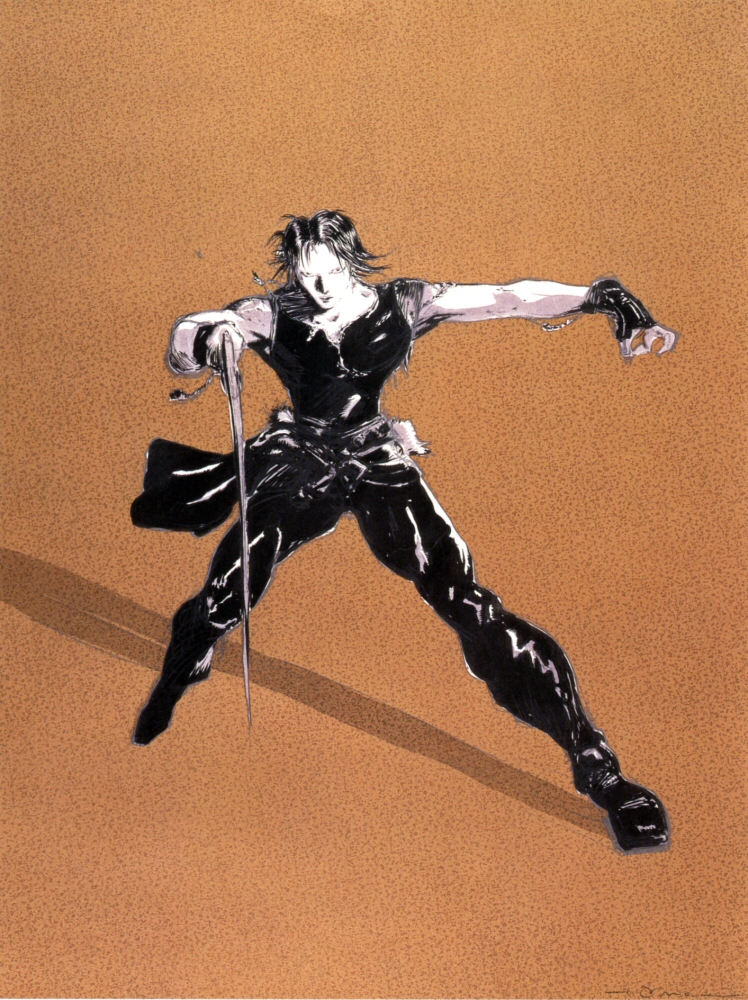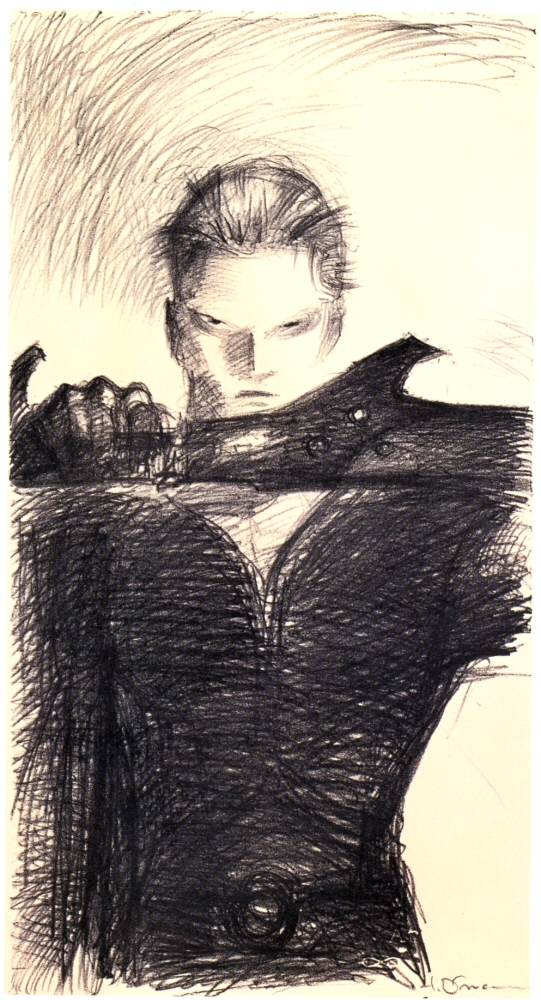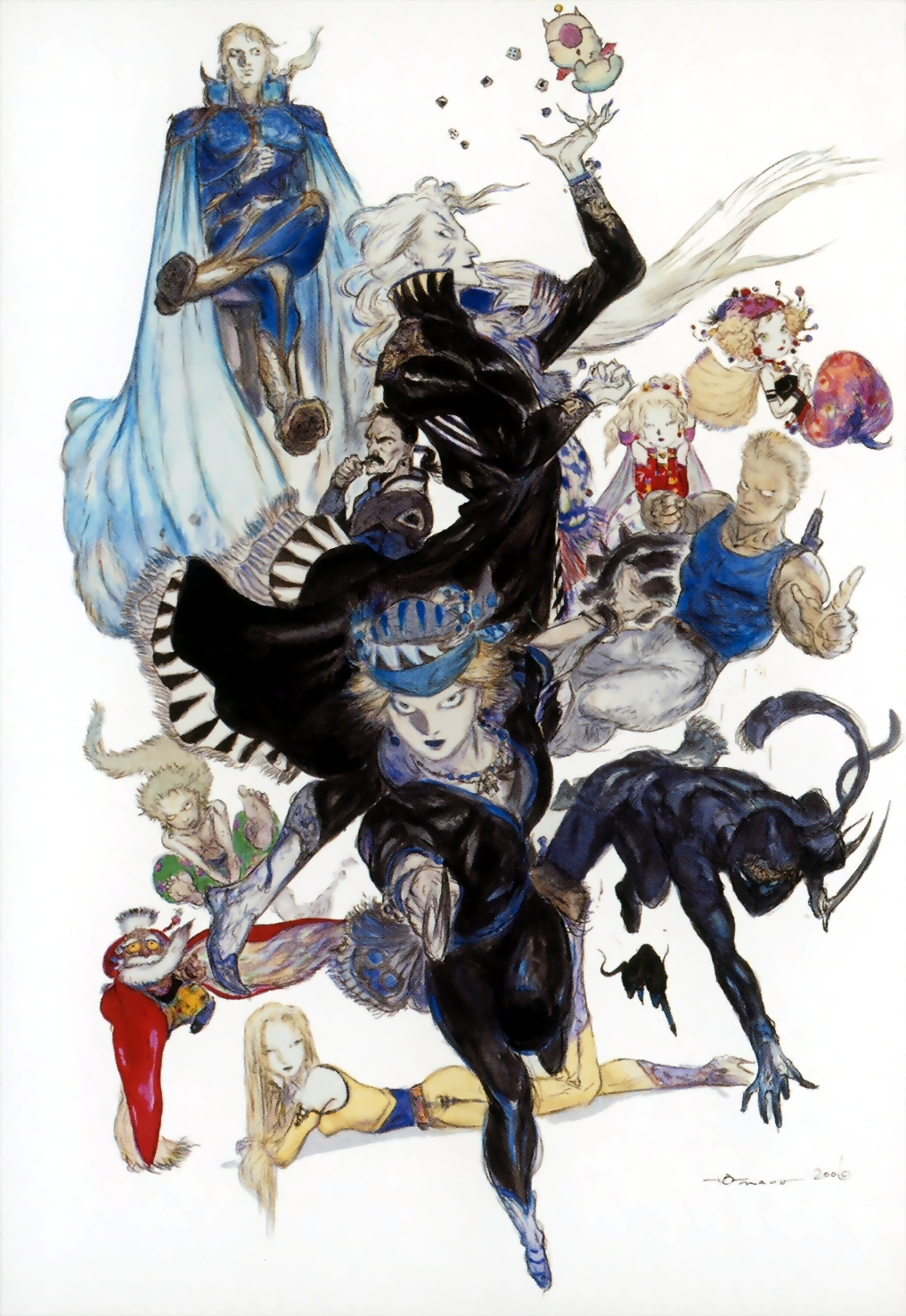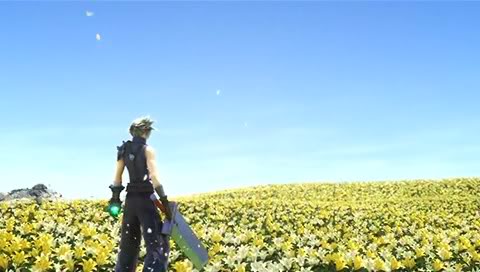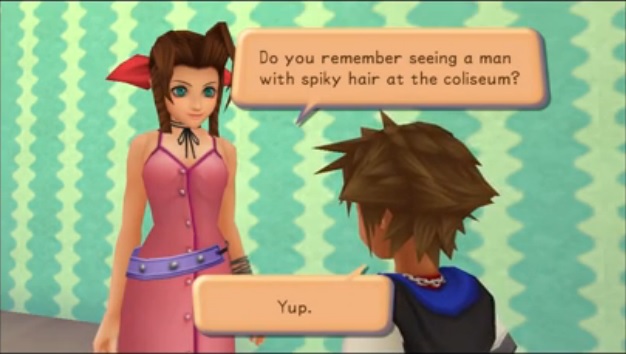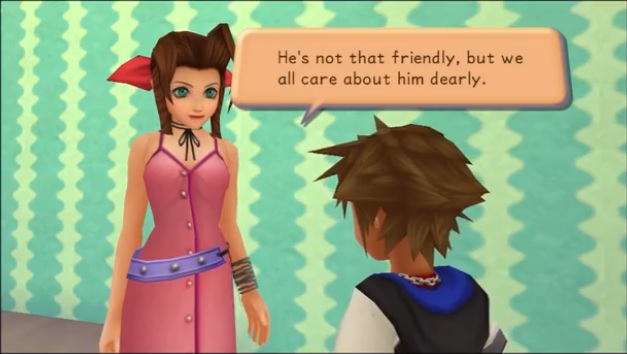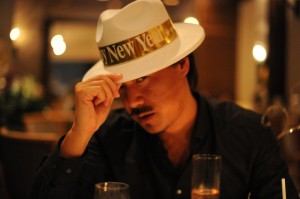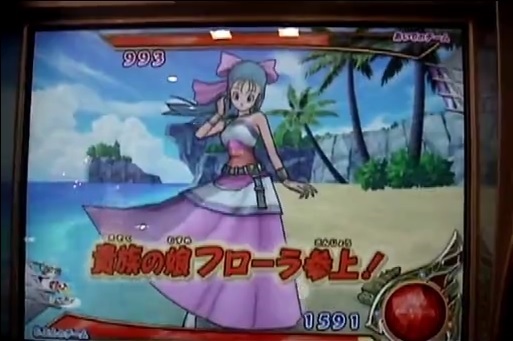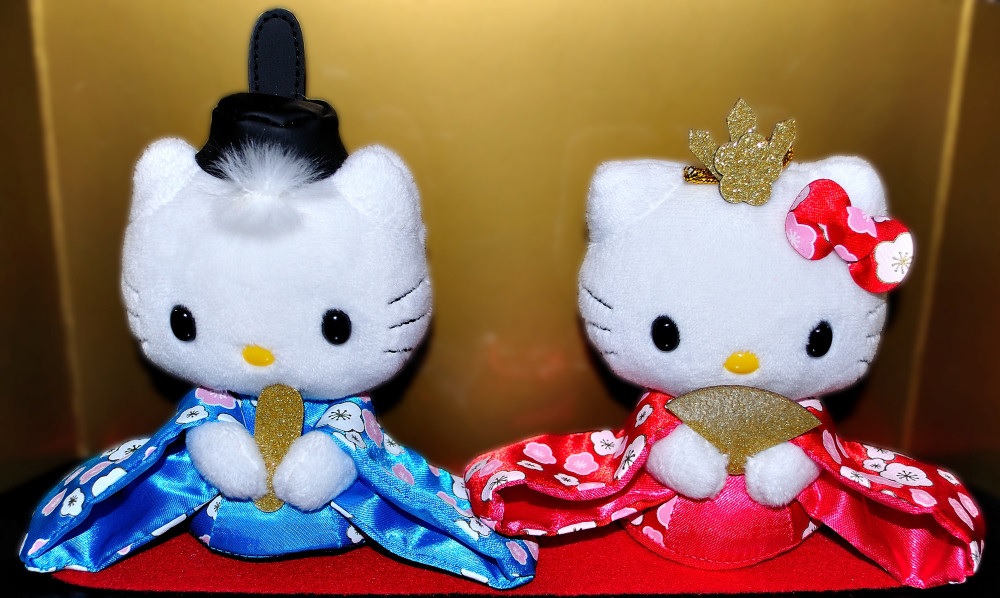Old Ghosts
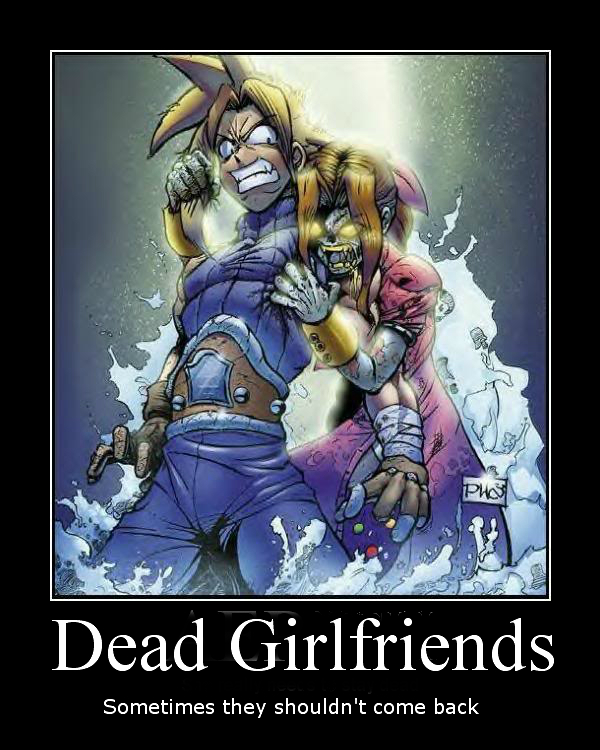
Having now firmly gone over what lies at the heart of the anti-Cloti worldview, as well as having determined what an appropriate reading of the material would be, for the sake of being comprehensive, let us now examine an assortment of other common misconceptions found among anti-Cloti arguments.
While I am personally not a fan of doing point-counterpoint responses to floating-in-space-type arguments that aren’t being attributed to a specific speaker or followers of a particular way of thinking, given that the claims are pervasive, yet few holders of these arguments — if, indeed, any one specific person — could be said to subscribe to them all, it’s somewhat necessary in this case. Be aware that someone you encounter making one of these claims may not necessarily tout them all.
—Claim: Being reminded of the promise he made with Tifa isn’t the reason Cloud continued working with AVALANCHE for the second bombing mission. He only did it for the money, not because the promise actually mattered to him.
Response:
While Cloud did demand money for assisting in the next mission, according to pg. 71 of the FFVII Ultimania Omega, the real reason he stayed was the promise:
(translation by hitoshura)
—
Promise on the water tower
The memory of Cloud and Tifa exchanging promises on the water tower 7 years ago has a vital significance when searching for “Cloud’s true self” in the Lifestream. Also, the promise to “come to Tifa’s rescue if she is in trouble” forms the reason for Cloud assisting AVALANCHE in this scene, but he has in fact already fulfilled this promise 5 years ago in the Nibel mako reactor.
—Japanese text:
—
給水塔での約束
7年前、ティファとクラウドが給水塔で約束を交わした思い出は、ライフストリーム内で「クラウド自身」を探るさいに重要な意味を持つ。また、「ティファがピンチになったら 助けに行く」との約束は、この場面ではクラウドがアバランチに協力する理由になっているが、じつは5年前のニブル魔晄炉ですでに果たされているのだ。
—
—Claim: Cloud saying “I think I can meet her…there” during the ending of the original game, even while Tifa was right there, shows that he is in love with Aerith rather than Tifa. That he was talking about Aerith here is confirmed by pg. 27 of the FFVII Ultimania Omega:
—
After settling things with Sephiroth, Tifa attempts to escape with Cloud from the crumbling hole at the Great Northern Cave’s extreme depths. Getting something of a hunch as to understanding the Promised Land’s meaning, he thinks he can meet someone … In response, she smiles and says “Yeah, let’s go meet her.” The person they’re talking about meeting is, of course, Aerith. As for the Promised Land …
—Japanese text:
—
セフィロスとの決着をつけたのち、くずれつつある大空洞の最深部の穴からクラウドとふたりで脱出をはかるティファ。”約束の地”の意味がわかったような気がす る、そこで会 えると思う……と言うクラウドに向かって、彼女は微笑み「会いに行こう」と語る。会いに行く相手は、もちろんエアリス。そして”約束の地”……。
—
To be talking about another woman while Tifa is hanging right there on his arm is hardly an indication that he wants to be with Tifa. It suggests the opposite.
Notice also that in this passage on pg. 126 of the FFVII 10th Anniversary Ultimania (pg. 128 of the Revised Edition) — from that book’s Story Playback section for Advent Children — that Cloud is said to have “a sense of yearning” in the scene where he is finally reunited with Aerith in a field of flowers.
Cloud’s desire to see Aerith again once his nemesis was vanquished — and even though he still has Tifa — coupled with a declaration that he had a yearning for her when reunited with her tells us everything we need to know about his feelings.
Response:
While Cloud was most certainly talking about Aerith at the bottom of the Northern Crater, pg. 203 of the FFVII Ultimania Omega also explains that Cloud was having a conversation with Tifa about getting to be reunited with those who have died when they themselves die and return to the Lifestream:
(translation by hitoshura)
—
Goodbye to Bugenhagen
When Red XIII refers to Bugenhagen’s passing away as him having “gone on a journey,” the team realize what has happened and answer that they “might meet him again somewhere.” If all people return to the Lifestream in the end, then they will in fact see Bugenhagen again someday. This line of thinking also shows up in Cloud and Tifa’s dialogue in the ending.
—Japanese text:
—
ブーゲンハーゲンとの別れ
永眠したブーゲンハーゲンを「旅に出た」と表現するレッドXIIIに、事情を察したクラウドたちは「どこかで会えるかも」と応じる。人がみな最後はライフストリームへ還る というなら、実際、ブーゲンハーゲンともいずれかならず会うことになるのだろう。このような考えかたは、エンディングでのクラウドとティファのやり取り(→P.206)に も現れている。
—
In other words, Cloud was expressing hope and positivity even in the face of the possibility that humanity would be wiped out by Holy.
While his line obviously expressed a sentiment on Cloud’s part to see Aerith again — a desire that continued through Dissidia Final Fantasy and On the Way to a Smile into Advent Children — he was already feeling guilt over her death and wanting absolution from it by that time. In Episode:Tifa, even as he stood on the Highwind watching the Lifestream and Holy defeat Meteor, he was already speaking of a need to be forgiven (official English translation and original Japanese):
—
“I’m going to live. I’ll never be forgiven unless I do.”
—Japanese text:
—
「俺は生き残ってやる。そうすることでしか、許されないと思うんだ。」
—
This was said the same evening as his line from the bottom of the Northern Crater.
As for the quote about Cloud having a “sense of yearning” for Aerith when she appeared to him on his way to the Forgotten Capital, that is a rather significant mistranslation. Here follows a more accurate take on those words:
—
DVD & UMD CHAPTER 9 In the place where sorrow doesn’t heal
Violent sparks fly in the Ancient capital, where sadness holds dominion
With the Forgotten Capital ahead of him, Cloud has a vision. Behind him, he feels a nostalgic presence and hears that gentle, innocent voice, unchanged from that time ——“Why did you come?”
Being so asked, Cloud gives voice to the desire within his heart (34). To that, the voice responds with amusement (35).
“By who?”
—Japanese text:
—
DVD & UMD CHAPTER 9 悲嘆癒えぬ地で
悲しみに覆われた古代種の都に激しく火花は散る
忘らるる都を前にクラウドは幻影を見る。背中越しに感じる懐かしい気配と、あのころと変わらない無邪気な、優しい声——。
「どうして来たのかな?」
問いかけられ、クラウドは胸の内にしまた願いを口にする(34)。その答えに、声のはおかしそうに言う(35)。
「誰に?」
—
—Claim: The scene in Final Fantasy VII’s ending when Cloud and Aerith reach out to one another within the Lifestream is, perhaps, the game’s most romantic. Building off that, the most romantic physical contact Cloud has with either Aerith or Tifa is the scene in Advent Children where Cloud and Aerith actually do take one another’s hand while he battles Bahamut SIN.
Not only is holding hands traditionally associated with romantic couples unless it involves small children or life-and-death situations, but the fact that the scene in Advent Children is paying homage to the similar scene in the original game makes it romantic in light of Cloud and Aerith’s relationship.
Kazushige Nojima specified on pp. 112–113 of the Reunion Files that the scene from Advent Children was designed in homage of that from the original game’s ending, per director Tetsuya Nomura’s wishes:
—
The ending scene of the battle with Bahamut, the scene where Aerith reaches out her hand, is homage to the last scene from a previous production. It was Tetsuya (Nomura)’s idea.
—Japanese text:
—
バハムート戦の最後にあるエアリスの手がさしのべられるシーンは、前作のラストからのオマージュですが、これは野村のアイデアですね。
—
If Nomura personally felt that the scene between Aerith and Cloud from Final Fantasy VII’s ending should be honored with such an homage in Advent Children, it is clearly different in its narrative value and its meaning for Cloud and Aerith from those times Cloud holds hands with his other comrades. Not only would Cloud’s developers not depict him in such contact with his male comrades, but Tifa herself gets no such scenes with him.
In this way, Square has established holding hands as a very special piece of imagery between Cloud and Aerith alone.
Furthermore, even without that extra layer of analysis, on its own, the scene is a touching, if bittersweet, moment. Cloud wasn’t able to take Aerith’s hand at the end of Final Fantasy VII, but was finally able to during Advent Children.
It also bears pointing out that the framing of the shot when Cloud takes Aerith’s hand matches that of shots for similar scenes involving other canon Square Enix couples — Kairi and Sora in Kingdom Hearts, Tidus and Yuna in FFX, and Snow and Serah in FFXIII:
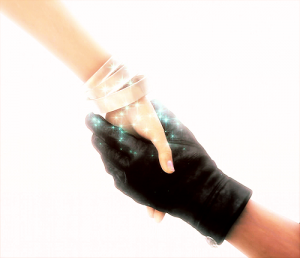
Response:
First, one simply must ask how the scenes where Cloud and Aerith extend their hands to one another are more romantic contact than whatever physical contact Cloud and Tifa shared beneath the Highwind at the end of Disc 2.
That addressed, Cloud most certainly has had comparable moments involving Tifa, if not his male companions as well. The homage in Advent Children may have been to a scene only between Cloud and Aerith in the original game, but the new scene itself still involves all of Cloud’s comrades and serves as commentary about how they are all there for him and still support him — they are not there as cheerleaders for a grand romantic moment between Cloud and Aerith, as the populace of Besaid were when Tidus and Yuna were reunited in FFX-2’s ending.
For that matter, it is *during* the homage that Cloud has comparable scenes with Tifa and even his male companions. Aerith is not singled out for this scene. During the Relay Battle against Bahamut SIN, Cloud grasps hands with Barret, Vincent and Tifa:
He even briefly smiles (for the first time in the film) as he sees Tifa coming to support him:

Moving on, if the context of Cloud and Aerith’s relationship makes the reach for one another inherently romantic, then what does this say about the similar scenes involving Cloud and Tifa? Does every scene involving Cloud and Aerith suddenly become romantic by default, even when he’s asking her forgiveness for letting her die or beating her up while under Sephiroth’s control?
Also being overlooked here is a common denominator involving every single instance of characters reaching their hands out to one another in the Compilation of Final Fantasy VII: They are all life-and-death situations, not romantic strolls through a park.
Both of those occasions when Cloud and Aerith extended their hands toward one another were life-and-death situations in which he was about to die. In fact, all such scenes involving Cloud and his comrades in AVALANCHE are life-and-death situations, including those with Tifa.
Let us review every single instance of characters extending their hands to one another like this in titles bearing Final Fantasy VII’s name.
We’ll begin with those involving Cloud and Aerith. The first time, she was trying to draw him back to the waking world after he had defeated Sephiroth in FFVII’s ending, guiding his attention to Tifa’s hand — and just in time too, as the ground under his feet was about to crumble away. The second time, she was — as we have gone over at length — assisting Cloud in his battle with Bahamut SIN, just like the rest of his comrades.
Neither of these situations are romantic, nor does the people involved in them instantly make them so.
Now, let’s move on to Cloud’s scenes with Tifa. In the first of these, she is calling out to him to get away from the same danger Aerith was trying to lead him away from. In the second, she was, like Aerith, assisting Cloud in his battle with Bahamut SIN.
Again, nothing romantic here. Likewise when Cloud took Barret and Vincent’s hands during the same battle the two women assisted him with.
While still on the subject of Advent Children, the scene where Aerith shows up to comfort the dying Kadaj and escort him to the Lifestream is not only decidedly lacking in romance, but Kadaj’s scene of salvation also calls back to the extension of hands between Cloud and his comrades when Kadaj takes Aerith’s hand. Further, while it was Nomura’s idea to include the homage to FFVII’s ending, it was apparently also his idea to include this scene between Aerith and Kadaj, per pp. 116–117 of the Reunion Files:
—
“Initially, the church scene was placed immediately after Sephiroth’s defeat. None of the sequences with Kadaj were there, such as the scene where Kadaj feels Aerith’s presence and disappears into the rain. We wanted to make Kadaj someone who also needed salvation. I’m glad that this part made it into the movie.” (Nomura)
—Japanese text:
—
最初、セフィロスを倒したら、いきなり教会のシーンだったんですよ。カダージュとの一連のからみは一切なく、カダージュが雨に打たれて消えていくのも、そこでエアリスを感 じるシーンもなかったんです。カダージュ逹も救われなきゃならない存在。それは無理を言って足してもらって良かったなと思います(野村)
—
These scenes aren’t about romance. They’re about support and comfort. Just look how similar Kadaj’s death scene is to Zack’s passing, where Angeal’s spirit descends from the sky to lift him up like Aerith would later do for Kadaj:
For good measure, also take note of the scene in the original game when Barret and Dyne extended hands to one another as Dyne fell over a canyon’s edge while under fire from Shin-Ra soldiers:

Again, if you’re looking for something romantic in this life-and-death situation (yet another one), you will be disappointed.
Romance simply doesn’t have much of a claim to scenes in Final Fantasy where characters extend hands to one another.
Even characters who have actually been involved in these sequences with their canon romantic partners have been involved in similar scenes that didn’t involve those partners or another romantic interest. For Final Fantasy VII alone, this is true of Cloud, the character at the heart of this entire discussion, but it hardly ends with him.
Let’s now take a look over an exhaustive list of such scenes in the Final Fantasy series, as well as Kingdom Hearts, noting for each entry along the way whether physical contact was made, whether one or both parties extended their hand to the other, and whether the situation was life-threatening.
●Sora and Kairi (x2)
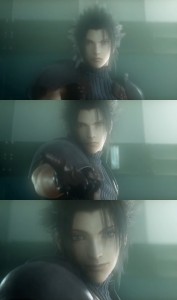
●Tidus and Jassu
●Serah and Noel (x7)
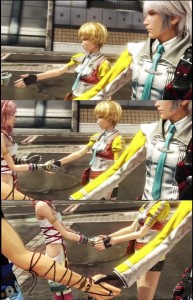
●Serah and (fake) Lightning (x2)
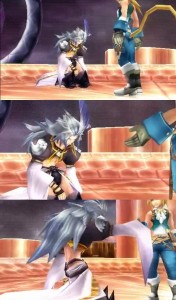
Who knew what an intricate web of romance FF really weaved? Despite being engaged to Snow and having two games with him now, Serah has several more scenes of hands being extended with Noel in the course of a single game — and that’s even if one allows both scenarios on the Sunleth Waterscape to be counted separately for Snow.
For that matter, several of Noel and Serah’s moments actually amount to holding hands just because they want to, which has otherwise been associated in this debate with romance. If these scenes really are narrative shorthand for “These characters romantically love one another,” then Serah and Noel would have the grandest, most expressive love of all.
When she dies, Noel even holds Serah’s body against his, screams her name at the sky, caresses her cheek, strokes her hair and grieves over her — as Cloud did Aerith’s body with regard to at least a few of these.
Despite all this, Serah and Noel are not romantic partners, nor is so much as a romantic attraction between them ever implied. On pg. 10 of the FFXIII-2 Ultimania Omega guidebook, Noel and Serah are only described as “partners” (パートナー) while Serah and Snow are still described as “koibitos” (恋人) — meanwhile, Yeul is identified as Noel’s “taisetsu na sonzai” (大切な存在), or “important person.”
Added to that, Yeul is referred to as Noel’s koibito on pg. 18 of the same book:
(translation by hitoshura)
—
“Your time-gazing friend”
Noel, a descendant of the Farseer tribe, has heard about Valhalla and the gates from Yeul, the Farseer maiden from his time and his lover. Because Lightning also knows this, she is hinting at Yeul with the expression “your time-gazing friend.”
—Japanese text:
—
「時を視る彼女」
時詠みの一族の末裔であるノエルは、ヴァルハラやゲートについて、同時代の時詠みの巫女であり恋人だったユールがら聞いていた。ライトニングもそれを知っているため、「時 を視る彼女」という表現でユールのことを示唆している。
—
Yes, Serah and Snow, Kairi and Sora, and Tidus and Yuna share shots of extended hands that match a shot between Aerith and Cloud in Advent Children. However, the Final Fantasy developers — specifically Motomu Toriyama (event director of FFX; director of FFXIII and FFXIII-2) and Tetsuya Nomura (director of Advent Children, Kingdom Hearts and Kingdom Hearts II) — use that same way of framing characters reaching toward one another over and over, and not just for romantic couples. Yes, it was done for the three couples identified above — but it was also done for Sora and Riku in addition to Serah and Noel (twice), and even Tidus and Jecht.
Tidus, Sora and Serah can’t prove there’s a rule while simultaneously being exceptions to it. Really, what would that make of Tidus and Jecht’s similar shot in FFX’s ending? Or the fact that neither Squall and Rinoa nor Dagger and Zidane ever have a comparable scene?
What, too, do we make of the fact that when Serah and Noel hold hands before the battle with Gogmagog that they are positioned and spinning just like when Tidus and Yuna hold hands in the Macalania Spring? Should we even make anything of it?
If extending their hands to one another in a life-threatening situation where death was imminent for one of the parties participating and numerous others is supposed to be the most romantic CloudxAerith moment, then what is this casserole of nonsense that we have gone over above? The fact that such a detailed breakdown as all this is even necessary just underscores how absurd the debate has gotten.
—Claim: There is an ongoing theme in the Final Fantasy series in which a character loses someone they were in love with and does not seek to replace them. Instead of moving on and abandoning the memory of the deceased, they hold onto it and honor them.
We see this in Final Fantasy IV with Edward, who loses his love Anna. She dies protecting him and he goes on to rule the kingdom of Damcyan alone.
We see this in Final Fantasy VII with Vincent, Barret, Elmyra and Dyne. Vincent lost Lucrecia, whom he still mourns more than 20 years later in Dirge of Cerberus. Barret and Dyne lost their wives — Myrna and Eleanor respectively — three years before the events of FFVII, but neither has remarried by the time the game is over, nor has Barret remarried by the time of Dirge of Cerberus, an additional three years later. Elmyra’s husband died in the Wutai War 15 years before FFVII, yet we never hear of her remarrying.
We see this theme again in Final Fantasy VIII, where Laguna’s wife, Raine, has been dead for 17 years while he has gone unmarried ever since. As the president of Esthar, the world’s largest and most powerful nation, certainly he could have found another wife if he had wanted to.
We see this with Yuna in Final Fantasy X-2. As a dream of the fayth, Tidus faded away two years earlier at the end of Final Fantasy X, but Yuna has not stopped searching for him — much like Cloud continues searching for Aerith in Advent Children’s credits, two years after the end of FFVII.
Finally, and along those same lines, Final Fantasy XII’s Ashe lost her husband, Rasler, to the battlefield two years before the main events of that game — yet, in the end, she will hang onto his memory alone. Even after she has reclaimed her homeland and become queen, she decides to remain alone.
Square is trying to tell us something, if we would but listen. Romance continues beyond death.
Response:
Before we get started, it simply must be pointed out that Aerith herself — the dead figure at the center of this matter with Cloud — moves on from her loss of Zack, and that she did so in no short period of time herself. For five years, she continued sending letters to him before finally deciding she would move on with her life.
She can hardly be at the center of what is supposedly the leading example of this proposed theme in the Final Fantasy series when she herself didn’t conform to it with her own behavior. Already, this supposed theme stands on shaky ground in our analysis.
It finds itself with even less support when considering Final Fantasy VI’s Locke, perhaps the Final Fantasy series’s best example of one who has lost the recipient of their romantic affection, for Locke lost his beloved Rachel to both amnesia and death years before the events of Final Fantasy VI. However, he too eventually moves on — with her blessing and at her request, no less — with Celes.
Those points made, it is a fair and accurate observation that someone in Laguna’s position could have easily remarried had he wished to. However, that said, he is perhaps not only the sole example of this theme to be found in the Final Fantasy series, but he is also a counterpoint to it.
Before he met Raine, Laguna was in love with Julia Heartilly, mother of Rinoa Heartilly — the young woman who eventually ends up romantically involved with Laguna’s son, Squall. However, after Julia marries Rinoa’s father, Laguna moves on and finds love with Raine.
Again, this purported theme has no leg to stand on.
Next up for consideration, how do Barret and Myrna serve as an example of romance continuing beyond death? So he hasn’t remarried in the three years between her death and the beginning of Final Fantasy VII — while he’s been leading a terrorist cell and barely managing to take care of the infant that was left in his care.
How are we supposed to conclude from this that the idea of remarrying isn’t something he would ever consider? He didn’t exactly have time for both casual dating and leading a clandestine, violent lifestyle while simultaneously taking care of a young child.
Even after FFVII, Barret’s life is far from stable. He not only has a host of personal demons to bury, but he doesn’t even feel fit to be a father to Marlene at this time, which is why he leaves her in Cloud and Tifa’s care in the first place. He is hardly in a good place to get a potential love interest mixed up in his personal baggage.
For that matter, neither Barret nor Elmyra are ever depicted addressing the topic of romance. For all we know, Barret would love to have another wife once he sorts out all of his personal problems. Along those same lines, for all we know, Elmyra dated numerous men while raising Aerith — or she may have wanted to yet dated none because she didn’t feel comfortable bringing strange men into her home around the young girl she was raising. The latter is not an unlikely scenario, particularly given where they lived, but the first isn’t out of the question either.
The point is this: We simply don’t know, so using either character as an example of a contentious theme is a presumption rising to the level of fabrication.
As for Dyne, he’s not a good example of anything save a self-loathing, criminally insane individual with aspirations to drown the world in fire. He wanted to kill everyone on the planet, including his four-year-old daughter, so it’s little wonder that he hadn’t charmed some other lady into being his wife.
While one would probably be tempted to argue his insanity as proof of his ongoing devotion to the wife he lost, it does bear pointing out that he believed his daughter to have burned to death as well — and that he also lost his entire town, including friends, family and any support network he may have had that usually helps a person cope with great loss. And on top of all that pain he already had to deal with, he must have blamed himself at least a little for having ever given up his opposition to Shin-Ra building a mako reactor near Corel.
As for Vincent Valentine, while he certainly didn’t move on with his life in any timely fashion, at no point in any Compilation of FFVII title is this portrayed as a positive thing. Lucrecia herself hoped for only one thing: that Vincent would live on.
For that matter, following his finally coming to terms with everything from his past in Dirge of Cerberus, Vincent does finally appear ready to move on with his life. Maybe this will include romance, maybe it won’t. If he decides it will, the story to Dirge of Cerberus has already provided him with Shelke, a young woman with Lucrecia’s memories and feelings for Vincent.
Ashe from FFXII is a poor example of “romance continuing beyond death” for much the same reasons as Barret. Her life after Rasler’s death was a nigh-untenable disaster. Her father was murdered soon after, her kingdom conquered, and she herself would spend two years living in hiding, pretending to be dead while plotting revenge and the liberation of her people from Archadian rule.
There isn’t a logical juncture in this time period where she should have begun receiving suitors.
Even in the year that followed before the events of FFXII’s sequel, Revenant Wings, she had a kingdom to rebuild. Perhaps Ashe will never love another romantically, but the periods of her life which we have gotten to see don’t lend themselves to drawing that conclusion, particularly for a young queen who was only 20 years old the last time we saw her.
As young as she is and as dedicated to her duty as Dalmascan royalty as she is, it is extremely unlikely that she won’t marry again, if only for political purposes. For that matter, her marriage to Rasler was also a political marriage; she simply happened to actually fall in love with him.
Moving forward, FFX-2’s Yuna didn’t spend the entirety of the more-than-two years after Tidus’s death looking for him. She only began searching for him following the events of FFX: The Eternal Calm, a full two years later, when Rikku brought her a sphere that contained a recording of a man who looked and sounded like Tidus.
Only when she believed that he might be alive did Yuna seek a reunion with him.
As with Vincent from FFVII, Yuna didn’t do much of anything with her life after FFX. However, this had to do with more than just losing Tidus. It had as much to do with her shame and regret over how they had to destroy Sin at the sacrifice of multiple people. Once more, her languishing in the past was not portrayed positively, and all of FFX-2 was about moving on, for Spira and for herself.
In the end, she does move on, deciding the story of her life will be a good one — and only then is she reunited with Tidus after growing as a person.
The actual theme, if one is to be found as relates to life and love after death, is that of moving on with one’s life. Edward’s entire personal subplot in Final Fantasy IV: The After Years is about him moving on from the past.
Initially, he is miserable and unable to let go, sure. An NPC in Kaipo will remark that “King Edward makes regular visits to Tellah and Anna’s gravesite, you know. I see him there all the time.” He is also unable to find rest, often losing much sleep.
Even 17 years after Anna’s death, he has been mired in the past. However, his female assistant, Harley, gradually comes to mean a great deal to him, as he does to her.
As he worries about Harley early on in Star-Crossed Damcyan — Edward’s personal chapter of The After Years — he has a very important dream:
—
Chancellor: “Your Highness? I suppose you did not get a great deal of sleep last night, either. Please, try to get some rest.”
Edward: “I will. Thank you, Chancellor.”
Chancellor: “Goodnight, Your Highness.”::The Chancellor leaves::
Edward: (Anna…Tellah)
::Eventually, Edward tries to sleep and dreams that he is in Kaipo, where he had seen Anna’s spirit shortly after her death 17 years before::
Edward: “Why…why am I here?”
::Anna appears over the lake::
Edward: “Anna!”
Anna: (Edward…)
Edward: “What is it, Anna?”
Anna: (…)
Edward: “Why must you look so sad?”
Anna: (…)::Anna fades away and Edward wakes up::
Edward: “Anna?” (…)
—
As Edward visits the graves of Anna and Tellah later in the chapter, the following scene takes place:
—
Edward: “Anna…Tellah… It’s been quite a while, hasn’t it?”::Edward begins playing his harp; Anna’s spirit appears::
Edward: “Anna…”
Anna: …
Edward: “Anna… Why must you be so sad?”
Anna: …::Anna fades away::
Edward: “Anna!?” (What are you trying to tell me, Anna?)
::Edward begins walking away, but a voice stops him::
“What, can’t you tell?”
::Tellah’s spirit appears::
Edward: “Tellah!”
Tellah: “Anna wants you to live, Edward.”
Edward: “What? What do you mean? I’m as alive as I’ve ever been.”
Tellah: “Hah hah hah!”
Edward: ?
Tellah: “Try asking your own heart about that one.”
Edward: “What?”
Tellah: “Got that?”::Tellah disappears::
Edward: “Tellah…”
::Edward looks down::
Edward: “My own heart…”
—
Soon thereafter, Edward acquires a Sand Pearl to save Harley’s life — just as Cecil did for Rosa 17 years earlier:
—
Edward: “Harley!”::He shines the light of the Sand Pearl on Harley, who was suffering from desert fever::
Harley: “Ngh…Ugh…”
::She awakens::
Harley: “Your Highness…”
Edward: “Harley! Thank goodness I made it in time…”
Harley: “My deepest apologies. This is all my fault…”
Edward: “No, Harley. You did…nothing wrong…”::Edward collapses::
Harley: “Your Highness!”
::The screen fades out, then back in, this time with Harley watching over Edward as he awakens::
Edward: “Nnngh…”
Harley: “Your Highness! You’re awake!”
Male Kaipo resident: “Luckily, this doesn’t look like a case of desert fever to me.”
Edward: “Now it’s my turn, is it… I apologize for worrying you.”
Harley: “You’ve gone halfway around the world for me, my lord. Why did you put yourself through this?”
Male Kaipo resident: “You’re the one who’s pushing herself too hard here, my lady. You’ve just recovered from the illness yourself, and yet here you are, staying up all night by his side.”
Edward: “What?”
Harley: “You promised me you wouldn’t tell him!”
Edward: “Harley, you didn’t have to do that.”
Harley: “O-of course I did. You brought me the sand pearl, and…er, I mean, it is my duty as your secretary, my lord…”
Edward: “Thank you, Harley.”
—
Afterward, an elderly lady in Kaipo will make the following observation:
“You know, something just like this happened here long ago.
And what’s more, I hear those two have since become king and queen of Baron. Imagine that! You better take good care of that girl, understand?”
The point being made here for the narrative is quite obvious.
Continuing with the story of The After Years in its final chapter, in the Lunar Subterrene, Harley and Edward will have the following conversation as they near the game’s final battle, illuminating that even the tragedies in our past are necessary components of the present in which we must live:
—
::Edward sits silently with his harp::Edward: …
::Harley approaches him::
Harley: “My lord.”
::Edward turns to face her::
Edward: “Harley?”
Harley: “I know it is late… but I was wondering if I might be able to hear a song tonight.”
Edward: “A song?”
Harley: “Yes.”::He turns away::
Edward: “I… was thinking about giving up the harp, actually.”
Harley: “What?”
Edward: “One cannot create music when one’s heart is in a state as chaotic as mine.”
Harley: “Chaotic, my lord?”::He turns again::
Edward: “Harley, a bard is a man who spins the threads of the past into a musical melody. And yet I, myself, have yet to come to terms with my past experiences. Not even now.”
Harley: “Well…what makes you think that matters at all?”
Edward: “Mmm?”
Harley: “People are soothed by your song, my lord.. They learn from it, and they are emboldened by it. I am no exception to that.”
Edward: “Harley…”
Harley: “My lord… Do you still wish to put yourself down? Ignoring everything you’ve accomplished, even now?”
Edward: “Not like that, no.”
Harley: “You know well, of course, that I lost both of my parents in the last war.”
Edward: …
Harley: “But I still found hope in my life to keep on living… thanks to your song.”
Edward: “Harley…”
Harley: “If the past had been any different from what it turned out to be… Then this moment, this instant in time would be irrevocably changed, I imagine, from what we have right now. So that is why I ask you…”
Edward: “You are right…”
—
Having now taken those words to heart, in the ending, Edward demonstrates his own growth in remarking that the Wind Crystal has evolved — right before thanking Anna and Tellah, then walking away from a room in which their spirits appear:
—
Harley: “So the Crystal is the same as always?”
Edward: “Indeed. I cannot help but think that our Crystal is different…different from all the other Crystals the Creator has made.”
Harley: “How so, my lord?”
Edward: “Our nation believes in this Crystal, yes…but it would have taken more than that for it to recover its light.”
Harley: “…Are you sugggesting that the Crystal itself is evolving, too?”
Edward: “Perhaps. Perhaps it has responded to the evolution we ourselves carry in our hearts… I would like to believe that, anyway.”“Your Majesty!”
::The Chancellor runs in::
Chancellor: “There you are! Ah, and Harley, too!”
Edward: “What is it, Chancellor?”
Chancellor: “Have you obtained the material we were discussing earlier?”
Edward: “Harley?”
Harley: “Yes, my lord. I have made all the necessary arrangements.”
Edward: “Well done.”
Chancellor: “Thank you, my lord.”::The three of them begin to leave, but Edward hesitates for a moment and turns back::
Edward: “Anna… Tellah… from the bottom oh my heart, I thank you both!”
::As Edward leaves the room, their images appear; the screen fades to black::
—
The presence of Anna and Tellah’s spirits in a room that Edward is leaving serves as a metaphor to the viewer for Edward moving on with his life, which he will now likely do with another woman he has come to deeply love.
And what of Lulu from FFX and X-2? She was in love with Chappu, who died prior to the events of FFX. During the game, while observing Chappu’s spirit on the Farplane, she acknowledges that she has been stuck in the past and bids Chappu farewell:
—
Lulu: “He is dead, and I am still alive. Coming here really makes that clear. I should focus more on what I have to do now.”::She laughs::
Tidus: “What?”
Lulu: “I’m not even sure what I’m saying.”
Tidus: “Don’t you mean that you should leave Chappu behind? I’m sure he was a great guy, but there’ll be others.”
Lulu: “Hmm… That’s a possibility.”
Tidus: “How about… Wakka?”
Lulu: “What, me? With Wakka?”
Tidus: “Yeah, you two get along great!”
Lulu: “Getting along isn’t enough. Not even close.”
Tidus: “Oh, sorry. My mistake.”
Lulu: “You’d do well to remember that. Knowing a bit about women might come in handy some day.”
Tidus: “Yeah, I’ll remember.”
Lulu: “I won’t be forgetting either. Goodbye, Chappu. You always said I looked grumpy. But those were the happiest days of my life.”
—
After FFX, Lulu finally moves on with her life and marries Wakka, Chappu’s brother.
Just like Vincent, Yuna, Edward and Lulu, Cloud dragging his past around is communicated to the fans of the Compilation to be a very negative thing, destructive for himself and hurtful for those who love him. Aerith herself tells him to move on.
Perhaps it’s time a segment of the fandom did as well.
—Claim: Aerith knew Cloud better than Tifa thanks to her Cetra abilities. Multiple Ultimania passages tell us how her powers allowed her to see past Cloud’s muddled psyche to his true persona.
First, let’s look at pg. 29 of the FFVII Ultimania Omega guide:
—
Searching for the Real Cloud
“I’m searching for you”; “So you don’t have a breakdown” – her words to Cloud carry various deep meanings. Although it hasn’t been long since they met, she perceives that the current Cloud is not his natural self. Could this also be because of the wondrous powers she inherited?[Screenshot caption below image of Aerith in Cloud’s dream of the Sleeping Forest]
Appearing in Cloud’s dream, she departs with words of concern for Cloud’s crumbling mind in this memorable scene.
—Japanese text:
—
本当のクラウドを探して
「あなたを探してる」「自分が壊れてしまわないように」――彼女のクラウドへの言葉は意味深なものが多い。出会って間もないのに、目の前のクラウドが本来の彼ではないと見抜いたようだ。それもまた、生まれ持った不思議な力によるのだろうか。[Screenshot caption below image of Aerith in Cloud’s dream of the Sleeping Forest]
クラウドの夢に現れ、クラウドの心の崩壊を気にする言葉を残して去る印象的な場面。
—
Next, pg. 31 of the same guide book:
—
“……first off, it bothered me how you looked exactly alike.
Two completely different people, but look exactly the same.
The way you walk, gesture…
I think I must have seen him again, in you…
But you’re different.
Things are different.
Cloud…
I’m searching for you.”
“I want to meet…you.”
―To Cloud, during the Gold Saucer dateAs she notices Cloud and Zack’s overlapping traits, Aerith determines that this isn’t Cloud’s natural self. The meaningful lines “I’m searching for you” and “I want to meet you” indicate that she has perceived that the current Cloud is not his genuine personality.
—Japanese text:
—
「……はじめはね。そっくりだったから気になった。
全然別人なんだけど、そっくり。
歩き方、手の動かし方、……。あなたの中に彼を見ていた……。
でも、ちがうの。いまは、ちがう……。」
「ね、クラウド。わたし、あなたをさがしてる。
あなたに……会いたい」
――ゴールドソーサーでのデートで、クラウドに向かってクラウドがザックスと重なっていることを感じつつ、それが本来のクラウドではないと見抜くエアリス。「あなたをさがしてる」「あなたに会いたい」とは、目の前にいるクラウド自身も気づいていない本当の彼の存在を見透かした、意味深い発言だ。
—
Then pg. 156:
—
“So you don’t have a breakdown …”
Appearing in Cloud’s dream to console him, she offers this advice. This line indicates that she has perceived Cloud’s true nature (>P.29).[Screenshot caption next to image of Aerith in Cloud’s dream of the Sleeping Forest]
In line with her concerns, Cloud goes after her … (>P.164).
—Japanese text:
—
「自分が壊れてしまわないように」
クラウドの夢枕に立ったエアリスは、彼をいたわるように、こう忠告する。エアリスがクラウドの本質を見抜いていたことがうかがえるセリフだ(→P.29)。[Screenshot caption next to image of Aerith in Cloud’s dream of the Sleeping Forest]
彼女の心配どおり、のちにクラウドは……(→P.164)。
—
Next, pg. 22 of the Crisis Core Ultimania:
—
The World’s Last Ancient
Taken for an Ancient at the time of discovery, Jenova is actually an alien life-form from space, making Aerith the only living Ancient. That said, her father is Professor Gast ― an ordinary human, thus making her a half-blooded Ancient. Consequently, Aerith’s powers are less potent than those of the pure Ancients, but she certainly still inherited the wondrous powers to “hear the voice of the planet” and “to read the hidden truths within people”; due to this, Shin-Ra pursues her in their search for the Promised Land.
—Japanese text:
—
世界でたったひとりの古代種
発見当初には古代種とされていたジェノバは、じつは宇宙からの異生命体で、現存する古代種はエアリスのみ。しかも彼女の父はガスト愽士――すなわちふつうの人間であり、古代種の血は半分しか流れていない。ゆえに能力的には純粋な古代種に劣るエアリスだが、「星の声を聞く」「人の奥に秘められた真実を読み取る」といった不思議な力は確かに継承しており、そのせいで、約束の地を求める神羅に追われつづけている。
—
After that, pg. 48 of the FFVII 10th Anniversary Ultimania (pg. 50 of the Revised Edition):
—
Despite sensing that Cloud had lost his natural self, Aerith still holds favor for him. Even while working to fulfill her mission as an Ancient, she is concerned for him to the very moment of her death.
—Japanese text:
—
クラウドが本来の自分を見失っていると気づきながらも、彼に好意を包いたエアリス。古代種としての使命を果たそうとする一方で、最期まで彼のことを気にかけていた。
—
Finally, pg. 27 of the FF 25th Memorial Ultimania Vol. 2:
—
“I’m searching for you.
I want to meet…you.”
―Gold Saucer: To Cloud, during the date
She initially sees in Cloud vestiges of her first love Zack, but after spending time with him, she perceives the true personality sleeping in the depths of his heart. She says to him these meaningful words in the hopes of provoking an awareness of it in him.
—Japanese text:
—
「わたし、あなたをさがしてる。
あなたに……会いたい」
―ゴールドソーサー:デート中にクラウドに向かって初恋の人ザックスの面影を見てクラウドに惹かれるが、ともに時間を過ごすなか、クラウドの本当の人格が奥底に眠っていることを察知。彼にその自覚をうながすように、意味深 な言葉を告げる。
—
Response:
As we’ve already went over the facts that Tifa knows and understands Cloud better than anyone else in the section entitled “Nothing ends. Nothing ever ends,” it won’t be necessary to rehash that specific information. However, there are additional quotes that speak to her insight into Cloud, and we shall now review those, starting with pg. 70 of the FFVII Ultimania Omega:
(translation by hitoshura)
—
The reason for Tifa’s kindness
While subtle, Tifa is attentive towards Cloud, asking if he fought with Barret and offering him a drink. Behind this seems to be a desire to ascertain Cloud’s condition, as he has been somewhat odd since they were reunited. These feelings are revealed during Tifa’s monologue before she wakes up in the Shinra Junon office, which was added for the International version.
—Japanese text:
—
ティファが親切な理由
バレットとケンカしなかったか尋ねたり、酒を飮まないかとすすめたり、さりげなくではあるがクラウドに気をくばるティファ。その背景には、再会以来どこかおかしなクラウド様子を見定めていこうとのおもいがあったようだ。この心情は、インターナショナル版で追加された、神羅ジュノン支社で目覚める直前のティファの語りで明かされる(→P. 170)。
—
Next, pg. 170 of the same book:
(translation by hitoshura)
—
Tifa’s flashback
The flashback seen before Tifa wakes up was added to the International version.Cloud says that it has been 5 years since they last met when it should be 7, and while saying he was involved in the Nibelheim incident, he has an understanding of it that clashes with reality. Here we learn that Tifa has felt something wasn’t right with him ever since they met again, and has been dealing with him while she holds back her worries. Also, the reason Cloud was suffering from mako poisoning when Tifa met him again was due to being overexposed to mako during Hojo’s Sephiroth Copy experiments in the Shinra Manor.
[Screenshot caption next to image of Tifa finding Cloud at the Sector 7 train station]
The moment he sees Tifa, a new personality is formed (>P.13).
—Japanese text:
—
ティファの回想
目覚めるまでのティファの回想は、インターナショナル版で追加されたものだ。
7年ぶりに会うはずなのに5年ぶりの再会と言い、ニブルヘイムの事件に関わったと話しながらも事実とはちがう形で認識しているクラウド。そんな彼に、再会した当初からティファが違和感を覚え、不安な気持ちを抑えながら彼と向き合っていたことがわかる。なお、ティファと再会した時点でクラウドが魔晄中毒におちいっていたのは、神羅屋敷における宝条のセフィロス・コピー実験で、魔晄を浴びすぎたため。[Screenshot caption next to image of Tifa finding Cloud at the Sector 7 train station]
ティファを見た瞬間、新たな人格が形成される(→P. 13)。
—
As seen in these quotes, Tifa knew Cloud well enough even from childhood to recognize that he was not himself. For that matter, learning who someone is the hard way — i.e. from interaction with them — is a more meaningful way to know them than simply being gifted with an ability based on birth.
While on the subject, if one counts Maiden Who Travels the Planet as canon, then Aerith’s ability really only allowed her to perceive that Cloud wasn’t himself, not who he actually was. By her own admission in that story, she didn’t learn who he was until Tifa corrected his psyche in the Lifestream, the elements of his composite personality that she thought she knew instead being revealed to have been Cloud’s one-time best friend, Zack.
This is demonstrated in the story on pp. 587–588 of the FFVII Ultimania Omega:
(pg. 587)
—
“How can I help Cloud? And what about Meteor? I didn’t think Holy would be hindered. If things stay like this, the planet will become as Sephiroth desires … What can I do about all this? Tell me, Cloud …”Aerith wept for Cloud’s broken mind, her prayers in vain. It seemed already too late to restore the ruins of his persona. If he wasn’t Cloud to begin with, who was he then? Knowing him only as a former SOLDIER, she had no means to so much as guess. Despair beyond words gripped her.
“Cloud … I want to meet you. The real you …”
A murmur, the thought became a ripple that spread through the mako.
Memories of her time with Cloud, which had faded, suddenly resurfaced in her mind. Although he acted unsociable, he had some cheerful behavior that stuck with her.
“He gave off a mixed-up impression, but was it all fake; just part of his false personality? … No, that can’t be the case. There were thoughts he couldn’t have had unless he were Cloud. Things he could do because he was Cloud. He wasn’t an empty shell from the beginning!”
However, she couldn’t determine the reality. And so, her thoughts just went in circles. Aerith traced her memories again. Memories that showed Cloud’s habits. The way he walked. She went over each of his actions one by one …
A consciousness that had already dissolved into the sea of mako awoke. Responding as though summoned by the image she traced with her memory, “he” wakes up.
—Japanese text:
—
「どうしたらクラウドを助けられる?それに、メテオのことも。ホーリーが邪魔されているなんて、思わなかった。このままだと、星はセフィロスの思い通りになっちゃう……わたしにできること、何だろう?教えてよ、クラウド……」
祈りも虚しく、崩壊してしまったクラウドの心に、エアリスは涙した。人格の残骸は、もはや修復しようがないように思える。そもそも、彼がクラウドではないとすれば本当は誰なのか?元ソルジャーのクラウドとしてしか彼を知らないエアリスには、それを推測する手段さえない。言いようない無力感が彼女を包んでいる。
「クラウド……あなたに会いたい。本当の、あなたに……」
つぶやきが、想いが波紋になって魔晄に広がっていく。
脳裏に蘇るのは、今は消えてしまったクラウドと過ごした記憶。無愛想を装っているのに、どこか陽気な仕草が印象的だった。
「ちぐはぐな感じはしたけど、それが全部作り物の、偽の人格だなんてことあるかしあら?クラウドには何の真実もなかった? ……ううん、そんなわけ、ないよ。クラウドにしか考えつかないことだってあった。クラウドだからできたこと、あった。最初から空っぽの人間なんて、いない!」
しかし、彼女では真実に届かない。そこで思考は堂々巡りになる。エアリスは再び記憶を辿る。クラウドのくせを思い出す。歩き方を。動作の、ひとつひとつを――。
その思念が、もう魔晄の海にほとんど融けきっていた、ひとりの人格を呼び覚ます。エアリスが思い描いたイメージを、自分を呼んだものと認識して”彼”は目覚める。
—(pg. 588)
—
Both were enveloped in mako as they sank into the planet. Cloud’s second time; Tifa’s first experience.Aerith bet everything on this one chance.
She eagerly turned her attention to Tifa, whose mind was being overwhelmed in the highly concentrated mako. Aerith guided her consciousness into Cloud’s closed mind.
In truth, she wanted to do it herself. However, Aerith could not play this role. Therefore, she entrusted it to Tifa. She entrusted Tifa with all the feelings she had for Cloud in her own heart. To the person who would “live” together with Cloud …
And Tifa succeeded. Comparing her memories with Cloud’s memories, she looked for those things only the real Cloud could know. This serving as proof, the closed door was opened. She released the memories that were firmly locked up in the bottom of his heart; he didn’t get to be a SOLDIER, but due to an ability from Jenova he had been imbued with, Cloud, an ordinary soldier, copied the traits of his best friend, Zack. She restored him to his natural personality rather than the fake one he had created to maintain his sense of self.
“You did it, Tifa. Thank you … I’m a bit jealous of you, but look after Cloud ― and the upper world too, please.”
Aerith watched as they returned to the surface with Tifa pulled up against Cloud, who was back to his senses. She smiled like an affectionate mother, though.
—Japanese text:
—
ふたりは魔晄に包まれ、星の内部へと落ちてくる。クラウドは再び、ティファは初めての体験として。
この千載一遇のチャンスに、エアリスはすべてを賭けた。
高濃度の魔晄に浸かって混乱するティファに、エアリスは懸命に語りかける。その意識を、クラウドの閉ざされた心の中へと誘導してやる。
本当なら、自分自身がやりたかったこと。けれどその役割はエアリスには果たせない。だから彼女はティファに託す。ティファの中にある、クラウドを想心にすべてを委ねる。彼とともに、゛生きて゛いく者に――。
そして、ティファにやり遂げる。クラウドの記憶と自分の思い出を照合し、本当のクラウドにしか知り得ないはずのことを探り当てる。それが証明となって、閉じた扉は開かれた。ソルジャーにはなれず、植えつけられたジェノバの能力で親友ザックスのくせを複製した一兵士クラウドを、強固な殼に守られた記憶の奥底から引き揚げる。自我を保つために彼自身が創り上げたフェイクではない、本来あるべき人格へと再生させる。
「やったね、ティファ。ありがとう……ちょっとだけ妬けちゃうけど、クラウドのこと――それから上の世界のこと、頼むね」
正気を取り戻したクラウドに、ティファが寄り添って地上に戻っていくのをエアリスは見届ける。慈母のように、微笑みながら。
—
—Claim: A translation by aerithlove527 of the Cloud x Aerith forums rendered the following line from Cloud’s profile on pg. 24 of the Crisis Core Ultimania as “Before leaving Nibelheim, Cloud declared that ‘I’ll be a SOLDIER’ to a village girl, Tifa, whom he dimly fell in love with, and made a promise to protect her.”
Japanese text:
—
ミッドガルに出てくる前にクラウドは、ほのかに想いを寄せていた村の少女ティファに「ソルジャーになる」と宣言し、彼女を守ると約束した。
—
This shows that Cloud’s love for Tifa was only ever weak.
Furthermore, in the Memorial Scenes section of Cloud’s profile on pg. 21 of the Final Fantasy 25th Memorial Ultimania Vol. 2, we find the following:
—
明かされた本当の願い
幼いころのクラウドは、同年代の者たちから孤立し、自分は特別だと思いこもうとする、ねくれた子どもだった。そんな彼にとって大切だったのがティファ——淡く幼い恋心が、 精神世界にて明かされる。
—
Of particular importance here, the last clause following the dash describes Cloud’s love for Tifa from childhood with “awaku osanai koigokoro” (淡く幼い恋心) . “Awaku” (淡く) is a conjugation of the adjective (淡い), which is equivalent to “honoka” (ほのか) from the previous quote, a word meaning “dim” or “faint.”
Furthermore, “awai” is often translated as “fleeting.”
Next, “osanai” (幼い) means “childish” or “immature,” while “koigokoro” (恋心) is “love.”
As you can see, Cloud’s love for Tifa as a child was not only never that strong to begin with and childish, but it was also fleeting. He doesn’t continue to love her romantically later in life.
Response:
While “awai” and “honoka” do, indeed, mean the same thing, and though they can be used in contexts that refer to things passing quickly, that is not what is being described in these passages. As demonstrated within the original game’s story and various other official materials, Cloud’s love for Tifa was hardly fleeting, nor did it remain a weak matter.
Instead, these passages refer to a nascent love — one that has just begun and not yet grown in strength. It’s immature in terms of its growth.
When “awai” is attached to feelings, it most often refers to what one might call “puppy love.” That being the case, I would translate the two passages cited above like so:
(pg. 24 of the Crisis Core Ultimania)
—
Before leaving for Midgar, Cloud declared “I’m going to become a SOLDIER” to Tifa, a village girl he had started falling in love with, and also promised to protect her.
—Japanese text:
—
ミッドガルに出てくる前にクラウドは、ほのかに想いを寄せていた村の少女ティファに「ソルジャーになる」と宣言し、彼女を守ると約束した。
—(pg. 21 of the Final Fantasy 25th Memorial Ultimania Vol. 2)
—
The True Wish Revealed
When Cloud was a young child, he was isolated from those around his age, and so he tries convincing himself that he must be special. However, Tifa was still important to him — this childhood awakening of love is revealed in the spirit world.
—Japanese text:
—
明かされた本当の願い
幼いころのクラウドは、同年代の者たちから孤立し、自分は特別だと思いこもうとする、ねくれた子どもだった。そんな彼にとって大切だったのがティファ——淡く幼い恋心が、 精神世界にて明かされる。
—
For several similar examples related to Final Fantasy, Google searches for “awai koigokoro” (淡く幼い恋心) in Japanese show this notion of “faint love” being applied to such situations as Filo’s crush on Llyud in FFXII: Revenant Wings, Eiko’s crush on Zidane in FFIX, Leblanc’s love for Nooj in FFX-2, and Mel’s crush on Korcha in another Square title, Chrono Cross.
In fact, that Japanese Wikipedia page on Chrono Cross is not the only source that applies the adjective in this way. The official Chrono Cross Ultimania has the following comment in Mel’s profile on pg. 38:
—
Although she and Korcha grew up like an older brother and younger sister, she has recently begun carrying puppy love for him, but she tries not to show this in front of him. However, she becomes angry if he appears to be showing interest in other females.
—Japanese text:
—
実の兄妹のように育ってきたコルチャに対、最近淡い恋心を抱きはじめたが、彼の前ではそんなそぶりを見せないようにしている。ただし、コルチャがほかの女性に熱を上げてい ることは気にかかっている様子。
—
For an example even closer to home, consider this quote from pg. 58 of the FFVII Ultimania Omega concerning Elena’s feelings for Tseng:
—
She begins having slight feelings for Tseng.
—Japanese text:
—
ツォンに淡い想いを寄せている。
—
Further debunking this “fleeting” nonsense: Tseng’s profile right next to Elena’s describes his feelings for Aerith as “tokubetsu na omoi” (“special feelings”; 特別な想い):
—
He is polite, always calm and seldom allows his emotions to rise to the surface, but for many years he has carried special feelings for Aerith, whom – as an Ancient – he is supposed to secure.
—Japanese text:
—
礼儀正しく、つねに冷静で感情をあまり表に出さないが、確保すべき古代種として古くから知るエアリスに対しては、特別な想いを抱いている。
—
In the FFVII 10th Anniversary Ultimania, which takes into account a broader spectrum of time than just the original game, their profiles on pg. 94 feature Elena’s feelings for Tseng now being described in the same way, with his for Aerith still using that description as well:
(from Elena’s profile)
—
She carries special feelings for her superior, Tseng.
—Japanese text:
—
主任のツォンに特別な想いを抱いている。
—(from Tseng’s profile)
—
He has carried special feelings toward Aerith for many years, and though they are opposed, he is concerned about her.
—Japanese text:
—
長年追っていたエアリスに対しては特別な想いを抱いており、 敵対しながらも彼女の身を案じ る。
—
In other words, Elena’s feelings for Tseng grew from something “light” into something “special,” again demonstrating that “awai” does not denote something that will fade away. It may or may not, but the presence of the adjective alone does not determine either.
In a number of cases we’ve looked at here, including some uses of the word by official sources, romantic feelings verifiably grew stronger (e.g., Elena’s feelings for Tseng) or were still in play at the same intensity by the end of the composition as at the beginning (e.g., Mel’s feelings for Korcha, Leblanc’s feelings for Nooj).
The argument that “awai” proves Cloud doesn’t have romantic feelings for Tifa simply flies in the face of all information available about Cloud and Tifa, as well as comparable uses of the word for other Square characters — even another FFVII character.
For more information concerning “awai koigokoro,” please refer to hitoshura’s following research into the matter:
—
This will just be presented as I find it so people can decide from there. It’s a collection of references collected with the criteria that they be from a legitimate or well-known publisher or institution (thus, no examples from fan translations, etc.).-On 淡い-
Weblio Japanese-English definitions
“Fleeting” does not appear in the definitions on Yahoo’s four dictionaries, but appears in two of Weblio’s.
・ 【かすかな】faint; slight
淡い恋心
a faint feeling of [(ほんのちょっぴりの) a little bit of a] love
(ニューセンチュリー和英辞典)・ 2 〔かすかな,わずかな〕slight
淡い恋
a faint love淡い望み
a slight hope
(プログレッシブ和英中辞典)・ 3 執着や関心が少なくてあっさりしている。ほのかである。
「淡い恋心」
(大辞泉)・ [3] 関心や執着の度合が薄い。
淡い恋心
(大辞林)淡い悦びを覚えた
I felt a faint joy.
(斎藤和英大辞典)From “The Kodansha Kanji Learners Dictionary”:
淡い (awai): light (colour, flavour); faint
[no relevant examples]From “NTC’s New Japanese-English Character Dictionary”:
awa(i) 淡い : light (colour, flavour); faint; fleeting; transitory淡い悲しみ
fleeting sorrowFrom “Kenkyuusha’s New Japanese-English Dictionary”:
淡い – light 《color, flavor》; faint 《light, hope》; pale.・淡い期待を寄せる
hold faint [weak] expectations・ボランティアの救援活動に彼らは淡い期待を寄せていた.
They were pinning faint hopes on volunteer relief operations.・淡い恋心
faint feelings of love・中学時代, 担任の先生に抱いた想い, あれはたしかに淡い恋だった.
What I felt towards my homeroom teacher in junior high school was puppy love for sure.・初恋の彼との淡い交際は 3 年続いた.
My innocent association with him, my first boyfriend, went on for three years.・この曲を聞くと遠い過去の日を思い出し, 淡い悲しみを感じる.
When I hear this piece it makes me remember the distant past and causes me to feel slightly sad.-On 恋心-
None of Yahoo’s four dictionaries give “awakening of love” in their definitions of the word itself, though it does appear in the example sentences in the form of 恋心に目覚める.
恋心に目覚める年ごろになった
She has awakened to love.Weblio features less entries than it did with 淡い, but both feature “awakening of love” in their definitions.
From “NTC’s New Japanese-English Character Dictionary”:
恋心 koigokoro one’s loveFrom “Kenkyuusha’s New Japanese-English Dictionary”:
こいごころ【恋心】 □(koigokoro)
feelings of love; a heart filled with love彼女への恋心が芽生えたのはその時だった.
It was then that I began to love [be in love] with her. | It was then that my passion for her developed.先生に恋心を抱く[寄せる]
fall in love with [《口》 have a crush on] one’s teacher.彼への恋心は募る一方だった.
I fell [felt] more and more deeply in love with him. | My passion for him grew stronger and stronger.-On 淡い恋心-
It has cropped up in various example sentences before, but here are a few discussions from Yahoo Chiebukuro about it.
“What does the 淡い in 淡い恋心 mean? Does it mean like ‘lighthearted’ or something?”
The answer selected for the best gave a couple of words describing the nuance of the word (“pure, genuine” and “faint, vague”), but the more detailed answer was this one:
燃えるような激しい恋に対して、まだはっきりと意識していないような、とか、ためらいがちな、とか、何か些細なことで壊れてしまいそうな、というようなものが「淡い恋」と いえるのではないかと思います。
些細なことで壊れてしまったりするのは、弱そうな感じも受けますが、それでも「淡い恋」が一生胸に残るようなこともありますから、必ずしも軽いとは言えないと 思います。
“Compared to a burning, passionate love, I think 淡い恋心 is more something like one you’re not yet clearly aware of or you’re hesitant about, or it might shatter at some trivial thing.
That it might shatter because of something trivial does give the impression that it’s something weak, but even so a 淡い恋心 can stay in your heart for a lifetime, so I don’t think you can definitively call it lighthearted.”
Other questions talking about it have likened it to teenage love, or where you are happy just talking to or seeing someone without it moving into something more (dating or having sex).
—
—Claim: Cloud’s childhood love for Tifa only ever amounts to a mere boyhood crush. How much does a 16-year-old really know about love in the first place, especially when it comes to a girl that we only know of him having one conversation with when they were teenagers?
By the time he meets Tifa again shortly before FFVII starts, he has become a grown man. One can’t gauge how he feels about Tifa in the present through the lens of how he felt about her in the past.
Response:
Overlooking for the moment that even if Cloud’s childhood feelings for Tifa had not been specified to endure the same as hers did for him, Cloud is essentially a 16 year old in a superhuman, 21-year-old body. In terms of life experience and psychological development, he missed out on five years of his life.
For Tifa, the night her hometown was razed to the ground sits behind five years of other memories. For Cloud, there’s a few months between his present in FFVII and that night when he was undoubtedly still in love with Tifa as a teenager. Not much time has actually passed for him, so it would be rather odd for Cloud to have left those feelings behind due solely to the passage of time he did not even experience.
The notion is especially odd when one remembers that Tifa’s feelings for Cloud most certainly did not go away — and that is despite him, not her, being the one in a coma for five years.
Perhaps more to the point, it’s too hasty a generalizatioin to assert that a 16 year old is incapable of legitimately being in love. That would make several Final Fantasy couples “mere crushes.” Dagger turns 16 at the beginning of FFIX, and Zidane is the same age; Sara and Ingus are younger than that in FFIII; Celes is only 18 at the beginning of FFVI; Squall and Rinoa are only 17; same for Tidus and Yuna.
To say nothing of what it would mean you have to make of the romance in everything from “Titanic” (Rose is 17, Jack is 20) to “The Notebook” (when it begins, Allie is 15 and Noah is 17), to “Twilight” (while this romance does genuinely suck, Bella was 17) and “The Hunger Games” (Katniss and Peeta are 16). Look at all that Peeta’s “mere boyhood crush” leads him to do for Katniss’ sake.
Added to that, he admired her from afar, as Cloud did with Tifa, and — as far as we’re ever made aware — they didn’t have a single conversation prior to the 74th Reaping. The trope of the young man who admires the young woman from afar is as common to stories of romance in fiction as the trope of the girl’s mother or father disapproving of the boy.
For that matter, that “mere boyhood crush” of Cloud’s led him to try joining SOLDIER, was something he remained preoccupied with during his time in the Shin-Ra military, and was a central memory in awakening his true personality. If one is going to disregard the feelings Cloud had at 16, one must be prepared to disregard the majority of fiction out there about young love.
—Claim: Official merchandise and marketing for Final Fantasy VII strongly point to an intended romance between Cloud and Aerith, but not Cloud and Tifa.
First and foremost, a commercial advertising the North American release of FFVII all the way back in 1997 presented Cloud laying Aerith’s body to rest while the word “Love” appears on-screen:
At the same time, the commercial’s narrator says that FFVII is “A story of a love that can never be.” Tifa, meanwhile, barely appears in the commercial at all, and is certainly not referenced as having any romantic relationship with Cloud.
Square could not possibly have been more straightforward than this already made things, though they continued to hammer home the facts to us over the years with merchandise as well.
For example, the only figurine to have been made for FFVII featuring both a hero and heroine is this item from Square’s Final Fantasy Cold Cast Collection of dioramas:
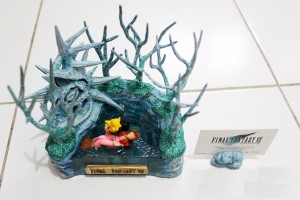
This statue is important to keep in mind, as Square only commissions such sculptures of its games’ romantic pairings, as with this one from the same set, featuring Final Fantasy VIII’s Squall and Rinoa:
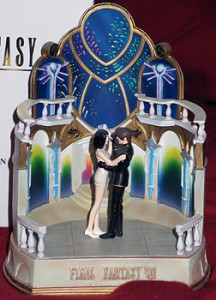
Likewise, take notice of these dioramas made by Banpresto — one of Chrono and Marle from Chrono Trigger, the other featuring Zidane and Dagger from Final Fantasy IX:
There’s also this Square Enix Sculpture Arts diorama of Final Fantasy XII’s Balthier and Fran:

Looking back now to Final Fantasy VII, this Static Arts statuette of Cloud features him standing in Aerith’s church:

While Aerith herself is not present in the sculpt, the floorboards of her church and the flowers representing her are. As with the Cold Cast Collection diorama and the FFVII commercial, a very clear picture is being painted for us: Cloud was in love with Aerith and continues to be surrounded by her presence in her church and in the flower fields associated with her.
Promotional artwork for the game by Yoshitaka Amano, the character designer for the first six Final Fantasy games, also reinforces what we already know. Amano drew no less than five images of Cloud and Aerith together — six if one counts a group shot of he and Aerith alongside Red XIII and Barret:
Not only do several of those images of Cloud and Aerith together look romantic, but Amano drew more images of the two of them together than he did of any other two characters. Furthermore, he didn’t draw any pictures of Tifa and Cloud together at all.
It seems rather clear what idea he was instructed to promote in his illustrations, just as he did with drawings of canon couples from subsequent Final Fantasy games:
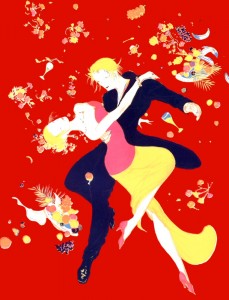
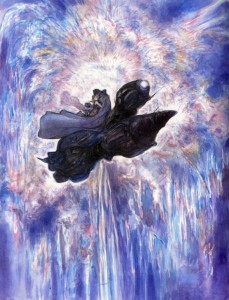
Response:
Starting with the merchandise, the first thing that needs to be pointed out is that the Final Fantasy Cold Cast Collection did not consist only of dioramas featuring romantic pairings. It did not even consist primarily of such a theme.
There were five pieces commissioned in the set — one each for Final Fantasy IV, V, VI, VII and VIII. They featured the following:
●Final Fantasy IV
Cecil as a Paladin fights his Dark Knight persona on Mt. Ordeals
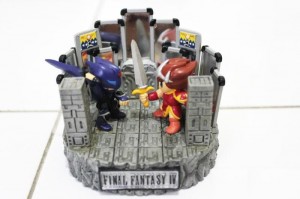
●Final Fantasy V
Bartz and Boco relax by a fire under some trees during the opening of their game
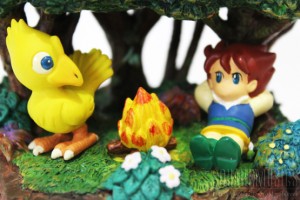
●Final Fantasy VI
Celes performs her role at the Opera House
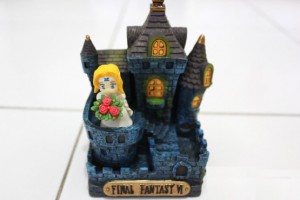
●Final Fantasy VII
Cloud lays Aerith’s body to rest at the Forgotten Capital

●Final Fantasy VIII
Squall and Rinoa dance at the SeeD graduation ball

Of these, only one item in the set features a confirmed couple, established as such during their game. Rather than romantic couples, the dioramas portray memorable scenes from their respective games, and it’s highly questionable whether any of the scenes are actually romantic.
There’s certainly nothing about the first three that would qualify — nor are deaths and funerals particularly romantic, so FFVII’s scene may be out as well. How one has read into that relationship up to that point will do more to determine whether it comes across as such than any component of the scene itself.
Squall and Rinoa’s dance scene at the ball in FFVIII comes closest for consideration, but isn’t particularly romantic either given that the two had only just met, Squall didn’t want to dance with her to begin with, and neither of them yet had romantic feelings for the other in the scene depicted.
Really, nothing about the Cold Cast Collection as a whole — nor the item specific to FFVII from the set — points to the argument made under the “Claim” heading above.
For that matter, it’s simply incorrect that Square only produces sculptures of multiple characters solely to depict romantic couplings. Not only does this not hold true with the Cold Cast Collection, but it doesn’t hold true with the dioramas for Chrono Trigger and Final Fantasy IX either. There are several more pieces that go with both of them to make a complete set.
First, the rest of the Chrono Trigger set, featuring the following dioramas:
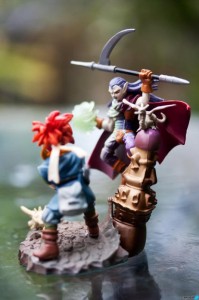
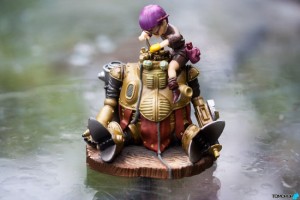
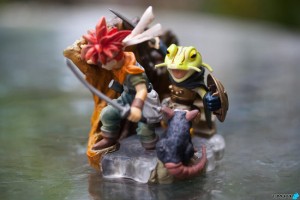
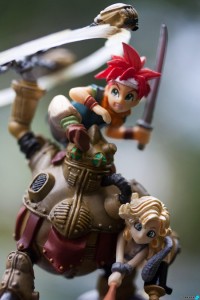
For Final Fantasy IX, there was also a diorama of Zidane with Vivi, and another of Zidane with Steiner:
Along these same lines, a two-item Sculpture Arts set for Advent Children featured matching bases for the sculpts, depicting Cloud’s final showdown with Sephiroth:

As well, these two cold cast statues from the Transcendent Artists Collection for Final Fantasy VIII further conflict with the notion that romance is the key idea at work when multiple characters are present. One sculpture depicts Irvine and Zell with the Guardian Force Diablos; another depicts Selphie and Quistis with Leviathan:
“Most of those sculpts you’ve gone over don’t feature only a single hero and a single heroine,” one might still say. “They couldn’t be meant to allude to a romantic coupling.”
Overlooking how shortsighted that argument based on biology is — particularly given Selphie’s sensual pose in that last sculpture we looked at — it should be pointed out that Banpresto also made three dioramas for Chrono Cross. One features Serge dueling Karsh; another sees Kid do battle with her nemesis, Lynx; and the third features childhood friends Serge and Leena.
See below:
Despite Serge and Leena apparently being boyfriend and girlfriend at the beginning of Chrono Cross, Serge eventually marries Kid, as revealed by this wedding photo in the game’s ending:

Their garb in the picture is identified as wedding attire on the pages of their respective design sketches in the Chrono Cross Missing Pieces book (source scans courtesy of the Chrono Compendium):
(pg. 110)
—
Kid wrapped in a wedding dress. One can’t imagine her usual self having such a cute expression like that seen here.
—Japanese text:
—
ウェディングドレスに身を包んだキッド。普段の彼女からは想像もできないようなしおらしい表情が見物だ。
—(pg. 111)
—
Serge in ceremonial garb. The detailed design also includes accessories.
—Japanese text:
—
礼服をとったセルジュ。アクセサリーにも細かな設定がなされている。
—
If the diorama designers were going for something traditionally romantic, they missed the mark considerably by featuring a pairing that will not last long — if, indeed, Serge and Leena’s status as a couple even outlasts the duration of the game.
For that matter, despite being the central two characters and getting married, a diorama statue featuring Serge and Kid together was never designed. The same is true of Squall and Rinoa with regard to the Transcendent Artists Collection.
Along a similar vein to that just discussed, what of this promotional image for Final Fantasy XIII, depicting Snow and Lightning?:

Not only are these two not romantically involved, Snow is, in fact, engaged to Lightning’s sister.
While this image isn’t a sculpture, it is promotional material — a category merchandise typically falls into as well. Is anything romantic being implied about these two simply by their presence together at the exclusion of anyone else? Is consideration of a wider context (e.g. Snow and Lightning are the two central characters) not called for?
Focusing again on figurines, if intent with them is really as simple as that argued under the “Claim” header above, what are we then to make of a set of figures that portray matching bases for Zack and Aerith at the time of Crisis Core — the base being the floorboards of Aerith’s church and her flowers growing therein no less, as with the Static Arts figure of Cloud examined earlier?
Even more importantly, what then of figures from the same set featuring Cloud and Tifa as they were dressed in FFVII and with matching bases of their own? Reno and Rude — as a single figure representing Before Crisis — even share the same base in this Trading Arts Mini set that was included with official Potion drinks manufactured by Suntory and released in 2007 to celebrate the 10th anniversary of Final Fantasy VII.
All five figures can be seen here, along with a Vincent figure representing Dirge of Cerberus in the set:
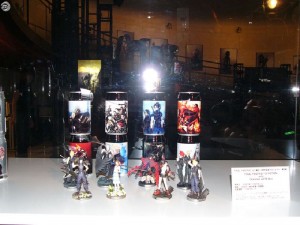
Moving on from the merchandise to the “a love that can never be” commercial, in the event the commercial itself did not make the matter clear enough, the marketing division at Sony Computer Entertainment America wrote the narration, not anyone at Square back in Japan. The purpose of Sony’s ad campaign in North America was to sell the game, not tell the story.
One shouldn’t go looking to the marketing department of another company’s foreign subsidiary for illumination on Final Fantasy VII. If we’re just going to accept third-party material like that, then this bit from Tifa’s profile on pg. 11 of the Official Crisis Core Strategy Guide should also be seen as a rather definitive comment that the higher affection version of the Highwind Scene played out:
—
Tifa meets Cloud in Nibelheim during the events of Crisis Core and their friendship carries over to Tifa has always liked Cloud and enjoys helping him restore his memory when they reunite in Final Fantasy VII. She ultimately lets her feelings be known near the end of Final Fantasy VII and the two can be seen living together during the events of Advent Children and Dirge of Cerberus.
—
There is simply no question whatsoever that the commercials were produced by SCEA rather than Square. Refer to the following Business Wire article from August 27, 1997:
—
PlayStation’s Final Fantasy VII Marketing Blitz Continues
Consumers Gain First Glimpse of the Most Anticipated Videogame of 1997 Through Massive Advertising CampaignFOSTER CITY, Calif.–(BUSINESS WIRE)–August 27, 1997–As part of its marketing program for the most highly anticipated videogame release of the year — Final Fantasy VII, only on PlayStation — Sony Computer Entertainment America recently launched the first television commercial in a high profile three-month long ad campaign.
Featuring three dedicated 30-second spots – highlighting Final Fantasy VII’s movie-like animation and incredible 3D graphics and gameplay — television viewers and PlayStation fans across the country will receive their first sneak peek into the epic adventure experience of Final Fantasy VII. Network television placements include “Saturday Night Live,” “Late Night with Conan O’Brien,” “The Simpsons” and “Prime Time Sports.” Other highlights include buys on cable stations MTV, ESPN, Comedy Central, USA Network, the Sci Fi Channel and E! Entertainment, as well as the syndicated programs “Hercules,” “Baywatch,” “World Championship Wrestling” and “American Gladiators.”
Final Fantasy VII is the epic adventure that will rewrite the rules of videogaming across the world. With hundreds of computer-generated images, aerial views and vivid battle scenes, the game contains mesmerizing visuals equating to a cinematic experience.
“Final Fantasy VII represents a milestone in videogame television advertising with the creation of three separate commercials supporting this phenomenal title,” said Andrew House, vice president, marketing, Sony Computer Entertainment America. “Consumers can count on us to deliver the best with PlayStation, and they are definitely getting that with Final Fantasy VII.”
In addition to the extensive television campaign, the Final Fantasy VII marketing effort also includes a major print campaign in general interest magazines such as Rolling Stone, Details and Spin, and gaming enthusiast publications such as Next Generation, as well as several DC and Marvel comic books. The print campaign, featuring four different ads, will appear in September, October and November issues.
Further supporting the marketing of Final Fantasy VII will be a major holiday promotion with Pepsi and significant consumer sampling through the distribution of one million interactive disks packed in with PlayStation hardware units.
The overall Final Fantasy VII campaign is just a portion of PlayStation brand’s unprecedented $100 million marketing campaign supporting the PlayStation brand and a multitude of other key titles. The entire marketing campaign also includes extensive print advertising, public relations, national promotions, retail promotion merchandising, direct mail, sampler discs and Internet support.
Sony Computer Entertainment America Inc. markets and distributes the PlayStation game console in North America, develops and publishes software for the PlayStation game console, and manages the U.S. third party licensing program. Based in Foster City, Calif., Sony Computer Entertainment America Inc. is a wholly-owned subsidiary of Sony Computer Entertainment Inc.
Visit us on the Web at http://www.playstation.com
CONTACT: Molly Smith, 415/655-6044
or
Chris Kniestedt, 916/441-7606
COPYRIGHT 1997 Business Wire
—
Not only was the commercial not designed by Square, but it’s thick with hyperbole at best and plainly inaccurate information at worst. Here follows the narration for the entire commercial:
“Beyond the edge of reality lies a story of ultimate conquest. A story of war and friendship. A story of a love that can never be … and a hatred that always was. And now, the most anticipated epic adventure of the year … will never come to a theater near you! Final Fantasy VII!”
The very next line after “A story of a love that can never be” is “and a hatred that always was” accompanied by the FMV sequence of Sephiroth standing in the flames of Nibelheim. No matter how one interprets this line, it doesn’t fit the story.
If it’s referring to Cloud’s hate for Sephiroth, it’s inaccurate, because Cloud didn’t always hate Sephiroth — he actually admired him greatly at one point. If it’s referring to Sephiroth’s hatred, it’s still wrong, as Sephiroth didn’t always hate Cloud, Shin-Ra or the human race.
After the line about hatred, the commercial ends with, “And now, the most anticipated epic adventure of the year … will never come to a theater near you! Final Fantasy VII!” The clause about “will never come to a theater near you” aside, the rest of that seems mighty presumptuous a claim in a year that saw “Titanic,” “The Lost World: Jurassic Park,” “Men in Black,” “Tomorrow Never Dies,” “Air Force One” and “The Fifth Element” released to theaters — the first of these films holding the title of highest-grossing film in history for twelve years, and still remaining in one of the top spots even now.
For that matter, championing a description like “a love that can never be” as evidence for a claim that a relationship between Cloud and Aerith was established and continues to develop is more than a little counterintuitive in the first place.
Another of the FFVII commercials released at the time features a similar lack of reliability:
Narration is as follows:
“More than 200 animators and programmers … a multi-million dollar production … over two years in the making … and a cast of thousands. They said it couldn’t be done in a major motion picture. They were right. Final Fantasy VII.”
“A cast of thousands.” Does that sound right? There are only about 50 named characters in the entire game, and though there are certainly a lot of NPCs, the number does not nearly approach even one thousand, much less two thousand — the number necessary for the plural rendering of “thousands” to be accurate.
Even the SCEA commercial for FFVII closest to being accurate is still pretty off the mark:
“An evil empire is sucking the life force from the planet … destroying all that’s in its path. It’s up to one soldier of fortune to save the world. If he succeeds, you survive. If he fails, you can always hit the reset button. Final Fantasy VII.”
With a little poetic license, “evil empire” is accurate enough, and “sucking the life force from the planet” is, of course, entirely correct. “It’s up to one soldier of fortune to save the world,” however?
Soldier of fortune Cloud may be, but he doesn’t save the world all on his own.
While still on the subject of SCEA’s marketing campaign, let’s also look at some of the print ads that appeared in comic books at the same time these commercials were airing. Their hyperbole is right there with that of the commercials.
First, have a look at this shot of Midgar with the caption “It’s to a human what headlights are to a deer,” which appeared in — among other places — “X-Men” vol. 1, issue #69 (November 1997 issue; cover):
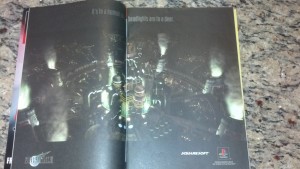
Perhaps not inaccurate, but certainly unverifiable.
More telling is this ad featuring a shot of the Junon cannon and the caption “Someone please get the guys who make cartridge games a cigarette and a blindfold,” which appeared in — again, among other places — “X-Force” vol. 1, issue #72 (December 1997 issue; cover):
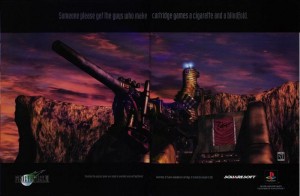
The relevant detail here is the comment below the image of the cannon: “Possibly the greatest game ever made is available only on PlayStation. Good thing. If it were available on cartridge, it’d retail for around $1,200.”
Though cartridges became notorious for their production cost compared to discs, which drove up the prices of catridge-based games, this still seems a little unrealistic.
In either case, have a look at this third print ad, which can be seen in “X-Men” vol. 1, issue #68 (October 1997 issue; cover):
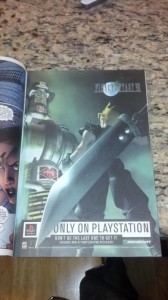
“Don’t be the last one to own it.” Just look at that for a moment and decide whether this sounds like an ad campaign intended to tell a story or sell games.
If the former still seems like a possibility to you, then ask yourself why the Japanese commercials for the same game make no such attempt.
The Japanese FFVII commercials can be seen here, here and here.
None of them allude to anything like that seen in the SCEA commercial of interest. It would be rather odd for Square to not only take an active role in the shaping of the marketing that took place for FFVII in another part of the world, but also to be so determined that a specific element of the plot is conveyed to that audience when they didn’t do so with their domestic audience.
It was SCEA’s job to publish and market the title. The job of the marketing department at SCEA was to coordinate that very marketing of the game, and, thereby, please their shareholders. There’s no evidence that anyone at the Japanese division of Square ever even saw the North American commercial before or during the short time it was on the air, and more doubtful still that FFVII’s core development team saw the ad. Even if they did, it certainly would not have been on the basis of approving it.
A marketing department on the other side of the planet wouldn’t have been showing the commercial to the FFVII development team — who worked for another company — to get their approval on whether it matched the plot they intended. They would have shown it to their bosses at SCEA, gotten a green light, and put it on TV to sell the game. There was no legal impetus to even show the commercial to Square back in Japan.
Does anyone really think they got approval from Japan for those print ads we looked at earlier?
Simply put: The commercial is a commercial. It was an advertisement meant to garner enough interest to sell a product. If it conveyed powerful ideas to those who saw it, such that they expected the product itself to accurately reflect the advertising rather than the other way around, then it was a successful piece of marketing.
Reality is that the final product doesn’t always deliver what the advertising promises.
The first trailer for “Assassin’s Creed,” shown at E3 2006, depicted Altair carrying a crossbow on his back despite him having no such weapon in the final game:
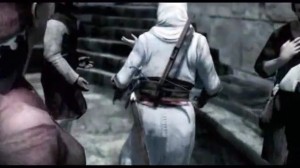
In fact, even the introductory animation to the game proper presented Altair with the crossbow — and even showed him actually using it:
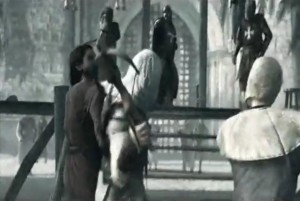
Misleading promotional material isn’t restricted to the world of gaming either. Ryushikaze offers the following analysis of the original theatrical poster to the first “Star Wars” film:
—
Does anyone remember Luke having uberbuff muscles, a metallic leg and holding his lightsaber above his head? What do you mean ‘He doesn’t even use it in the film’? What do you mean ‘normal leg’?”Well, what about Leia’s plunging neckline, heaving bosom and revealed lissom legs? Huh, Carrie Fischer had a modest outfit, modest chest and we didn’t see any leg until “Return of the Jedi”? But the *poster said* …
Now, look at those hundreds of X-Wings swooping in from the distance! What’s that, you say there were 32 rebel vehicles there and a third of them weren’t even X-Wings?
Note again Luke’s bare six-pack chest, the focus on the lightsaber as awesome blade of super importance, Leia’s cleavage and thigh-high dress, and the scores of X-Wings. All of these things are *not* in the movie. X-Wings and lightsaber, yes — so many or so emphasized, no.
If a single poster can lie so much about a two-hour film with a simple and direct story that works entirely on its own merits, just to fill seats, why should we trust a commercial trying to sell us a game?
The original trailer is even better:
“Somewhere in space, this may all be happening right now.
20th Century Fox and George Lucas — the man who brought you ‘American Graffiti’ — now bring you an adventure unlike anything on your planet: ‘Star Wars.’ The story of a boy, a girl and a universe.
It’s a big, sprawling space saga of rebellion and romance. It’s a spectacle light years ahead of its time. It’s an epic of heroes … and villains … and aliens from a thousand worlds.
A billion years in the making — ‘Star Wars.'”
In the *first ten seconds*, it fails at accurately representing the movie’s opening crawl.
At thirty seconds, we’ve been told a lie about the contents of the story: The boy and the girl have little to do with each other, and the story no more invovles the universe than most other space operas — i.e., it’s in one.
“Of rebellion and romance.” Not in “A New Hope,” it isn’t. “Aliens from a thousand worlds.” Pure hyperbole. We don’t even see one thousand people in the entire film. “A billion years in the making.” Enough said.
Even if done in-house, marketing is trying to play fast and loose with the truth and clever language to sell you shit. It is inherently untrustworthy. It is not a standard of truth and should never be taken as such.
—
“But that’s ‘Assassin’s Creed’ and ‘Star Wars,’ not Final Fantasy or Square,” you may say. Very well then. For an example closer to home, let’s go back to the Chrono series and look at what truth there is to find in advertising there.
The cover art for both the North American Super Nintendo and Nintendo DS releases of Chrono Trigger feature an extremely misleading piece of official artwork:
First, and most obviously, Marle is seen here casting a Fire spell. Not only is this not something she can do in either the story or in gameplay, but Fire magic is the domain of Lucca, another playable character — one not even featured in the image in question. The only accurate elements about this presentation of Marle casting magic is that she actually can perform Double Techs with Chrono, and also that there is, indeed, a Fire Sword Double Tech — though it involves Chrono and Lucca rather than Chrono and Marle.
Perhaps as egregious, the artwork features Chrono, Frog and Marle battling the Heckran boss, yet this is a battle that actually takes place in-game involving Chrono, Marle and Lucca. Frog is not even available for the fight.
Furthermore, the battle is seen taking place in this artwork’s presentation outside in a snow-covered landscape. In-game, the battle occurs in the Heckran Cave during the Present-day era of 1,000 AD, which doesn’t feature a snowy landscape anywhere. The only time period in the game to actually do so is 12,000 BC, though the design of the house visible in the artwork’s background is far more similar to those of the houses seen in the Present era rather than the huts found in 12,000 BC.
In other words, this is an example of marketing from Square that largely fails to accurately represent its product in a number of ways.
This is not the only example of box art from the Chrono series to do so either. Let’s now look at the image on the cover of the North American release of Chrono Cross:
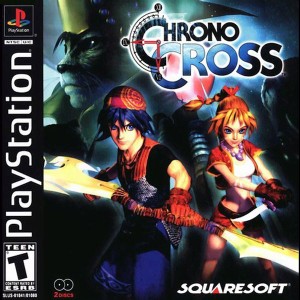
The weapon held by Serge in this image is clearly the Mastermune, but the broad spectrum of colors it boasts is not at all representative of the actual look of the weapon in-game:
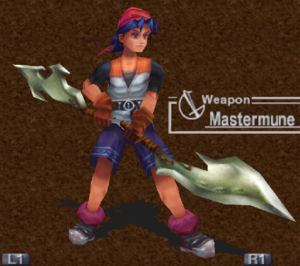
As can be seen, the blades of the weapon are actually monochromatic, while the look of it on the cover art suggests a design that may be a more fitting recipient of the name given to the Spectra Swallow — which, incidentally, looks nothing like either presentation of the Mastermune:
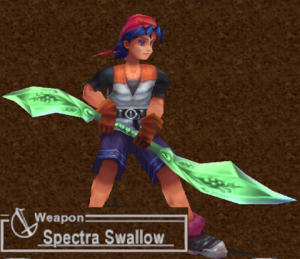
Moving on to examples from Final Fantasy now, consider SCEA’s commercial for Final Fantasy VIII:
“Coming this fall, the most-anticipated action adventure of the year. A story of one man’s struggle to save mankind from extermination, and his quest to win the heart of the woman he loves. An epic so stunning, your emotions will stir … your heart will race … and your thumbs will be really, really sore. Final Fantasy VIII. Coming to a home theater near you.”
Along with the lack of subtlety in reusing multiple elements from the narration heard in the FFVII commercials, SCEA’s commercial for FFVIII brings with it a lot of the same hyperbole and outright inaccuracy.
For example, here we have Final Fantasy once again being billed as “the most-anticipated action adventure of the year.” In a year that saw the release of “Star Wars Episode I: The Phantom Menace,” “The Matrix,” “The Mummy” and “The World is Not Enough” — that seems downright unlikely.
Apparently Squall and Cloud were both solo acts, because this commercial reuses the idea of “one man’s struggle to save mankind from extermination.” It, of course, also brings in the love story angle, though describing it completely inaccurately. Squall doesn’t have any quest to win Rinoa’s heart; she is the one trying to win his heart.
As if all this wasn’t enough, the comment from the commercial about sore thumbs suggests that FFVIII is something more akin to a game like “Street Fighter.” Unless this is supposed to be a reference to using the Boost G.F. ability, the comment completely misrepresents the type of gaming experience one could actually expect out of FFVIII.
SCEA’s ads from that time are simply not the place to look for accurate representations of the games they were advertising.
Not that SCEA is the sole offender in this regard with their Final Fantasy marketing. Japanese Final Fantasy commercials range from misleading to patently absurd.
This commercial for Final Fantasy VI presents Terra seemingly about to attack Tokyo in her Magitek Armor from the beginning of the game. Obvioiusly, that doesn’t happen, nor does the game even take place on Earth.
For the North American release of FFVI (relabeled as “Final Fantasy III”), we got this commercial featuring Mog holding auditions for creatures to appear in the game. It goes without saying that this in no way reflects the actual story of the game. It doesn’t even make sense for that matter, as it depicts Mog rejecting creatures who actually do appear in the game, including the likes of Typhoon and Deathgaze.
When it comes to marketing, Nintendo, Sony Computer Entertainment America or Square itself would — if they thought it would get people to buy the game — do something as ridiculous and unrelated to the actual game as showcase an ostritch running down a beach to the tune of Final Fantasy’s traditional chocobo theme. Or even having an ostritch scream at the camera to the tune of the same.
In fact, Square did just that in not one, but two trailers for Final Fantasy IV.
Consider as well an early trailer for Dissidia Final Fantasy that featured a scene of the Emperor, Garland, Kuja and Ultimecia appearing before Squall and Firion to claim that Cosmos was actually malevolent:
(fan translation of transcript from 1:07 to 1:49)
—
::The Emperor stands before Firion and Squall::
Emperor: “A goddess with dominion over all upon the earth, Cosmos. Is she really one worth believing in?”Firion: “What?”
::Garland begins speaking as the camera pans over to him, having appeared behind the two Warriors of Cosmos::
Garland: “Chaos and Cosmos are destined to fight for eternity. We will battle forever with hope of neither salvation nor future.”::Kuja has now appeared on a pillar above the others::
Kuja: “In short, you are pawns to the whims of gods.”::Ultimecia begins speaking as she teleports in beside the Emperor::
Ultimecia: “When you reach the crystals, you will realize that the true identity of Cosmos is that of a goddess of death who revels in endless bloodbaths!”
—
Whether part of an early idea to reveal Cosmos was less benevolent than she seemed or simply a scheme by that game’s villains to get Cosmos’s warriors to lose faith in her, it is an abandoned sub-plot from the game’s advertising that never made it into the final game — a discarded scene that occupied forty-two seconds of a trailer that was only just over three and a half minutes!
Furthermore, this trailer was released by Square Enix itself rather than a third party who did their own editorializing.
While on the topic of Dissidia, did you choose to fight for Chaos or Cosmos? Were you villain or hero?
You say you only had the option to be on Cosmos’s side? What then of the “What Will You Fight For?” advertising campaign that North America and Europe saw for Dissidia?
Take a look at the official North American Dissidia website. As soon as the site loads, one is immediately greeted with the tagline, as well as presented with it again after the brief animated intro, at which point the site prompts users to “choose your allegiance”:
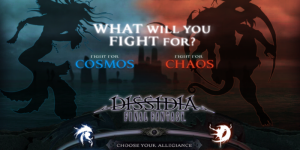
See, too, these wallpapers from the official site:
There’s also the E3 2009 trailer for the game’s North American release (trailer also available on the official website), the final thirty seconds of which proposes “fight for good” and “fight for evil” — each followed by brief clips from cutscenes in the game’s story mode — before asking “What will you fight for?”
Even more relevant, take notice of the back cover for literally any of the North American and PAL releases of the game’s case, which feature “What will you fight for?” prominently. For several examples, see below:
●United States
●United Kingdom
●France
●Italy
Even the back cover of the Dissidia Final Fantasy Official Strategy Guide carries the meaningless tagline, along with this misleading promise to players:
“Ten warriors have been summoned by the goddess Cosmos to do battle with the ten that have been summoned by Chaos. Will the courage, power, and skill of the heroes overcome the forces of darkness? ONLY YOU CAN DECIDE.”
Given that the player simpy cannot fight for any side but harmony in the actual game, is it possible that all this advertising was intended only to sell the product?
For another example of misleading advertising both by Square Enix and even closer to home, consider the early trailers for Advent Children that implied Kadaj, Yazoo and Loz served the “Wheelchair Man” (as he was known among the fandom in pre-release speculation), only for the identity of this figure to be revealed in the film itself as Rufus Shinra, an enemy to the three silver-haired men.
Likewise, what of this promotional image for the Episode:Denzel OVA?:
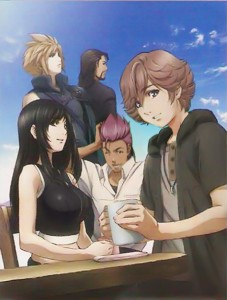
At no point in the short film do all these characters sit down together at a table at Johnny’s Heaven. In fact, Cloud and Tifa do not even appear in any of the present-day scenes from the animation.
On this matter of marketing, the bottom line is this: Advertising is not to be trusted as an accurate representation of a story. It *may* be, but only when verified by other materials. Marketing of a work does not supercede the work itself.
Along those very lines, let us now come round to the subject of Amano’s promotional artwork as it relates — or doesn’t — to Final Fantasy VII.
As it stands today, there are stll only two images of Cloud and Sephiroth together drawn by Amano, one of which didn’t appear until almost 16 years after FFVII’s release as the disc art for FFVII in the FF 25th Anniversary Ultimate Box:
Meanwhile, three images exist of Cloud and Red XIII together — four if one counts the image of the two alongside Barret and Aerith:
If Amano drawing Cloud and Aerith together so many times is supposed to indicate that Cloud is in love with her and his relationship with her is his most significant in the story, then the logical implication of Cloud having more images with Red than anyone but Aerith is — what exactly? That Red is Cloud’s next most significant relationship?
Because I would disagree. I hope that even the most loyal subscribers to this line of reasoning would agree that Cloud’s relationship with Tifa is far more important than his relationship with Red, yet they don’t have even a single image from Amano together. Likewise, I would hope that those supporters of the argument would agree that Cloud’s relationship with Sephiroth is also more important, despite their only getting two pictures from Amano together (only one around the time of the game’s release).
I would even argue that Cloud’s relationship with Barret is more important, but they don’t have any pictures together aside from that group image that also includes Aerith and Red XIII.
Also, what of these two of Aerith and Sephiroth?:
Both have been around since the time of the game’s release. Does this, then, mean that Sephiroth and Aerith’s relationship was more significant than whatever Sephiroth had with Cloud, seeing as Sephiroth and Cloud had only the one drawing together for so many years?
Let’s consider Amano’s art as it relates to Final Fantasy VIII now as well. Squall and Selphie have but a single image from Amano together — yet that is all that Squall and Rinoa have. Furthermore, the name Amano gave to this drawing of Squall and Selphie is “Serenade” (小夜曲 in Japanese kanji; セレナーデ in Japanese katakana) as seen on pg. 122 of the FF 25th Memorial Ultimania Vol. 2:
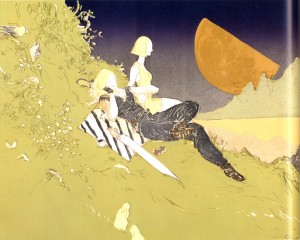
As readers will no doubt be aware, the Italian word “serenade” (also an English loan-word at this point) refers to a musical composition or performance held in someone’s honor, and has traditionally been performed throughout history by a man for his lady love. Given the heavily European influence imbued into FFVIII’s world setting and designs, it is unlikely such a romantic implication would have been lost on Amano were he otherwise thoroughly engrossed in knowledge of the game and *not* wanting to attach romantic implications to this picture of two characters who — in the game proper — have no romantic affiliation whatsoever.
Why give the wrong impression then? Could it just be that Amano draws whatever he feels like — not that he necessarily follows directions given to him meant to convey the story?
In fact, yes. It not only could be the case; it is.
In a feature on Amano published by Kotaku on October 17, 2012, he and interviewer Jason Schreier had the following exchange concerning the way Amano works on character designs:
—
“They’ll come and say we need a character: here’s the age, it’s a boy or a girl, or it’s this kind of personality,” Amano said, “and just the very basic things like in the game it’s a bad guy or a good guy or whatever it is, and I’ll go from there. It’s important for [me] — even though they’ll tell me something — to break away from those elements so you never know what’ll happen. You probably produce your best stuff when you don’t listen.”“Do your bosses get mad?” I asked.
Amano laughed. “No, you just draw another one.”
—
Amano even openly admits here to breaking away from the brief descriptions he is given about characters from their respective stories’ developers. He simply draws whatever he feels like instead.
The Kotaku article goes on to say that Amano sends off what he draws to those who commissioned the work, hoping they’ll just accept most of it regardless of his eccentricities:
—
The designer referred to his work as “just drawing pictures,” which, while more difficult than it sounds, is spot on: he does not create 3D graphics or animate characters. He just sketches designs and sends them off to the team, hoping that “at least 70%” of what he had in mind will show up in the final product.
—
What’s more, during the course of the article, Amano admits to not even actually playing the games he does designs for:
—
Amano seems to be a huge fan of gaming as a form of expression, so I was curious: does he ever play video games?“No,” he said. Back when he was first working on the original Final Fantasy, some 25 years ago, Square would send him games to play, but his kids would just grab them off the counter. Amano’s kids, now 35 and 33, grew up with the games that he drew art for.
“The kids would just take the controllers and start playing,” Amano said, laughing. “I wanted to play, I just never had the opportunity.”
Amano might not have played any of the Final Fantasy games, but it’s hard to disagree with his personal favorite. When I asked if he was particularly proud of his work on any of the Final Fantasy games, he said yes: Final Fantasy VI.
—
It seems likely that Amano knows next to nothing about the games he does promotional art for. Given the focus on Selphie early in FFVIII, if, indeed, he gave the game itself any attention at all, he may have completely misunderstood who the game’s theme of romantic love would revolve around.
While still on FFVIII, Amano drew a number of pictures involving Squall and Seifer; two images of them together as their reflections gleam off one another’s gunblades, then two more of each of them positioned and colored in contrast to one another:
There are six images total either placing Squall and Seifer together or contrasting them to one another. Not only does this make for more images of Squall with any other individual character from his game, but it also makes for as many images of he and that character portrayed in relation to one another as we have pictures of Cloud and Aerith in total drawn together by Amano.
This gives the impression that Squall and Seifer’s rivalry is central to the story, yet — while it is significant early in the game — Seifer is largely irrelevant to the story after Disc 2 (of 4) ends, and Squall remains far more occupied with Rinoa’s well-being than Seifer for the rest of the game.
Following the logic that more pictures of the characters being related to one another entails greater significance to their relationship, however, these images would indicate that Squall’s relationship with Seifer is of utmost significance in FFVIII — even more important than Sephiroth and Cloud’s relation to one another in FFVII.
That is, of course, patently absurd, as is interpreting these stories through Amano’s artwork in the first place. There is no theme in which canon FF couples are given especial attention by Amano in his artwork for a game.
Despite Cecil and Rosa marrying in the ending to FFIV, Amano didn’t make an image of them together until he drew this image to promote the release of FFIV Advance — 14 years later:
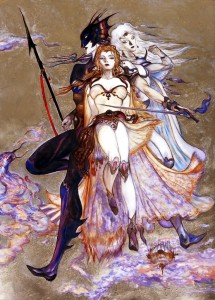
Even then, the image is not overtly romantic in any way and the two have to share the image with Kain, the game’s other main character.
Despite this, Amano had no qualms about drawing — of all people — Seymour and Yuna’s wedding for FFX, and with the two about to kiss at that — even though she was forced into the whole thing:
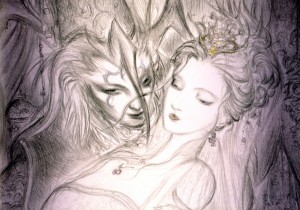
It would be until 2008 and the promotion of FFIV: The After Years that Amano would draw Cecil and Rosa together in an image that is romantic, as the following image depicts them with their son and the two of them in an intimate embrace:
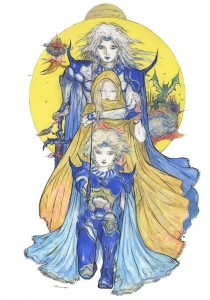
Further driving home the point that Amano’s art is essentially irrelevant, Celes and Locke from FFVI didn’t have a single piece of artwork depicting them together until 2006 in promotion for the release of FFVI Advance, 12 years after the game was originally released — and even then, they had to share the image with the rest of the main cast. Meanwhile, there was an image from Amano depicting Locke with Terra since 1994:
It goes without saying that those latter two have no romantic relationship.
Finally, there’s nothing of Vaan and Penelo from FFXII either, but for their game’s disc art in the FF 25th Anniversary Ultimate Box, Amano did do a drawing of Vaan and Fran together — in fact, the only image Amano did for FFXII of just two characters:
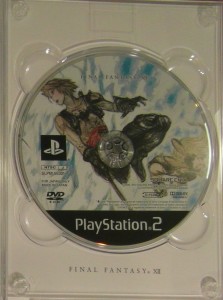
Again, it likely goes without saying that there is no canon romantic couple being depicted here either.
Unless Tifa and Cloud don’t have a meaningful relation to one another, Seifer’s relationship with Squall is more important than his relationship with Rinoa (or Selphie for that matter), Celes and Locke have no relationship to speak of, and Fran is closer to Vaan than Penelo is — it stands to reaosn that Amano’s art does not convey the stories of the Final Fantasy series.
As with all the marketing and promotional material we have examined, the moral of the story remains the same: Advertising is not to be trusted as an accurate representation of a story. It *may* be, but only when verified by other materials. Marketing of a work does not supercede the work itself.
—Claim: In a 2007 issue of Dengeki PlayStation, Tetsuya Nomura made the following comment about Advent Children: “I believe, for those who formerly traveled with her as comrades and for the viewers, each carries their own feelings and loves for Aerith. In this story, Cloud also carries his own undying feeling for Aerith even to this very day.”
Having “undying feelings” for someone usually indicates romantic feelings — and Nomura clearly differentiates Cloud’s feelings for Aerith from that of everyone else in AVALANCHE here.
Furthermore, because this interview was from 2007, after the release of both Advent Children and Dirge of Cerberus, Nomura is trying to tell us that Cloud’s longing for Aerith lasts even beyond the events of those two titles.
Response:
To start off, the quote is actually from the October 24, 2003 issue of Famitsu PS2, per this archive.
Secondly, there’s actually no comparison here between Cloud’s feelings for Aerith and those of the rest of AVALANCHE, nor does the quote even mention Aerith’s comrades on the team. A more accurate translation would be:
“I think that for all those players with whom Aerith traveled as a comrade, each carries their own feelings and love for Aerith. In this story, Cloud also carries his own feeling for Aerith that even now hasn’t died …”
Third, the commonly spread version of the quote seen under the “Claim” marker above also leaves out the last several lines of the quote, which are vital to identifying the “undying feeling” in question. This is the complete quote:
—
I think that for all those players with whom Aerith traveled as a comrade, each carries their own feelings and love for Aerith. In this story, Cloud also carries his own feeling for Aerith that even now hasn’t died …. Its relation to the church scene is …. Yeah. I’ll leave this to everyone’s imagination. (laughs)
—Japanese text:
—
エアリスはかつてともに旅をした仲間で、受け手側の皆さんにも、それぞれの愛情や想いがあると思います。この物語のクラウドも、エアリスに対して、いまもなお 死なぬ想いは あると・・・・。この教会の場面との関係は・・・・・うーん。このあたりは皆さんのご想像におまかせします(笑)。
—
Before proceeding further, I would like to turn to an explanation from hitoshura that breaks down exactly why it’s clear that Nomura’s comment does not mention the rest of AVALANCHE:
—
エアリスは = This marks Aerith as the topic of discussionかつてともに旅をした仲間 = a comrade who once travelled together [with the rest of them]
で = comes from the verb “to be”/”is”, and is conjunctive. It means “[Aerith] is [a comrade who [they] once travelled with], and…,” but in the mistranslation seems to have been taken as “for those who travelled…”
受け手側の皆さんにも = [and…] in/for everyone in the audience too
それぞれの愛情や想いがあると思います = he thinks they each have their own affection and feelings.
この物語のクラウドも、エアリスに対して、いまもなお死なぬ想いはあると・・・・ = [he thinks] that Cloud in this story [Cloud of this story] also has some lingering feelings [feelings that are “not dead even now/still”] towards Aerith…
There is no comparison because the feelings of other characters for Aerith and Cloud’s, because the rest of AVALANCHE are not mentioned. If there is a comparison, it would have to be between Cloud and the audience. But there isn’t a contrast in the Japanese like there is in the translation. There is nothing that would correspond to “his own” in English.
—
This interview also took place well before even the original edition of Advent Children was released. This was only a month after the project’s development had been announced at Tokyo Game Show 2003. Nomura was teasing the eager fans.
He didn’t identify exactly what Cloud’s unique “undying feeling” for Aerith was, but he hinted that it was related to “the church scene.”
So, what is this feeling that’s ultimately given so much attention in the film? Guilt, as we’ve discussed before. In both editions of the movie, the wolf that symbolizes Cloud’s guilt appears in Aerith’s church when Cloud finds Tifa beaten up there, and the FFVII 10th Anniversary Ultimania also refers to Aerith as a symbol of his failures to protect those he cares about (pg. 50; pg. 52 of the Revised Edition) — reproducing Nomura’s comment here point for point, and explicitly identifying “Cloud’s unique feeling” as guilt: “Aerith still lives on in the hearts of her friends who saved the planet. And in particular to Cloud, as a symbol of his failure to … protect those dear to him.”
For that matter, at the time Nomura made his comment about “the church scene,” there had only been *one* church scene shown thus far — the one with Cloud walking down the main aisle of the church in the trailers from TGS 2003’s first, second and third days (three trailers were shown during the event, one each day). In that scene, Cloud can be heard saying, “I think I want to be forgiven. Yeah, I want to be forgiven.”
The only church scene shown to the public at that point — indeed, the only one that existed at the time — was this one featuring Cloud’s desire for atonement.
For reference, let us turn to pg. 13 of the Reunion Files, where Takahiro Sakurai, Cloud’s voice actor, says the following:
—
The first recording I did for this project was for a trailer shown at the Tokyo Game Show 2003. It was only four lines, like “I want to be forgiven,” but it took me over an hour and a half just to get through them (laughs)!
—Japanese text:
—
最初のアフレコは東京ゲームショウ2003トレーラーでしたね。「うん、俺は許されたい」他の、たった4つのセリフだったのに、その収録だけに1時間半以もかかりました。 ええ(笑)。
—
The footage that existed at the time is corroborated by pg. 74 of the Reunion Files:
—
The first time the title and visuals were revealed to the public was at a presentation held during the 2003 Tokyo Game Show (TGS), from September 26 through 28. In fact, the only visuals that existed at this point were this three-minute movie and the secret proto-movie described earlier. In other words, this sneak preview was actually the pilot.
—Japanese text:
—
初めて一般に向けてタイトルとその映像が公開されたのは2003年9月26日~28日の東京ゲームショウ(TGS)の時に行われた制作発表会だった。だが実はこの時点で存 在した映像は、前出の幻のプロトムービー以外、この3分の映像しかなかった。そう、この初公開映像は俗に言う「パイロットフィルム」そのものだったのである。
—
Recollections from Nomura on the same page echo these observations:
—
We decided from the beginning that we wouldn’t use the TGS movie in the final version. It was really just a pilot film. We produced three different versions and played one on each day of the TGS, but made them so that they hardly implied FFVII at all.
—Japanese text:
—
TGSで公開する映像は本編では使わないって最初から決まっていたので、本当にパイロットフィルムという感じでしたね。TGSの3日間、毎日違うバージョンを流して3バー ジョン作りましたが、「VII」のこともほとんど語らない、という感じに仕上げました。
—
Here also are links to all three Tokyo Game Show trailers:
The counterargument has been made, however, that Cloud’s feeling described in Nomura’s quote could not be guilt — mind you, despite no other feeling applying to the church scene from the Tokyo Game Show trailers or even the same scene in the final film — due to it being described as “undying,” whereas Cloud’s guilt is resolved during Advent Children.
This is, quite simply, a misunderstanding of the words taken to be “undying” here. As further explained by hitoshura:
—
A key issue to consider here is the use of いまもなお (“even now”/”still”) in this sentence. There are two ways one can read it. One is to apply “even now”/”still” to “have”/”has” and, thus, read the sentence as “still has [undying feelings].” The other is to apply “still”/”even now” to “not dead” and to read the sentence as Cloud having “feelings that are even now not dead.”There are examples of other phrases using the same structure as this phrase, such as 今もなお消えぬ. Thus, it is a valid reading of the line to take it as “feelings that are still not dead.” This also only frames the statement in the present, and says nothing about the permanence of the feelings.
…
I don’t think they really are “undying.” I think it’s simply saying “feelings that are not dead even now.” In other words, feelings that are still lingering and that remain even now.
In Japanese, there are only really two tenses: past tense and a present/future tense (or “non-past”). I’ve seen it called “complete” and “not complete” as well. “Undying” here would be “non-past” (死なぬ, which is another form of 死なない).
The phrase, for reference:
いまもなお死なぬ想いはある (“still”/”even now”; “not dead”; “feelings”; “have”/”has”)
I have tried using Google to fetch some other examples, but the only results you get for the exact phrase いまもなお死なぬ are this particular quote. So I decided to look at another phrase that has a similar meaning: 今もなお消えぬ (“even now”/”still not disappeared”).
These are some of the results I found:
過去の約束/今もなお消えぬ想い (“promise from the past”/”feelings that still have not disappeared”; the chapter title of a story)
今もなお消えぬ伝説 (“the legend that even now has not disappeared”; someone’s Twitter about something called “Eros Night” or something)
今もなお消えぬ、日本に対する悪意と憎悪 (“the ill will and hatred towards Japan that even now has not disappeared”; from a review of the film “Don’t Cry, Nanking”/”Nanjing 1937”)
今もなお消えぬ情熱 (“the passion that has not disappeared even now”; from a blog about a disgraced sumo wrestler who still wants to wrestle)
今もなお消えぬ記憶 (“memories that even now have not disappeared”; from some lyrics)
今もなお消えぬ想い (“feelings which even now have not disappeared”; from some lyrics)
今もなお消えぬ憎しみ (“hatred that still has not disappeared”; from a “Code Geass” fanfic)
今もなお消えぬ復讐心 (“desire for revenge that has not disappeared even now”; from a description of a story)
今もなお、消えぬトラウマ (“trauma that even now has not disappeared”; from a piece of fan fiction)
今もなお消えぬアイヌ差別 (“discrimination against Ainu which has still not disappeared”; from a news report)
In these examples (though I have quoted only part of the sentences for the sake of brevity), “still”/”even now” appears to apply more to the verb (“not disappeared”) modifying the nouns (feelings/memories/hatred/etc.) than to the main verbs in these sentences. Which leads to me believe that 今もなお消えぬ (and, thus, 今もなお死なぬ) works as a singular phrase.
Taking this into account, it is my proposition that the phrase in Nomura’s quote means that these feelings still linger for Cloud rather than the feelings themselves being “eternal” or such. Nomura starts this sentence with “Cloud in this story as well,” which sets up a time frame. A few uses I saw in my brief research had sentences that expressed the passage of time; that even though a certain amount of time had passed, something has still not disappeared. “This story” that Nomura is talking about is also set several years after the original game, with two years passed since the end of that story. Rather than saying he still has feelings even now that are “undying,” he is instead saying that he has feelings that still remain “not dead.”
Despite the possible ambiguities of the Japanese non-past tense and whether or not it is talking about the present or the future, there would be a number of ways to express that these feelings are not going to die and, therefore, remain forever:
決して死なぬ想い
絶対に死なぬ想い
いつまでも死なぬ想いHowever, those specify that it will “never” or “definitely not” die. This phrase from Nomura’s quote, however, puts us in the present by saying “even now.” It’s not talking about the future, but rather talking about the feelings in the present. It’s talking about what the feelings are doing “even now.” It doesn’t mean that those feelings are going to remain for eternity, as has been argued. It doesn’t negate the interpretation that Nomura might be referring to Cloud’s guilt, which was said not to make sense because Nomura is talking about “undying (=eternal) feelings” and Cloud’s guilt is lifted during Advent Children. Cloud’s guilt is very much “still not dead” in Advent Children.
If you look at the examples I gave above, the pain and trauma in some examples may at some point “disappear.” Some would be beneficial to vanish, like discrimination and hatred, hurt and desire for revenge. There isn’t any way of telling if they will go away or not, but all we’re given is that those emotions remain at this point in time.
I don’t especially feel that Cloud doesn’t have certain feelings or a love for Aerith that will stay with him. But the conclusion I’ve reached from everything that has been released leads me to believe that it’s not something that will remain in a way that would hinder Cloud having a relationship with Tifa, or lead him to continue a “spiritual” relationship with Aerith. And, after consideration, I don’t believe that this quote in particular is talking about any permanent feelings that Cloud harbors.
—
Even if “undying” were the correct reading, however, this word doesn’t apply to only that which is inextinguishable. Vampires and Elves are frequently portrayed in fiction as undying (i.e. as time progresses, they are not in a constant state of eventual decay like humans), but can be killed through the correct means. The race from FFXII called the Undying, as well as the same game’s final boss, are likewise — undying, yet can also be killed.
That which is undying is only so until it has died. For examples within Final Fantasy, one need look no further than the aforementioned last boss of FFXII. The form Vayne takes when he fuses with Venat’s power is called “The Undying” — and not just in the English translation.
The Japanese name for this boss is 不滅なるもの — “that which/he who is undying.” The Occuria of the same game are also referred to in both languages as “the undying” (不滅なる神; “kami who are undying”) but they very much can be killed, as Venat kindly demonstrates.
For that matter, if one wants to make the case this feeling being described isn’t guilt, they’re still going to have to attempt divorcing that quote from its full context (i.e. the sentences that immediately follow): “Its relation to the church scene is…. Yeah. I’ll leave this to everyone’s imagination. (laughs)”
In any case, if Nomura was talking about something that goes beyond Advent Children, you have to wonder why he would use “in this story” to describe the feeling and then relate that feeling to a specific scene in the trailer where Cloud speaks of wanting forgiveness. The point becomes all the more clear when you look at the finished work and find in that scene a manifestation of Cloud’s guilt, bearing in mind such things as Aerith’s 10th Anniversary Ultimania profile (pg. 50; pg. 52 of the Revised Edition) saying that, at the time of Advent Children, Aerith was the symbol of Cloud’s regrets.
Added to that, the character association chart in the same book (pg. 121; pg. 123 of the Revised Edition) has an arrow running from Cloud to Aerith that says “sense of guilt” (罪の意識). While guilt certainly isn’t all that he felt for her, and while he may indeed carry an especial fondness for her all through his life, it only stands to reason that in this particular quote about Advent Children, Nomura was referring to Cloud’s guilt. That’s what the whole film centers around: his struggles with his guilt and coming to terms with himself.
—Claim: To some, Aerith’s death is the end of the love triangle. She and Tifa both want Cloud. Maybe Cloud is attracted to both of them. Then Aerith dies and his only remaining option is Tifa.
But what if that’s not the case?
In the real world, it would be. But this is Final Fantasy and the “fantasy” in the title is important to keep in mind.
Even more importantly, this is Final Fantasy VII, where the rules for life, death and what falls in between are even less rigid than they are in most FF titles. In FFVII, we learn that death is not the end of life; it is but another phase in the cycle of life. The body dies, but the spirit lives on — and may even be seen again.
FFVII’s metaphysics are quite similar to that of Final Fantasy X and X-2, where the dead who had a strong will and were attached to the living world by a powerful emotion could bind themselves to the living world and persist. These “unsent” as they are called are essentially the same as Sephiroth, whose hatred for Cloud and humanity allowed him to cheat death not once, but twice.
But who else may they be similar to that we find in FFVII’s world? Who else has died and continued to interact with the living world at times? Aerith herself, of course.
Not only does Aerith’s status as a Cetra mean that her spirit doesn’t have to diffuse into the Lifestream, but she also has a powerful emotion keeping her tethered to the living world: her love for Cloud.
We are assured on pg. 151 of the FFVII Ultimania Omega that death need not be the end for Cloud and Aerith’s love:
—
Cait Sith No. 1’s Final Divination
Since he had another body, Cait Sith undertook the unsealing puzzle, but predicted Cloud and Aerith’s compatibility first. The result was “Aerith’s star and Cloud’s star! They show a great future!” With knowledge of the story’s later developments, the prediction becomes tragic, but if the meaning of “future” is taken from another angle, hope can still be perceived … perhaps.[Screenshot caption]
Cait Sith’s line that seems to anticipate Cloud and Aerith’s wedding arouses further sadness.
—Japanese text:
—
ケット・シー初号機最後の占い
かわりのボディがあるからと言ってパズルの解除を引き受けたケット・シーは、最後にクラウドとエアリスの相性を占う。結果は「エアリスさんの星とクラウドさん の星!すてき な未来が約束されてます!」とのこと。その後のの物語の展開を知っていると悲しくなる占いだが、別の角度から「未来」の意味をとらえれば、希望が見えてくる… …かもしれな い。[Screenshot caption]
クラウドとエアリスの結婚式を期待するようなケット・シーのセリフが、ますますせつなさをかき立てる。
—
Cait Sith predicted Cloud and Aerith would get married, and while some would be quick to claim that he was wrong because of Aerith’s sudden death, we are told here that hope lives on. For that matter, even after she has died, Aerith still thinks that she may be able to properly convey her feelings to Cloud and for them to become lovers and a family, as shown in Maiden Who Travels the Planet on pg. 579 of the FFVII Ultimania Omega:
(translation by LHYeung/Xcomp)
—
Maybe she could be clear about her affections towards Cloud here. Then maybe they would be seen as family or lovers… During her lifetime in Midgar, she felt many souls of the ones that tried to confess their love. Those that still had those feelings or had those feelings left behind them could strongly retain their consciousness as a “whole.”
—Japanese text:
—
クラウドへの未練が、自分を”はっきり”させている のかも知れない。そうやって家族や恋人にひと目会おうと—愛していたと告げようと遠い地で死んだ人の魂がやってくるのを、のをミッドガルでの生活の間に彼女は 何度か感じ ていた。残した想いと、残された人の想いが、゛個゛の意識を強く保つことがあるのだと。
—
We also know that Cait Sith’s predictions carry some validity because of a certain other prediction he had for Cloud, per pg. 120 of the FFVII Ultimania Omega:
—
Divination With Profound Meaning
Cait Sith’s predictions of Sephiroth’s whereabouts result in 3 outcomes. Disregarding the first two, in order to deceive the party, the third prediction becomes an excuse for Cait Sith to follow them ― he says, “What you pursue will be yours. But you will lose something dear.” When the story progresses to the Forgotten Capital, “you will lose something dear” seems to refer to the loss of Aerith, but when it advances to the Great Northern Cave, it can be thought of as the breakdown of Cloud’s sense of self.[Screenshot caption]
Is it just something he thought up as an excuse to join the group?
—Japanese text:
—
意味深な占い
セフィロスの行方に関するケット・シーの占いの結果は3つ。最初のふたつはともかく、引っかかるのは、ケット・シーが一行についていくきっかけとなった3つ目 の占い――「 求めれば必ず会えます。しかし最も大切なものを失います」というものだ。忘らるる都まで物語を進めれば、「最も大切なものを失います」とはエアリスを失うこと だったとも思 えるし、さらに大空洞まで進めれば、クラウドが自我崩壊に至ることを示唆していたとも受け取れる。[Screenshot caption]
それとも単に、仲間に加わる口実をひねり出すためのもの?
—
Added to that, Cait Sith’s profile on pg. 61 of the FFVII Ultimania Omega (pg. 63 of the Revised Edition) tells us that, despite being a Shin-Ra spy, his claims of being a fortune-teller aren’t entirely false — and even points out that he predicted some things with great accuracy in Before Crisis:
(translation by Quexinos)
—
This fortune-telling machine’s reputation is not just for show!
Cait Sith’s fortune telling compilationIn FFVII, Cait Sith ambushes Cloud and co., introducing himself with “I’m a fortune telling machine.” Fortune telling is originally Cait Sith’s special skill, so this may not be a complete lie. Although the things he says in FFVII are random, in BC, he shows extraordinary skill, pinpointing the place of destination exactly.
—Japanese text:
—
占いマシーンの名はダテじゃないケット・シーの占い集
『FFVII』でケット・シーは、クラウドたちをゴールドソーサーで待ち伏せし、「自分はここの占いマシーンだ」と自己紹介する。これは真っ赤なウンというわ けではなく、 占いはもともとケット・シーの特技。『FFVII』ではテキトーなことも言うが、『BC』では目的地をピタリと当てるなど、並々ならぬ腕前を見せる。
—
As can be seen here, death was never the end for Cloud and Aerith’s growing love. Even at the end of Advent Children, we see him out searching for Aerith and finding her waiting for him in a field of flowers.
Her love for him is so great, in fact, that rather than being confined to the Lifestream, her spirit resides within Cloud himself — perhaps by virtue of all the extra Lifestream his body has absorbed over the years from mako infusion and more than one fall into the planet. We know this because Tetsuya Nomura plainly says so in The Distance making-of featurette for Advent Children:
(official English translation):
—
The words “memetic legacy” are used a lot in the film, but in Advent Children, rather than focusing on memories we wanted to show that consciousness is what lives on. We took the ending of the game and expanded on that idea. Even if they’re dead, their consciousness is still with us. As for Cloud, he sees Aerith several times throughout the film. It’s not that he sees her because he feels her presence. He sees her because her consciousness lives on inside him.
—
Perhaps this is why only Cloud is able to see and hear Aerith in Advent Children.
As is plain to see, death was not the end for Cloud and Aerith. It was simply a new beginning.
Response:
To begin with, Cait Sith is hardly a reliable source for anything related to divinating the future. Yes, as a literary device, his prediction that Cloud would lose something dear proved to be foreshadowing — but as an authentic oracle within the fictional world he inhabits he falls far short. His profiles in official guidebooks tend to point out that the things he predicts are random nonsense and that he only pretended to be a fortune teller in order to get close to AVALANCHE:
(pg. 41 of the FFVII Ultimania Omega)
—
Fortune-telling ability?
Cait Sith, a self-proclaimed fortune-telling machine, occasionally makes predictions, such as divining Sephiroth’s whereabouts when he joins the party, the journey’s outlook, Cloud and Aerith’s compatability, etc. However, he’s almost always off the mark, and the ability is dubious.[Screenshot caption]
It seems that something like a fortune slip is printed out and interpreted …
—Japanese text:
—
占いの腕前は?
自称占いマシーンのケット・シーは、仲間に加わるときにセフィロスの居場所を占うほか、冒険の展望やクラウドとエアリスの相性など、ちょくちょく占いをしてい る。もっとも 、それが当たることはほとんどなく、その腕前は怪しいもの。[Screenshot caption]
おみくじのようなものを振り出して占っているようだが……。
—(pg. 60 of the FFVII 10th Anniversary Ultimania; pg. 62 of the Revised Edition)
—
Pretending to be a fortune-telling machine based at the Gold Saucer, he says he wants to “see what it leads to” and strongarms his way close to Cloud.
—Japanese text:
—
ゴールドサーサーに設置された占いマシーンだと偽り、「運勢を見る」と言って強引にクラウドに接近する。
—
Even the passage from Cait Sith’s profile in the FFVII 10th Anniversary Ultimania that says his fortune-telling is “not just for show” points out that the things he said in FFVII were nonsense and that it is only in Before Crisis that he seems to demonstrate any measure of profound ability.
Of course, as anyone familiar with Episode 20 of Before Crisis will know, Reeve and Veld were old friends. Veld had been researching the support materia the Turks were seeking and even shows up at the reactor in Gongaga to assist in securing it. It’s likely that Reeve had learned of the support materia’s location from Veld and been asked to assist the Turks.
As well, Cait Sith’s knowledge of the layout inside the reactor isn’t unexpeccted of the Shin-Ra executive in charge of urban development.
There was no clairvoyance at work here. Simply the exchange of information and a request between friends, as well as the knowledge you would expect a company executive to have of his organization’s most valuable resources.
We’re not actually dealing with a magical fairy cat riding a toy Moogle that he magically brought to life. We’re dealing with an animatronic cat riding atop an animatronic Moogle, both of which are being operated via remote control by a businessman in a suit back at Shin-Ra headquarters.
For that matter, if Cait Sith’s operator, Reeve, was a legitimate oracle, one would think he might have more clearly predicted the death of the woman who asked him to determine her compatability with Cloud only a short time before her murder. That would have been much more useful information.
Even if he could or should be given any deference as one able to predict such things as compatability between people, he would have been “reading the stars” while Cloud was still in the thick of his false, composite personality. Cait Sith — which, again, is to say Reeve — never did anything like this for the two of them after Cloud’s true persona was restored, and certainly not while Cloud was in his proper state and Aerith also still alive.
Lest we forget, by the way, Aerith does not actually ponder whether she and Cloud can still become lovers after her death. The most commonly known translation of that passage from Maiden Who Travels the Planet is mistaken. As hitoshura explains:
—
-“Maybe she could be clear about her affections towards Cloud here.”
Maybe her attachment to Cloud is keeping her “clear” (i.e. “solid”).クラウドへの = ~towards Cloud
未練が = lingering attachment (towards something) [which is the agent of the following verb shown by the が]
自分を = herself [which is the object of the verb as indicated by the を]
”はっきり”させている = to be made ‘clear’ (as opposed to the other souls in the Lifestream)
のかも知れない = maybe, perhaps-“Then maybe they would be seen as family or lovers…”
The problem here is that this is part of a much longer sentence (the rest of this quote is all one sentence), which has been split up and misconstrued.そうやって = in that way (having lingering attachments to the world)
家族や恋人に = family and lovers (and others) [which is the subject/target of the following verb shown by the に]
ひと目会おうと— = to see once more [~よう(おう)と meaning something they are trying to do, and the dash leave it trailing and connects it with the next line]-“During her lifetime in Midgar, she felt many souls of the ones that tried to confess their love.”
The first part is fine (up to ‘many souls’), but it’s the end where it loses it. Which happens to be the beginning of the Japanese sentence.愛していた = was in love with, did love, loved
と告げようと = try to tell [family/lovers/etc.] [the first と showing what they were to say/tell, the stuff before it, and the second と being to show they were trying to do something as with above]
遠い地で = in distant lands
死んだ人の魂が = souls of people who died [in distant lands] [が again]
やってくる = arriving [coming to the place she was]
のを = [のを making this whole lot that has come before into the subject of the sentence’s final verb]
ミッドガルでの生活の間に = during her life in Midgar/while living in Midgar
彼女は何度か感じていた = she had felt/sensed numerous times [the thing that was marked with のを]Put into a more readable English rendition, it could be something like this:
“Numerous times during her life in Midgar she had sensed the souls of people who had died in distant lands coming to try to see their family or lovers one last time — to tell them that they loved them.”
—
Moving now to this matter of Aerith’s spirit residing within Cloud, that is simply not the case and no reading of the material will ever support otherwise.
As both Maiden Who Travels the Planet and Lifestream White from Kazushige Nojima’s On the Way to a Smile series of novellas plainly present, Aerith was within the Lifestream — the great swell of spirit energy within the planet’s mantle. Not within Cloud.
Aerith even encounters Sephiroth’s spirit and the spirits of other Cetra during this time. Unless all of them also reside within Cloud, she simply does not — and if they all actually do, that would instantly eliminate any unique, special quality to Aerith herself being there.
We’re also told on pg. 131 of the FFVII 10th Anniversary Ultimania (pg. 133 of the Revised Edition) that, at the end of Advent Children, Aerith and Zack return to the Lifestream — not to within Cloud:
(translation by hitoshura)
—
The place where he awakens —
That is Cloud’s Promised LandAs he sleeps, Cloud hears two voices. The voices of two people very dear to him, who are no longer with him. Playfully and kindly, they give him a message: he doesn’t belong here yet.
When he awakes, there was his friends. There were the children, freed from their fatal illness. Tifa and Marlene, and Denzel asking for Cloud to heal his Geostigma — his family were waiting. Engulfed in celebration, he realises where he is meant to live. He realises that he was able to forgive himself.
And when he turns around — ‘she’ is starting to leave. Together with the friend who had given Cloud his life. Cloud no longer has to suffer in loneliness… And so they too go back to where they belong.
Back to the current of life flowing around the planet —.
—Japanese text:
—
覚醒を迎える場所――
それはクラウドの約朿の地眠るクラウドは、声を聞く。彼の大切、もういなくなってしまったふたりの声。彼らは楽しげに、いたわるようにクラウドに告げる。ここはまだ、彼の居場所ではな いのだと。
目覚めると、そこには仲間だいた。死の病から解き放たれた子どもたちがいた。ティファとマリンと、彼の手で星痕を治してもらおうと願うデンゼルが――家族が待 っていた。祝 福に包まれ、彼は生きるべき場所を知る。自分を許すことができたのだと知る。
そして、振り向くと――”彼女”が立ち去ろうとしている。クラウドに命をくれた友とともに。もうクラウドは、孤独に苦しまずにすむ……だから彼らも、還るべき ところへ。
星をめぐる生命の流れのなかへ――。
—
The point is even made that they have gone where they belong while Cloud remains where he belongs. Put simply: Cloud and Aerith were separated by death and they will not be spending casual time together, much less getting married.
Aerith’s death carries with it real and valuable consequences, regardless of whether death can be transcended in FFVII’s world. It is not the natural order of things — nor was it on FFX’s world, for that matter (Auron: “Leave Spira to the living”) — and not something Aerith would seek to do save in order to address a crisis to the living world.
As Lifestream White shows, Aerith didn’t spend all her time in the Lifestream after Meteorfall thinking about Cloud and how to get back to him. She only took concern of him again after realizing that Sephiroth’s lingering malice had targeted the surface and made use of his hatred for Cloud as his tether to the world. Furthermore, she only attempted to interact with the living world (i.e. Cloud) in the first place in order to address Sephiroth’s defilement of the Lifestream and the surface world. As a ghost, he had no more business there than she, and his ongoing infection of the Lifestream required Cloud help her on the surface.
It was only after attempting to make contact with Cloud that she would discover that he needed her help as much as she needed his.
While on the topic of Aerith’s spirit dwelling within Cloud, what Nomura actually said in Japanese during the Distance interview was nothing of the sort. As explained by hitoshura:
—
死んでも意識というものがいつまでも残っている。クラウドがACの本編中に何度もエアリスの姿を見ているんですけど、その意識を、死んだ人の命を感じているか ら見えている というか。そこにその意識があると言うよりは、生きている人の中にその意識があるからそこに見えているというか。死んでも意識というものがいつまでも残っている
“Even if they’re dead, their consciousness is still with us.”クラウドがACの本編中に何度もエアリスの姿を見ているんですけど、その意識を、死んだ人の命を感じているから見えているというか
“As for Cloud, he sees Aerith several times throughout the film. It’s not that he sees her because he feels her presence.”そこにその意識があると言うよりは、生きている人の中にその意識があるからそこに見えているというか。
“He sees her because her consciousness lives on inside him.”生きている = is living
人 = person(s)
生きている人 = person who is livingUnless “person who is living” is Nomura’s epithet for Cloud, yar, it be not what he literally says. Of course it would *include* Cloud, but not as the “they’re super special” way people have made it out to be.
—
Explaining in further detail, Nomura’s point here was not to make some remark on the special relationship Cloud and Aerith have. He’s doing the opposite of that and making a remark about the relationship all people have — specifically, the dead with the living. He uses Cloud and Aerith as a single example of a universal situation.
A more accurate take on Nomura’s block of text would be:
“Even though they’re dead, the consciousness remains forever. Cloud sees Aerith several times in Advent Children, though rather than seeing her consciousness because he is sensing the essence of a dead person, he sees her because the consciousness is within a person who is living.”
Nomura doesn’t say that Aerith’s spirit dwells within Cloud’s body rather than in the Lifestream. He’s saying that the dead become part of us and live on through us — as both Aerith and Zack are shown to live on through Cloud during Advent Children Complete, where he interacts with their both consciousnesses. Zack called Cloud “the proof that I existed”/ “my living legacy” for a reason.
Put more simply, what Nomura said was just a fancy way of saying that the dead are never truly gone.
Now, on to the matter of Cloud supposedly going to see Aerith in the flowerfields during Advent Children’s credits.
It first bears pointing out that Cloud isn’t the only one able to see and hear Aerith during the film. She seems to allow whoever she wishes to take notice of her. Kadaj speaks with her, sees her and raises his hand to grasp hers as he is dying. Meanwhile, Cloud, who is right next to him, seems unable to see or hear her at that time.
Added to that, two children in the following scene from the church at the film’s end appear to be talking with her — the one on the right even raises his hand to wave bye to her as she gets up to leave:

Furthermore, both Marlene and Tifa sense Aerith’s presence in the latter half of the film. Marlene does so as Cloud’s battle with Sephiroth begins and Tifa after Cloud has vanquished Sephiroth once more.
And we haven’t even yet taken account of the fact that Aerith calls every phone in Edge to tell them to head to her old church, where Cloud is healed after his battle with Sephiroth.
Don’t forget these details, but — for the sake of argument — let’s never mind them for the moment. Let’s also never mind that Reminiscence of Final Fantasy VII plainly shows that the footage from Advent Children’s credits applies to Cloud out working, performing his delivery service rather than looking for Aerith. We’ll even overlook that if Aerith’s spirit actually dwelled within Cloud’s body, he wouldn’t need to go looking for her nor arrange a romantic rendezvous out in the middle of nowhere.
Look instead at the fact that, to begin with, Cloud doesn’t even stop his bike when the image of Aerith shows up during the credits of the original version of Advent Children. He simply rides on around the bend. Were she actually there, he apparently didn’t see her, so it matters little. He certainly didn’t hit the brakes.
More to the point, the apparition that appears in the credits may not even actually be Aerith’s spirit. Based on the official script of the film included with its Limited Edition North American release (a translation of the same script included in the Advent Pieces Limited set exclusive to Japan), the intention of the filmmakers seems to have been that she wasn’t really there:
—
Vestiges of Aerith (nothing with any presence in reality) silently watch Cloud as he rides away. Aerith looks a little lonely, but then she smiles.
—
It may be pointed out, however, that there are other parts of the script that don’t entirely coincide with what ended up on-screen in the finished film. Most notably, this description of events during Cloud’s confrontation with Kadaj in Aerith’s church differs from the events seen in the film:
—
As though it had a will of its own, the water reaches the walls and begins to climb. As the water reaches the rafters it comes pouring down like rain, soaking Cloud as well. Cloud’s left arm glows with a pale light as the geostigma begins to heal. While Cloud watches this happen to his arm, Kadaj destroys the wall near the rafters and escapes. Cloud ignores this and gazes at Aerith’s flower bed. He sees Aerith’s figure through the misty spray.
—
Along similar lines, one might argue that Aerith doesn’t appear particularly sad or lonely at any point during her brief appearance in the credits. Nonetheless, this passage from the official script remains the only direct statement we have concerning the nature of this image of Aerith and is one of the only two indications we have of the authorial intent regarding the appearance.
The other indication, of course, being that Aerith appears nowhere in the credits of Advent Children Complete, the more current — and, thus, canon — version of the film. All footage of Cloud riding around the world remains, however. Only the appearance of Aerith was removed.
Before moving on, the fact that Aerith’s hair blows in the wind during the credits has also been brought up to argue that she was actually present. This would not be the last time that a similar scene would appear in a Final Fantasy game, however.
At the end of Report 20, An End to Conflict, what amounts to the final chronological scene of Dissidia 012 — taking place as it does after the game’s primary ending — Cosmos fondly reminiscences about her warrriors who defeated Chaos and saved the multiverse. As she does so, “vestiges” of them appear — and though they are “nothing with any presence in reality,” their hair and clothing seem to sway to a gentle wind (this is most noticeable with the Warrior of Light).
Finally, it bears pointing out that even the notion that Aerith could continue to have a relationship with Cloud in the living world runs counter to what Nomura and Kitase have — in no less than three interviews — explained they were trying to achieve with her death.
The first of these is found on pp. 112–113 in the May 2003 issue of Edge magazine (issue #123):
—
Death of a friend
Easily the most infamous and memorable character in FFVII was neither the main lead nor the central antagonist, although both Cloud and Sephiroth are premier examples of excellent design and characterisation, but rather a flower seller who appears for little more than a third of the game.Tetsuya Nomura, character designer, conceived both the characters of Sephiroth and Aerith. “The main issues of contention for fans worldwide are still Aerith’s death and the ending sequence with Sephiroth. With the plot I wanted people to feel something intense, to understand something. Back at the time we were designing the game I was frustrated with the perennial dramatic cliché where the protagonist loves someone very much and so has to sacrifice himself and die in a dramatic fashion in order to express that love. We found this was the case in both games and movies, both eastern and western. But I wanted to say something different, something realistic. I mean is it right to set such an example to people?”
Kitase-san is adamant that cultural art puts too high a value on the dramatically meaningful death. “In the real world things are very different. You just need to look around you. Nobody wants to die that way. People die of disease and accident. Death comes suddenly and there is no notion of good or bad attached to it. It leaves, not a dramatic feeling but a great emptiness. When you lose someone you loved very much you feel this big empty space and think, ‘If I had known this was coming I would have done things differently.’ These are the feelings I wanted to arouse in the players with Aerith’s death relatively early in the game. Feelings of reality and not Hollywood.”
Classic convention
At the time of release the Internet was awash with rumours that it was possible to resurrect Aerith. Edge wonders if this was ever the developer’s intention? “The world was expecting us to bring her back to life, as this is the classic convention. But we did not. We had decided this from the beginning. There was a lot of reaction from Japanese users. Some of them were very sad about it while others were angry. We even received a lengthy petition addressed to our scenario writer asking for Aerith’s revival. But there are many meanings in Aerith’s death and that could never happen.”
—
The second interview was on pg. 104 in the October 2005 issue of Electronic Gaming Monthly (issue #196):
—
EGM: We heard that the death of Aerith and the creation of Tifa both originated in a phone call between you two….Nomura: It’s funny, some magazine ran that story, but only the beginning and ending of it. People think that I wanted to kill off Aerith and replace her with Tifa as the main character! [Laughs] The actual conversation between Mr. Kitase and myself was very, very long. Originally, there were only going to be three characters in the entire game: Cloud, Barrett, and Aerith. Can you imagine that? And we knew even in the early concept stage that one character would have to die. But we only had three to choose from. I mean, Cloud’s the main character, so you can’t really kill him. And Barrett…well, that’s maybe too obvious. But we had to pick between Aerith and Barrett. We debated this for a long time, but in the end decided to sacrifice Aerith.
EGM: Did you pick her to increase the drama?
Nomura: In the previous FF games, it became almost a signature theme for one character to sacrifice him or herself, and often it was a similar character type from game to game, kind of a brave, last-man-standing, Barrett-type character. So everyone expected that. And I think that death should be something sudden and unexpected, and Aerith’s death seemed more natural and realistic. Now, when I reflect on Final Fantasy VII, the fact that fans were so offended by her sudden death probably means that we were successful with her character. If fans had simply accepted her death, that would have meant she wasn’t an effective character.
—
Finally, these sentiments are echoed once again by Kitase and Nomura in this interview on pp. 11–12 of the FFVII 10th Anniversary Ultimania (original and Revised Edition):
(translation by hitoshura)
—
Feelings about Aerith, the tragic heroine
—You can’t talk about FFVII’s heroines without talking about the tragedy that befalls Aerith at the Forgotten City. That event was a very memorable scene not only for the FF series, but all RPGs.
Kitase: In the past FFs as well, important characters died and went away. Like Galuf in FFV for example, they followed a pattern where the character would go down after giving it his all in a fight. In this case, often it went that the characters think something like, “They’ve tried so hard,” and just accept the death and overcome it. When creating stories I think that is an option, but in FFVII we were thinking, could we take this a step further? Bring out a sense of loss somehow? What I didn’t want to have was the kind of story development where even when a character dies there’s no sense of loss; on the contrary it just raises motivation and pushes you forward.Nojima: Kitase’s loss talk has been consistent since back then.
Kitase: And with a lot of stories, before they die there’s a lot of dramatic preparations, aren’t there? Like a “pre-prepared excitement,” or “using this as a step to fight evil further”; those are the kinds of developments I wanted to avoid. In reality, death comes without warning, and you’re left feeling dazed at the gravity of the loss … Rather than wanting to fight evil, you’re just overcome by a great sense of loss, like you just want to give up everything. I was in charge of the direction of that scene and I tried to bring out that sort of sense of realism.
Nomura: It’s related to “life,” one of the themes of FFVII, so it’s not portrayed as a “death for excitement’s sake,” but expresses a realistic pain. Death comes suddenly, so I think the emotion there wasn’t excitement or anything, but sadness.
Nojima: Speaking from a scenario standpoint, FFVII is “a story of life cycling through the planet,” so someone needed to be part of that cycle. In other words, although what happened to Aerith isn’t really based on logic, as far as the story goes, maybe one of the team was destined to lose their life from the very start. But how that one became Aerith wasn’t decided through a notice as is popularly mentioned. It was decided after everyone, including myself, racked our brains about what to do.
—Japanese text:
—
悲劇のヒロイン
エアリスをめぐる思い
――『FFVII』のヒロインの話をするうえで避けて通れないのが、忘らるる都でエアリスを襲う悲劇です。あのイベントは、『FF』シリーズにかぎらず、すべて のRPGの なかでも極めて印象に残る展開でした。
北瀬 過去の『FF』でも、重要なキャラクターが死んだりなくなったりすることはありましたよね。たとえば、『FFV』のガラフのように、戦いで全力を出し切 って倒れると いったパターンがそれです。そういう場合、「これだけだんばったんだから」みたいに、キャラクターが死ぬのを素直に受け入れて、そこを乗り越えていくような流 れになってい ることが多かった。物語の作りかたとしては、それはそれでアリだとは思うんですけど、『FFVII』ではもう一歩踏みこんだ表覡として、なんとかして喪失感を 出せないか、 ということを考えていたんです。ひとりのキャラクターが死にながらも、喪失感も何もなく、むしろモチベーションが上がった状態でつぎへ進むような展開はやりた くなかった。
野島 北瀬さんの喪失感の話は、当時から一貫してましたね。
北瀬 しかも、多くの乍品では、死ぬ前からいろいろと演出的な準備がされていくじゃないですか。”用意された感動”というか、「これをステップにして、さらに 悪と戦うんだ 」みたいな流れになるのは避けたかったんです。実際には、人の死って予告なしに訪れて、失ったものの大きさに放心状態となってしまう……悪と戦うどころではな くて、すべて を投げ出したくなるような、大きな喪失感に襲われるだろう、と。あのイベントの演出は僕が担当しましたが、そういう現実的な感覚が出せるように気をつけていま したね。
野村 『FFVII』のテームのひとつである「命」と関わりのあることなので、”感動のための死”という描きかたではなく、リアルな痛みとして表現されている んです。人の 死は突然訪れるもので、そこにある感情は感動とかではなくて悲しみだ、と思いますし。
野島 シナリオの側面から言えば、『FFVII』は「星をめぐる命の話」ですから、誰かが”めぐる側”になる必要はあった。つまり、エアリスの身に起こったこ とは理不尽で すけど、スートリー上、仲間の誰かが命を落とすのは最初から運命づけられていたのかもしれません。ただし、その”誰か”がエアリスになったのは、ちまたで言わ れている通逹 みたいな形で決まったわけではないです。僕も含めて、「どうしよう、どうしよう」とみんなで悩んだうえでの決定でした。
—
Though, yes, it has been demonstrated within the cosmology of FFVII that the dead are capable of persisting in the world of the living on the rare occasion, Aerith has not demonstrated to desire to do so. The two major occasions in which she interacted with the living world after her demise (Meteor’s descent and Sephiroth’s advent) were both times in which she was addressing a crisis caused by Sephiroth — himself essentially a phantom who was defying the natural order of things and endangering the planet’s very life.
If one were to count Maiden Who Travels the Planet as canon, then Aerith herself there acknowledges that she is no longer part of the world above:
(pg. 577 of the FFVII Ultimania Omega)
—
And she watched as the shadowy figures looked at her from the hazy world on the other side (the world of living things was already another world to her).
—Japanese text:
—
そして、その向こうに霞む他界から(生けるものの世界は彼女にとってすでに他界なのだ)自分を見っめる人影を。
—(pg. 578 of the FFVII Ultimania Omega)
—
The people she had been close to, such as her adoptive mother, Elmyra, and the comrades she had journeyed with to save the planet; as well as the people she knew only a little, and those she may have met in the future, but would now never see ― the truth was that she could no longer associate with “living people.”
—Japanese text:
—
星を救うために一緒に旅をした仲間からたちや、彼女の面倒を15年も見てくれた育ての母エルミナをはじめとする近しい人たち、そしてわずかでも関わりを持った 人々に、未来 に出会うことがあったのかも知れない、今はまだ見知れぬ人々――もう彼らと゛生きた人間゛として触れ合えないのは事実だからだ。
—
At any rate, Advent Children ends with Aerith and Zack departing from the company of the living, Cloud included. This is shown to us in powerful symbolic imagery as the two walk away into a white void, and it has been outright stated in an official source that they were headed for the Lifestream.
Cloud, for his part, is Zack’s “living legacy,” but Zack himself is gone. Zack lives on through his friend, but his spirit does not physically reside within Cloud’s body.
Likewise, Aerith can be said to live on in Cloud, certainly, but in the same way she lives on through all of her friends — and all humanity, for that matter. As her profile on pg. 50 of the FFVII 10th Anniversary Ultimania (pg. 52 of the Revised Edition) says:
—
For Cloud, and the world once again faced with danger, she reaches out and offers her aid. In that sense she is like a mother watching over the entire planet, and it gives the feeling that she lives in every part of the world.
—Japanese text:
—
そんなクラウドやふたたび危機におちったこの星のために、救いの手を差し出す。その様子は星全体を見守る母のようでもあり、彼女という存在が星の端々に息づい ていることを 感じさせる。
—
—Claim: It goes without saying that Aerith is important to Cloud. The instruction manuals for the English releases to Dirge of Cerberus describe her as “a girl with the blood of the Ancients running through her veins, who Cloud would never forget.”
However, the original Japanese text for the game’s manual said something quite a bit more notable than that:
—
Aerith Gainsborough: A girl with the blood of the Ancients flowing through her veins, who is engraved in Cloud’s heart for the rest of his life.
—Japanese text:
—
[エアリス・ゲインズブール]彼の心に生涯刻まれることとなる古代種の血を引く少女。
—
To be in someone’s heart, particularly for the rest of their life, implies great romantic love. In fact, this tells us right here that Aerith has a grander claim to Cloud’s affections than Tifa. The closest Tifa has to a statement like this is a comment that Cloud’s promise to her was “etched in his memory,” as seen in his profile on pg. 40 of the FFVII 10th Anniversary Ultimania (pg. 42 of the Revised Edition):
—
A Promise to Tifa, Etched in his Memory
When Cloud left the village, dreaming of being a SOLDIER, he swore to Tifa that he would come running to her rescue if she was in trouble. While it was Tifa who strongarmed him into making the promise, it seems that the idea that he must keep this vow was forever in Cloud’s mind. In BC, he is obsessive about protecting people, and if he runs out of strength part way through, he will mention the “promise.”[screenshot caption]
If he runs out of strength part way through the story, he will say regretfully that he “couldn’t come through on my promise to her.”
—Japanese text:
—
胸にきざまれたティファとの約束
クラウドはソルジャーを目指して村を出るさい、ティファに「ピンチのときは助けに駆けつける」と晢っている。もはティファのほうから強引に取りつけさせた約束だが、クラウ ドの頭には「この晢いを果たさなくては」という思いがずっとあったらしい。『BC』では人を守ることにこだわり途中で力尽きた場合は”約束”のことを口にする のだ。[screenshot caption]
物語の途中で力尽きると、「アイツとの約束を果たせなかった」と悔しそうに言い残す。
—
Not only is something engraved deeper than something simply etched, but Aerith herself is what is engraved in Cloud’s heart, while the promise to Tifa is only said to be in Cloud’s memory.
Response:
To begin with, the verb used for “etched”/”engraved” was the same in both quotes — “kizamu” (刻む/きざむ), conjugated as “kizamareru” (刻まれる/きざまれる) in the quote about Aerith and as “kizamareta” (刻まれた/きざまれた) in the quote about the promise with Tifa. They both describe the same kind of action.
Secondly, there is no appreciable difference in the places where the two engravings are said to have occurred. Aerith said to be engraved in his heart/mind (“kokoro”; 心) and the promise with Tifa engraved in his chest/heart (“mune”; 胸).
The only distinction worth noting is that the word for “heart” used in the line about Aerith (“kokoro”) is regarded as the seat of emotions, while the word used in the line about the promise to Tifa (“mune”) refers to where the kokoro resides. In other words, both lines describe the same thing, and if the line about Aerith is inherently romantic, then so is the one about Cloud’s promise to Tifa.
Which brings us to the third point needing to be made here: What these lines are saying is that Cloud will never forget Aerith or the promise he made to Tifa. That is what is meant in Japanese when someone says that something is engraved/etched in the heart/mind/chest — it’s a Japanese idiom for something that one will never forget.
The official English translation is correct.
—Claim: In Episode:Tifa, Cloud refers to Aerith’s church as “my place” when recounting to Tifa how Denzel came to him.
This shows that Cloud didn’t consider Seventh Heaven, where Tifa lived, to be his home. Rather, he considered his home to be the church where his lost love, Aerith, had spent so much of her time.
Response:
This is another case where the official translation has it right (“This kid came to me”).
What Cloud said in Japanese is “ore no tokoro”/”my spot” (俺のところ) — the word “tokoro” being one you may remember from earlier in this analysis, as it refers to where someone is at a given moment in time, not the place they call home.
—Claim: During Cloud and Sephiroth’s final battle with one another in Advent Children/Advent Children Complete, Aerith appears in Cloud’s mind first when Sephiroth says “Tell me what you cherish most” and prepares to execute him. This is a blatant portrayal that Cloud loves Aerith most of all.
Response:
The problem I have with this interpretation — that the order of appearance for these images means Aerith is more important to Cloud than anyone else — is that it requires we assume that each successive image means a little less to him. That becomes especially problematic since the last image (Zack) lingers the longest.
One could also argue that, because this is a film, the images are building to a climax rather than starting with it. Of course, that argument has its problems too: the opposite situation as the other suggestion. It requires we assume each successive image means a little more to Cloud.
The biggest issue I have with either argument is that both assume one of the kids means less to Cloud than the other. If you start with Aerith as most important, then Marlene means more to him than Denzel. If you start with Aerith as least important, then Denzel means more to him than Marlene.
I simply cannot see Cloud as a douche who would love one of his children more than the other, and I will not entertain any notion that he is. As distasteful as that on its own would be, the idea of him caring more for a dead person, whether it be Aerith or Zack, than the family he’s lived with for two years, who Cloud himself says has always been there for him — that would simply ruin him as a character.
That being said, I can reason some significance to the order of the images that doesn’t make Cloud an asshole. This, by the way, is going with the order used in Advent Children Complete rather than the original cut of the movie.
We first have two flashes of Aerith; one of her while alive, then another from when she came to help him after she died. Next is Tifa, then Marlene, then Denzel. Finally, we have two flashes of Zack — one from when he was alive, and then a flash into white space where he encourages Cloud even after death.
The only significance to all this that fits the character is a) he’s thinking of the five people who mean the most to him, and b) the ones still alive are bookended with thoughts of the two he felt he had let down. If I were to go a step further than that, I’d say the major significance of Aerith being first comes from her being the symbol of his guilt, which he is now breaking free of. At the other end is Zack, with whom he reaffirms that he will live on before asserting once and for all that he isn’t a prisoner to his memories by sending Sephiroth “back where you belong. My memories.”
TheLifestream.net forum member TotoroTori has offered this alternate, but not necessarily mutually exclusive interpretation:
—
I would usually be, “Yeah, last person seen is the most important” (Clack is totally canon, y’all!).But thanks to ACC, this is how I see it: The moment when Sephiroth says, “Give me the pleasure of taking it away,” first you see Aerith, someone that Sephiroth already took. Someone that was precious to Cloud (and to the rest of the team), with her last smile before Sephiroth killed her. And then you see Tifa, Marlene and Denzel, as well as the photograph focusing on those three. Cloud’s cherished family. That is what he cherished, and I think he panicked in fear that he could fail and they would be taken away from him like Aerith was by Sephiroth. And then you see Zack (who wasn’t killed by Sephiroth, per say), who gives him the encouragement to push on.
—
—Claim: On pg. 87 of the Reunion Files, Tetsuya Nomura says that he wanted to film the live-action shots from Advent Children’s credits in Hawaii because there were fields of flowers there that matched the colors of the flowers in Aerith’s church. Cloud is, of course, seen riding past these flowers in the ending credits, showing us that he continues to be surrounded by Aerith.
Response:
The filming took place in Hawaii because Nomura wanted the ocean to lay beyond the horizon. The flowers being there as well was just happenstance.
This is what he actually says on pg. 87 of the Reunion Files:
—
There are fields of flowers on both sides of the road, and the colors – yellow and white – are the same as the flowers in Aerith’s church. I wanted to have the sea lying beyond the horizon, and this was the best place.
—Japanese text:
—
道路の両側に花畑があって、その花の色はエアリスの教会に咲いている花と同じで白か黄色。地平線の向こうに海がある――とリクエストしたら、この場所が出てき たんです。
—
As additional explanation, hitoshura has offered the following:
—
I think the key part is this one:
―とリクエストするThe request he made was the stuff before that; “there’s the sea beyond the horizon,” which is signaled with the “――と.” That’s what he asked for, rather than flowers. The first line about flowers ends with a full stop, and the way the sentence goes, I don’t think it flows on to the second to read as part of the request. Just that he’s describing the location. If it had been like 「道路の両側に花畑があって、その花の色はエアリスの教会に咲いていると同じく白か黄色で(・と同じで)、地平線の向こうに…」 I think it would sound more like that was part of his request.
Having the flowers seems more like a happy coincidence than the intention. He was looking for somewhere with the sea visible on the horizon, and, as luck would have it, there were yellow/white flowers like the ones in the church there as well.
This is… what the English line is saying, really. “I wanted to have the sea lying beyond the horizon” and not “I wanted the same colour flowers as in Aerith’s church; oh, and the sea is in the background too!”
Trying to make it look like the flowers were the main reason for picking that location … just looks like another in a long line of trying to make the ending credits into some massive C/A message.
—
—Claim: In Tifa’s profile on pg. 45 of the FFVII 10th Anniversary Ultimania (pg. 47 of the Revised Edition), it’s said that Aerith was Tifa’s “love rival” for Cloud’s affections, that Tifa has “complicated feelings” for Aerith, and that these feelings continue to the time of Advent Children:
—
A close friend as well as rival?
The complicated emotions she feels towards Aerith
“Both of them share feelings for Cloud” — Tifa was close to Aerith, who can also be called a love rival. With that point in mind, they were also good friends. Nevertheless, it is not hard to imagine that she carries complex feelings as a woman toward Aerith, who had built up a special bond with Cloud that was different from Tifa’s.Tifa’s complicated feelings continue even in AC, two years after Aerith had departed the world. This was due to the fact that Cloud, succumbing to the notion that Aerith’s death was his fault and condemning himself, construed that Denzel was “the child which Aerith brought here” and took care of him. In addition, Cloud had also gone away to the church that Aerith had been in. The thing which she is unable to hide in her irritation towards Cloud is the fact that he isn’t merely dragging the past around, but because that reason might perhaps be related to Aerith.
[Caption beside a screenshot of Tifa saying “EXCUSE me” in the Shin-Ra building’s holding cells during the original game]
Seeing Cloud and Aerith developing their world together before her eyes, she inadvertently lets slip her peevish feelings.[Caption beside a screenshot of Tifa in Advent Children after she learns that Cloud has been staying in Aerith’s church]
Upon knowing that Cloud had been residing in Aerith’s church after leaving the place they had been living in together, her expression becomes complex.[Caption beside a screenshot of Tifa smiling towards Aerith’s presence near the end of Advent Children]
Tifa, smiling towards Aerith’s presence. Cherishing Aerith is Tifa’s honest feeling.
—Japanese text:
—
親友兼ライバル?
エアリスに対する複雑な感情
「ともにクラウドに想いを寄せている」という点で恋のライバルとも言えるエアリスに、ティファは親友として接していた。とはいえ、自分とはちがう特別な絆をクラウドと築い たエアリスに対して、ティファが女として複雑な想いを抱いていたことは想像にかたくない。ティファの複雑な感情は、エアリスが世を去って2年後の『AC』でもつづく。とい うのも、エアリスの死を自分の罪と考え自責の念にかられたクラウドが、デンゼルを「エアリスが連れてきた子」」と解釈して保護したうえ、クラウド自身はエアリスのいた教会 に去ってしまうからだ。ティファがクラウドにいら立ちを穩せないのは、彼が単に過去を引きずっているためだけでなく、その理由がエアリスがらみだというのもあ るだろう。[Caption beside a screenshot of Tifa saying “EXCUSE me” in the Shin-Ra building’s holding cells]
目の前でふたりの世界を展開するクラウドとエアリスを見て、スネた気持ちがつい口をつく。[Caption beside a screenshot of Tifa in Advent Children after she learns that Cloud has been staying in Aerith’s church]
自分たちのもとを離れたクラウドがエアリスの教会にいたと知り、複雑な表情になる。[Caption beside a screenshot of Tifa smiling towards Aerith’s presence near the end of Advent Children]
エアリスの気配にほほえむティファ。エアリスを大切に思うのも、ティファの素直な表情だ。
—
These “complicated feelings” continuing post-FFVII, even after Cloud and Tifa have supposedly spent two years living together as a couple, indicates that Cloud was in love with Aerith instead. Why should Tifa be jealous otherwise? And how could Aerith be a love rival if Cloud didn’t have feelings for her?
Response:
Tifa is a naturally insecure person. This is evident throughout the original game in her hesitation to tell Cloud of her feelings for him, as well as her doubt of herself in telling him that his memories were in error.
This lack of self-confident behavior remains in play in Episode:Tifa, even after she and Cloud have made their feelings for one another known — because that’s how she is. Though Cloud’s periods of self-destructive seclusion certainly didn’t help alleviate Tifa’s insecurities, the fact of her having them should not be taken as an indication of his feelings any more than Cloud’s belief when he was a child that Tifa hated him should be taken as an accurate indication of how she felt about him at the time.
People have feelings and perceptions of others’ feelings independently of what those others may intend. Tifa did not hate Cloud when they were children, and he did not lack romantic feelings for her when they were adults.
One must concede, however, that it certainly stands to reason that the feelings of uncertainty or jealousy that Tifa is feeling during Episode:Tifa and Advent Children originate from some legitimate basis — though a lot of the “complicated feelings” she feels during that time probably also stem from Cloud being so depressed.
I’m not disagreeing that Tifa felt jealousy where Aerith was concerned, at least in the original game, if not to some degree in the time thereafter.
That being said, I think there was more to it than that, and also that the reasons for her “complicated feelings” being stirred up are as important as their presence alone. On a day-to-day basis prior to Cloud’s depression, one doesn’t get the impression that she had any bouts with these complicated feelings for Aerith.
It seems she was content for a while that they were a normal family (which, again, implies a lot on its own), but after Cloud began to grow distant, I don’t doubt that she experienced everything from A) a touch of resentment toward her over his guilt to Z) worry that “Maybe he thinks he would have been happier with her.”
Again, I think these feelings most certainly were there, but I believe they were prompted by Cloud’s behavior once he fell into the grip of guilt. If Cloud was happy with his life at Seventh Heaven — as Nomura and Cloud’s 10th Anniversary Ultimania profile tell us — then I can’t take Tifa’s insecurities, prone as she is to over analyzing things, as a reflection of Cloud’s feelings any more than his belief that she hated him when they were younger as a genuine reflection of her feelings.
As for Aerith being Tifa’s romantic rival for Cloud’s love automatically indicating that he’s in love with either one of them: It’s simply silly to think that the two being love rivals or either of them becoming jealous has to mean something about Cloud’s feelings. While it isn’t the case here, two or more people can easily compete for another’s affection without the trophy wanting to be with any of them.
For that matter, in the passage quoted earlier in this analysis from The Kids Are Alright, does Kyrie exhibiting jealousy over Evan getting nervous around Tifa indicate that they aren’t in an established relationship or that Kyrie has need to worry Evan doesn’t love her?
And what of this passage from Maiden Who Travels the Planet, for those who count it among canon?:
(pg. 588 of the FFVII Ultimania Omega)
—
Both were enveloped in mako as they sank into the planet. Cloud’s second time; Tifa’s first experience. Aerith bet everything on this one chance.She eagerly turned her attention to Tifa, whose mind was being overwhelmed in the highly concentrated mako. Aerith guided her consciousness into Cloud’s closed mind.
In truth, she wanted to do it herself. However, Aerith could not play this role. Therefore, she entrusted it to Tifa. She entrusted Tifa with all the feelings she had for Cloud in her own heart. To the person who would “live” together with Cloud …
And Tifa succeeded. Comparing her memories with Cloud’s memories, she looked for those things only the real Cloud could know. This serving as proof, the closed door was opened. She released the memories that were firmly locked up in the bottom of his heart; he didn’t get to be a SOLDIER, but due to an ability from Jenova he had been imbued with, Cloud, an ordinary soldier, copied the traits of his best friend, Zack. She restored him to his natural personality rather than the fake one he had created to maintain his sense of self.
“You did it, Tifa. Thank you … I’m a bit jealous of you, but look after Cloud ― and the upper world too, please.”
Aerith watched as they returned to the surface with Tifa pulled up against Cloud, who was back to his senses. She smiled like an affectionate mother, though.
—Japanese text:
—
ふたりは魔晄に包まれ、星の内部へと落ちてくる。クラウドは再び、ティファは初めての体験として。
この千載一遇のチャンスに、エアリスはすべてを賭けた。
高濃度の魔晄に浸かって混乱するティファに、エアリスは懸命に語りかける。その意識を、クラウドの閉ざされた心の中へと誘導してやる。
本当なら、自分自身がやりたかったこと。けれどその役割はエアリスには果たせない。だから彼女はティファに託す。ティファの中にある、クラウドを想心にすべてを委ねる。彼 とともに、゛生きて゛いく者に――。
そして、ティファにやり遂げる。クラウドの記憶と自分の思い出を照合し、本当のクラウドにしか知り得ないはずのことを探り当てる。それが証明となって、閉じた扉は開かれた 。ソルジャーにはなれず、植えつけられたジェノバの能力で親友ザックスのくせを複製した一兵士クラウドを、強固な殼に守られた記憶の奥底から引き揚げる。自我を保つために 彼自身が創り上げたフェイクではない、本来あるべき人格へと再生させる。
「やったね、ティファ。ありがとう……ちょっとだけ妬けちゃうけど、クラウドのこと――それから上の世界のこと、頼むね」
正気を取り戻したクラウドに、ティファが寄り添って地上に戻っていくのをエアリスは見届ける。慈母のように、微笑みながら。
—
Though I don’t disagree that Cloud had romantic feelings for Aerith (see the section of this analysis entitled “What in life does not deserve celebrating?” for more about my thoughts on this), I disagree that this passage about the women being rivals is referring to that. A love rival is one who competes for someone’s affection. Like any kind of rival, one can compete while having no chance of victory — though Aerith probably had a reasonable chance before death came between them and Cloud recovered his true memories.
—Claim: Reminiscence of FFVII has very little in the way of CloudxTifa scenes. Why isn’t the High Affection Highwind scene here if it is the linchpin of their budding romance in the original game, so viewers being introduced to FFVII via Advent Children and Reminiscence of FFVII would know they are a couple?
Response:
Not an unfair question. By the same token, though, one might ask — if the viewer unfamiliar with FFVII is supposed to think that Aerith is Cloud’s lost love — why they didn’t include more interaction between them in Reminiscence. Especially the more memorable moments, such as buying the flower, the promise of one date, or Cloud’s “But I … we’re here for you, right?” moment around the Cosmo Candle. Maybe even the date itself and Aerith asking Cait Sith how compatible they are in the Temple of the Ancients.
As published, Reminiscence only featured one real conversation between Cloud and Aerith, and this was about him being in SOLDIER and her first love (Zack) being in SOLDIER, which immediately segues into the scene in Gongaga where Tifa says she doesn’t know who Zack is.
All in all, Reminiscence’s treatment of Cloud’s relationships with both women is rather bare in what it highlights. It does take the time to show the flashback of Cloud’s promise to Tifa, though, as well as its resolution from the Lifestream sequence, where it’s revealed that “You came. You kept your promise.”
Whether one finds that particularly romantic depends on the viewer, I guess. Nonetheless, it is an essential part of who Cloud is, and they made sure to include it for those unfamiliar with the original tale, even while letting stuff like Cid, Cait Sith and Yuffie joining the party fall by the wayside (they are still present in several scenes, though).
Could Reminiscence have been more blatant in its distribution of Cloud’s affection? Sure. Why wasn’t it? I can’t say for sure. My guess is Nomura was pretty uninterested in that topic in the first place, and counted on people to draw conclusions from elsewhere. He’s obnoxious like that.
—Claim: In one of Square Enix’s official relationship charts for Advent Children, the line running between Cloud and Tifa ponders “More than friends, less than lovers?”/ 友人以恋人末满?
This proves that Cloud and Tifa are not lovers as of the time of Advent Children.
Response:
Once a very common claim, it has blessedly occurred with less frequency in recent years.
The chart isn’t from Square Enix or official. On pg. 35 of the August 2004 issue of the Japanese magazine The PlayStation, the magazine speculated on the relationships between the members of AVALANCHE prior to the release of Advent Children, and presented this information as a relationship chart of sorts.
The link from Cloud to Tifa ponders if they are “More than friends, less than lovers?”/ 友人以恋人末满? (the question mark being part of the magazine’s line). Despite the line simply being a magazine’s speculation prior to the release of the movie — as well other Compilation of FFVII titles and any FFVII Ultimanias — there have been occasions where individuals unfavorable to the reality of Cloti as canon have claimed it was a statement from an official source.
That clearly isn’t the case, especially given that the image for the character on the page who is obviously Aerith has a caption that says “Aerith?” — as though there may be some doubt. Were the page official, it also certainly wouldn’t be endorsing Clerith given that the link running from Cloud to Aerith ponders “Unable to forget (sense of guilt)?”/ 忘れられない(罪の意識)? — but you’ve already witnessed that topic be discussed at length.
—Claim: The materia Cloud receives as his crystal in Dissidia is a representation of Aerith’s White Materia. This signifies their love for one another.
While the White Materia was much smaller in FFVII than this baseball-sized crystal Cloud receives here, Dissidia’s representation of the Black Materia has increased its size from its depiction in the original game as well:
In addition, the crystal Zidane receives is much smaller than both the crystal of creation seen in FFIX’s Crystal World, as well as the crystals residing at the center of planets with soul cycles. That being the case, there is a precedent that would allow Cloud’s crystal to be a different size than the White Materia while still representing it.
Furthermore, though the White Materia glowed in a different fashion in the original game when Holy had been cast — a white spiral emanating from its center as opposed to a solid white glow — it’s plausible that a new rendering of the materia made so many years later might portray this differently:
Response:
While the argument related to the size of the White Materia and even its glow are solid, the Dissidia Final Fantasy Ultimania does not identify this crystal as a reference to Aerith or to the White Materia in Final Fantasy VII’s “Link to the Original” section of the guide (pg. 530), even while it identifies the feather Squall catches in the ending as a reference to Rinoa in FFVIII’s similar section (pg. 580; scan courtesy of espritduo):
—
The white feather that twirls its way down to Squall
In the ending of Dissidia FF, Squall leaves when a white feather falls from the sky. This feather symbolizes the heroine of FFVIII, Rinoa. In the ending of FFVIII, a white feather also fell to Squall when he was in the time warp.
—Japanese text:
—
スコールのもとに舞い降りる白い羽根
『ディシディアFF』のエンディングでスコールが去っていくとき、上空から白い羽根が降ってくる。この羽根は『FFVIII』のヒロイン、リノアを象徴したもの。『FFV III』のエンディングでも、時間の狭間でさまようスコールのもとに白い羽根が降ってきた。
—
The Ultimania also goes so far as to point out many references that would be significantly less relevant than would be one to Aerith or the White Materia. For example, the guide draws attention to a reference for Final Fantasy II in which the Shiva AUTO summon uses lines similar to that game’s Lamia Queen boss, making Firion — who is shy and inexperienced with women — feel nervous (pg. 196; scan courtesy of espritduo):
—
A young man who is inexperienced with women
When acquiring the summon stone for Shiva AUTO in Destiny Odyssey II-3, the conversation is a parody of the scene in FFII with the Lamia Queen. The creature had taken on the form of Hilda, princess of the Kingdom of Fynn, and beguiled Firion.[Screenshot caption]
Shiva’s lines are based on the lines of the fake princess in FFII.
—Japanese text:
—
女性慣れしていないウブな青年
Destiny Odysseyの II-3で召喚石シヴァAUTOを入手するときの会話は、『FFII』でラミアクィーンにだまされるシーンのパロディ。ファン王国のヒルダ王女に化けた魔物に、フリオニールは魅 了されていた。[Screenshot caption]
シヴァのセリフは『FFII』のニセ王女のセリフにもとづいている。
—
That’s not nearly as relevant to Dissidia’s story as Cloud’s crystal, nor is it as relevant to FFII as Aerith and the White Materia are to FFVII. While on that topic, the Buster Sword — of comparable significance to the White Materia, and a memento of Zack — is identified in the Ultimania, as is its relation to Zack.
The game itself even names the Black Materia as such, as the attack in which Sephiroth uses it to cast Meteor bears the materia’s name.
Given the Ultimania references and the unquestioned identification of the Black Materia by the game itself, why would Aerith’s memento receive no mention at all if it, indeed, were present?
What Cloud receives in Dissidia is most easily concluded to be a representation of an ordinary green materia, a generic crystal from and representative of his world. All his companions in Dissidia likewise receive a crystal that does more to represent the game world they’re from than to represent the characters themselves or a connection they may have to another character from their game.
There’s a sphere for Tidus that looks like many spheres seen in his game, including Jyscal Guado’s sphere, Yuna’s sphere, the Jecht Spheres and any of the spheres laying on the floor of Rin’s travel agencies. However, it is never implied to be a representation of any one of these specifically.
For Terra, there’s a magicite whose identity is never suggested. Though it could be a representation of the magicite of her father, Maduin, this is not implied by the game.
The rest of the characters in Dissidia receive equally generic crystals (along with whatever the heck that thing is Squall receives), each even more unlikely than these to be associated with a specific character from their original game.
Of course, even if Cloud’s crystal *is* intended to represent the White Materia specifically, given its significance to the whole world Cloud hails from, this would hardly be romantic by default.
—Claim: Just as the feather Squall catches in Dissidia’s ending represents him returning to his romantic partner, Rinoa, the flower field Cloud steps into represents him returning to Aerith. If homage was paid to another canon couple immediately before we see Cloud in the flower field, it stands to reason that the ending was showing a romantic connection between Cloud and Aerith as well.
Response:
The ending of Dissidia doesn’t show a romantic connection between Squall and Rinoa. It shows a connection, yes, but nothing about its presentation is actually romantic.
It can only be colored as such based on what we know of them from FFVIII. It isn’t presenting us with any new information about them or presenting their past interaction in a different light than before.
While a connection between Cloud and Aerith is certainly implied by the visuals here, it would not be unreasonable to surmise — given the connection between Aerith and FFVII’s world — that a symbol in nature known for representing her likewise represents the world of FFVII, to which Cloud returned.
Let us also not forget that there are a number of official couples not referenced in Dissidia’s ending, despite several of those other men having romantic partners back on their homeworlds (Cecil, Tidus and Zidane). Having such a direct reference to Rinoa is more an exception than a standard, and FFVIII is the only game one would really expect to see receive that treatment, being that one of its primary themes is romantic love.
The flower field is undoubtedly a reference to Aerith. But it is not undoubtedly a reference to an ongoing romance between Cloud and Aerith.
—Claim: In Dissidia 012, as he lay dying after confronting Chaos, Cloud asks that Cosmos protect Tifa. However, he only calls her his friend (official English translation) or “nakama” in Japanese (meaning “comrade” or “companion”; 仲間):
(official English translation)
—
[Dark smoke begins to sprial off of Cloud]
Cloud: “(Is this it? Is this the end?) (Cosmos, goddess of harmony.) (If you can hear me, listen to my plea.) (I beg you. Save her. Save my friend.)”[The screen fades to black]
Cloud: “(Tifa…)”
—(Japanese text)
—
[Dark smoke begins to spiral off of Cloud]
゛俺は 消えるのか゛
゛調和の神コスモス゛
゛この声が聞こえたら どうか゛
゛頼む 俺の大事な仲間を゛[The screen fades to black]
゛ティファ゛
—
If he’s describing her only as his friend or nakama, then she clearly isn’t also his koibito.
Response:
One can easily be both nakama and koibito to the same person. In fact, one who believes that Aerith is Cloud’s koibito would have to believe that, seeing as she has been described as his nakama on multiple occasions.
For example, in her profile from pg. 58 of the Reunion Files, we find the following:
(official English translation)
—
In a shocking incident two years ago, Cloud and the others lost Aerith, a valued friend and companion. Before she died, she managed to cast Holy, a force powerful enough to counter Meteor and ultimately save the planet from utter destruction.
—Japanese text:
—
2年前の事件によりクラウドたちはエアリスという大事な仲間と引き替えに、彼女の祈りによってホーリーがマテリアに届き、結果、星は救われることになる。
—
In fact, you may notice in comparing the Japanese text between this passage and Cloud’s dying wish from Dissidia 012 that Aerith is described in the Reunion Files profile using precisely the same terms Cloud used when referring to Tifa: “daiji na nakama” (大事な仲間); “precious comrade.”
Aerith is again described as Cloud’s comrade on pg. 530 of the Dissidia Final Fantasy Ultimania:
(translation by hitoshura)
—
“If I win, are my sins forgiven?”
— Cloud: Battling against Cloud.Cloud continued to regret the deaths of his best friend and comrade, who were dear to him, in FFVII. In AC, he says “I want to be forgiven.”
—Japanese text:
—
「勝てば、俺は許されるのか?」
―クラウド:クラウドとの対戦時『FFVII』で大切な親友や仲間を死なせてしまったことを、ずっと悔いていたクラウド。彼は『FFVIIAC』で「俺は許されたい」と言う。
—
Added to all this, anyone familiar with the anime/manga series “One Piece” would be well aware that it is hardly out of the ordinary for someone to consider someone both their nakama and their koibito.
—Claim: The word “idaiteita” (“to hold”; 抱いていた) used in several Ultimania quotes referring to the feelings Cloud and Tifa had for each other is in the past tense, not past progressive. It’s just saying that they had feelings for each other in the past, but no longer do.
Response:
The word is rendered in the past progressive tense. Period. To claim otherwise is not only grammatically inaccurate, but would assume then that this passage from Maiden Who Travels the Planet is saying that Aerith had feelings for Cloud in the past, but no longer does:
(pg. 578 of the FFVII Ultimania Omega)
—
When her thoughts turned to Cloud, Aerith hurt deeply.She had been carrying love for him. Initially, she thought he had similarities to her first love. Although they didn’t share faces, voices or disposition, his behavior and mannerisms made her wonder about this mysterious person — but that was alright in an instant anyway. Because she had come to love him more than her first love.
—Japanese text:
—
よりわけクラウドに思いを巡らすと、エアリスはとてもつらくなった。
彼女が好意を抱いていたということもある。最初は、初めて好きになった人に何となく似ていると思っていた。顔も声音も性格も何ひとつ似てはいないのに、不思議 とその人を思 い起こさせる仕草やクセ――でも、それはすぐにどうでも良くなった。なぜなら、初恋の人よりもずっと好きになっていたから。
—
The same word was also used in Tifa’s profile on pg. 45 of the FFVII 10th Anniversary Ultimania (pg. 47 of the Revised Edition) when referring to the “complex feelings” Tifa has for Aerith:
—
Nevertheless, it is not hard to imagine that she carries complex feelings as a woman toward Aerith, who had built up a special bond with Cloud that was different from Tifa’s.
—Japanese text:
—
とはいえ、自分とはちがう特別な絆をクラウドと築いたエアリスに対して、ティファが女として複雑な想いを抱いていたことは想像にかたくない。
—
—Claim: The Final Fantasy series has followed a pattern in which the canon female love interest of the primary male hero is someone he swears to protect. She is also typically a healer or White Mage-type character.
For example, in the Nintendo DS version of Final Fantasy III, Ingus is a knight of the kingdom of Sasune, sworn to protect Princess Sara. She is a White Mage, and the two are in love. Along similar lines, in Final Fantasy IV, the Paladin Cecil marries Rosa, a White Mage, for whom he at one point goes on a quest to cure from a lethal condition afflicting her.
In Final Fantasy VI, Celes and Locke fall in love; he vows to protect her. In Final Fantasy VIII, Squall is Rinoa’s knight. In Final Fantasy IX, Zidane protects Dagger, who — despite being a Summoner — also has White Mage abilities and even wears a White Mage robe during their first meeting. In Final Fantasy X, Tidus is one of Yuna’s Guardians, she being another Summoner with White Mage abilities.
In Final Fantasy VII, Cloud is Aerith’s bodyguard. Not only are her weapons staves, as is typical of White Mages (see also Dagger and Yuna), but most of her Limit Breaks involve healing or protecting the party.
Tifa, on the other hand, is a character whose Limit Breaks focus on physically attacking the enemy. Furthermore, she is quite capable of defending herself and doesn’t fit the mold of one who needs protection.
There is a clear theme at work across the series here.
Response:
In the first place, assuming conformity to common tropes from a game that actively subverted a number of them — e.g. Cloud was initially presented as a badass anti-hero before being deconstructed and revealed as an insecure, mentally weak child with an inferiority complex; Tifa is dressed in a sexually provocative outfit, but is actually shy and introverted, while the modestly dressed (by comparison) Aerith is the flirty, confident one; Aerith dies without deliberately sacrificing herself and isn’t revived — is a poor basis for any argument.
In the second, there isn’t quite a definite theme at work across the series, even with the examples offered above. Certainly Ingus and Sara from the Nintendo DS version of FFIII fit — but while Cecil is a Paladin, yes, and he goes out of his way to save Rosa, yes, as a Paladin, he protects everyone while seeking atonement for his crimes as a Dark Knight. No point is made within FFIV’s narrative of Cecil singling out Rosa for protection, nor does he even actually make a promise to protect her.
Similarly, in FFVI, Locke promises first to protect Terra, and then Celes as well once he meets her. He is protective of all women, not just Celes. He also vows to protect her before he has fallen in love with her.
Celes and Locke further fail to fit the purported theme due to the fact that she has nothing in common with the physically demure stereotype of the White Mage. Like Tifa, she is an accomplished warrior — a swordsman at that. While she does have magical powers, including Holy, the ultimate White Magic, the only restorative spells she learns naturally are Cure and Poisona. In addition, half of her 16 naturally learned spells are openly offensive magic or induce negative status effects.
Of her remaining six spells, three induce positive status effects (Protect, Haste and Hastega), two can induce effects either positive or negative depending on their use (Berserk and Vanish) and the last is just Scan/Libra.
Meanwhile, Terra, the only other character in FFVI who can learn magic without equipping magicite, is also inherently capable of learning eight openly offensive magic spells (including Holy), but she also learns half a dozen restorative spells as well (Cure, Cura, Poisona, Dispel, Raise and Arise). Her two remaining spells are Teleport, which allows the party to escape battles/dungeons, and Drain, which restores some of the user’s MP by draining that amount from an enemy.
Neither woman fits the image of a White Mage particularly well — particularly since both wield swords — but, of the two, Terra does inherently possess more restorative abilities.
Moving on to FFVIII, while Squall certainly vows to protect Rinoa, and while she can teach her pet dog a few restorative/protective abilities (Angelo Recover, Angelo Restore and Invincible Moon), she is hardly a White Mage. She wields a unique weapon more similar to a crossbow than a staff, four of the eight skills Angelo can learn are offensive moves, the three mentioned previously occur only at random, and the last one (Angelo Search) is just one in which the animal digs up items on the battlefield.
Furthermore, the Limit Break Rinoa gains after inheriting Edea’s powers (Angel Wing) sends her into a Berserk-like state in which she constantly bombards the enemy with offensive magic.
Despite this, from a standpoint focused on the story, Rinoa is a much better fit for the suggested theme under address than either Rosa or Celes. For the sake of argument, we’ll let her count toward the proposal under analysis and see where it goes otherwise.
At least as blatantly as Rosa, Dagger adheres to the image of the White Mage, even if Eiko has access to more White Magic. Making up for any deficiency that there may be in comparison, Dagger makes exclusive use of staves and staff-like weapons, and Zidane does promise to protect Dagger — on more than one occasion, in fact.
In Final Fantasy X, Yuna is yet another perfect match. Despite being, like Dagger, primarily a Summoner who also uses White Magic, she is the only character whose primary Sphere Grid path takes her across the restorative magic typically associated with White Mages. Furthermore, Tidus very much pledges to defend her as one of her Guardians.
That being said, the arrangement of a Guardian defending a Summoner has a direct association to Cloud and Tifa rather than Cloud and Aerith. In the arcade platform’s release of the Square-published fighting game Ehrgeiz, Cloud and Tifa appear as opponents in the ninth and tenth stages of the game provided the player has completed the first eight stages in less than six minutes, forty seconds. Cloud then appears with the name “Guardian” and must be defeated before the player can fight Tifa, who appears with the name “Summoner.”
Returning fully now to the matter of Final Fantasy VII, Aerith seems to fit the claimed theme quite well too. Most of her Limit Breaks are reminiscent of magic that would be cast by a White Mage, she only uses staves and Cloud makes a pledge to protect her.
However, Cloud also made a promise to protect Tifa years earlier, and it is this promise that has lingered in his mind, making him a protective person in general. As noted in his profile on pg. 40 of the FFVII 10th Anniversary Ultimania (pg. 42 of the Revised Edition):
—
A Promise to Tifa, Etched in his Memory
When Cloud left the village, dreaming of being a SOLDIER, he swore to Tifa that he would come running to her rescue if she was in trouble. While it was Tifa who strongarmed him into making the promise, it seems that the idea that he must keep this vow was forever in Cloud’s mind. In BC, he is obsessive about protecting people, and if he runs out of strength part way though, he will mention the “promise.”[screenshot caption]
If he runs out of strength part way through the story, he will say regretfully that he “couldn’t come through on my promise to her.”
—Japanese text:
—
胸にきざまれたティファとの約束
クラウドはソルジャーを目指して村を出るさい、ティファに「ピンチのときは助けに駆けつける」と晢っている。もはティファのほうから強引に取りつけさせた約束だが、クラウ ドの頭には「この晢いを果たさなくては」という思いがずっとあったらしい。『BC』では人を守ることにこだわり途中で力尽きた場合は”約束”のことを口にする のだ。[screenshot caption]
物語の途中で力尽きると、「アイツとの約束を果たせなかった」と悔しそうに言い残す。
—
To elaborate on this information, in Before Crisis, Cloud is extremely determined to protect Dr. Rayleigh, a Shin-Ra scientist; the Turk the player uses for Episode 5, The Dream of a Nameless Soldier; and even two of his fellow military personnel who were also assigned to protect Rayleigh.
Seeing as Cloud did not single out Aerith for his protection — and seeing as she was, in fact, the second romantic interest he made such a promise to —she ultimately doesn’t fit the “theme” any better than Celes, despite arguably better fitting the trope of the Japanese RPG hero’s girlfriend.
Even if she did, though, she would have no direct counterpart in Final Fantasy XII, where the main male hero’s canon love interest is Penelo, who is neither a White Mage nor someone Vaan makes a promise of protection to. That said, Penelo is very much reminiscent of a White Mage in FFXII’s sequel, Revenant Wings, where she wields staves as her weapons and — despite being a Dancer — heavily utilizes White Magick in her skill set.
Even so, however, there is still no moment where Vaan vows to protect her, as was the case with Squall and Rinoa, Zidane and Dagger, or Tidus and Yuna.
Coming round to Final Fantasy XIII, Serah is Snow’s canon love interest, but isn’t even a playable character in the first FFXIII. Though she is the main character of FFXIII-2, she begins the game with the Commando, Ravager and Sentinel roles, and, as a Medic, is unable to learn the higher-level healing spells that Noel can.
At most, five Final Fantasy couples would fit this proposed theme, and that’s only if one a) is generous enough to count Squall and Rinoa, despite Rinoa lacking any similarities whatsoever to White Mages, and b) goes ahead with counting Aerith and Cloud rather than Tifa and Cloud. Cecil and Rosa don’t fit, nor do Celes and Locke. Vaan and Penelo don’t either, and neither do Snow and Serah. Five out of nine — the fifth being the argument the other four are supposed to serve as evidence of, with one of them not really matching up anyway and another having a direct parallel to Cloud and Tifa instead of Cloud and Aerith — isn’t quite enough to satisfy the claim of a pervasive theme.
It is a recurring element, of course. Of that there is no doubt. Is it an ever-present element, however? No, and certainly not to the extent of invalidating everything that validates Cloud and Tifa as a couple in a setting otherwise containing deliberate design toward subverting tropes.
—Claim: In the original FFVII, Cloud awakes in the middle of the night after the team reaches the City of the Ancients in search of Aerith. The first thing he says upon awakening is “I feel it…” ― which he soon explains to mean “Aerith is here. …and so is Sephiroth.”
When asked by his comrades how he knows this, Cloud replies “I feel it in my soul.”
Clearly this isn’t common in FFVII’s world, as Cloud’s teammates are startled by his claim. Short of a unique spiritual connection between them, how would Cloud have been able to sense Aerith’s location?
Along those same lines, in Kingdom Hearts: Final Mix, if the player returns to Traverse Town and has Sora speak with Aerith in the Dalmations’ House after both visiting the Coliseum and closing the keyhole in Agrabah, the following exchange takes place between them:
If not for that same connection existing here, how is it that Aerith knew Cloud was at the Coliseum? Also, how did she know Cloud had encountered Sora?
The answer is clear: Cloud and Aerith have the same spiritual connection in the Kingdom Hearts universe that they do in Final Fantasy VII. Nomura has said, after all, that Kingdom Hearts can be taken as commentary on the original FFVII.
Furthermore, on pg. 525 of the KH Ultimania (photo courtesy of hitoshura), he even said they are parallel stories:
(translation by hitoshura)
—
Cloud
FFVII’s main character, who even I have a strong attachment to. The single wing that appears when he uses the power of darkness is a homage to his eternal rival, Sephiroth. I think that the scene in the ending with Aerith, which is possible because it is parallel, is one answer.
—Japanese text:
—
クラウド
自分の中でも思い入れの強いFFVIIの主人公キャラです。闇の力を使用する際に現れる片翼は、彼の永遠のライバルでもあるセフィロスへのオマージュだったり します。エンディングでのエアリスとのシーンは、パラレルだからこそ可能な、1つの答えだと考えています。ちなみに、キングダムバージョンのFFキャラはスク ウェアの著作 物です。ファ ンのみなさん、ご安心を。
—
Furthermore, on pg. 531 of the same Ultimania (scans courtesy of rasenth), Nomura spoke to what he considered the game’s central theme:
—
―In this work’s story, what did you most want to depict?―Nomura: I think it can be summarized simply as “connections” … I wanted to depict that people are connected even when not together physically. And I think it’s ubiquitous throughout. Even apart, things that are connected are still connected.
—Japanese text:
—
―本作のストーリーで、 野村さんが一番描きたかったことは?―野村* お話としては、単純に「つながり」というところを
人と人とは物理的につながってるものじゃないということを描きたかった。 まあ、 それはもう、まんべんなく盛りこまれてると思いますけど。 離れてても、 つながってるものはつながってる。
—
This concept that he says is prevalent throughout the game is also present in the connection between Aerith and Cloud, as demonstrated by her sensing him at the Coliseum even when she had no prior knowledge of him being there.
Response:
Beginning at the end of the material under the “Claim” heading above and working backwards, rather than Aerith sensing Cloud at the Coliseum due to a spiritual connection between them, it’s more likely that Sora had simply told her he had been at a place where warriors gathered, and she thought it sounded like a place Cloud would go.
Obviously there’s undepicted dialogue here, unless Aerith asked Sora about the Coliseum without him telling her he had been there ― in which case, she would have also sensed Sora there, negating any unique quality to her being aware of Cloud’s location. This sort of dialogue in RPGs where an NPC brings up a topic seemingly without prompt is what is truly ubiquitous, and Kingdom Hearts is no exception.
When Sora and co. reunite with Leon and Aerith in the Secret Waterway beneath Traverse Town, having gone there to ask Leon about the gummi block that came out of the Deep Jungle’s keyhole, Leon says ― and without prompt from Sora ― “So, you found the keyhole.”
Leon didn’t know that Sora had sealed a keyhole because of some spiritual link to him. He knew because Sora told him ― and it’s also possible that Sora mentioned going to the Coliseum at this time as well.
Along the same lines, when Sora’s trio goes to talk with Cid soon after this exchange with Leon, Cid begins a conversation ― again without prompt from Sora ― with, “What’ve you got there? Hey! Well, if it ain’t a gummi block.”
These people don’t know things because they’re psychic. They know things because they’re NPCs in an RPG.
Next in need of address is the matter of Kingdom Hearts and Final Fantasy VII being “parallel.” This is not quite what Nomura meant in the quote above.
While the word he used there literally was the English word “parallel” (note that it is the actual English word simply written in Japanese katakana), when this is done in Japanese, it refers to the parallel worlds/universes seen in science fiction. In this instance, it rather understandably created for a misunderstanding.
While there is nothing actually wrong with hito’s translation as quoted above, for the sake of clarity, I personally translate that particular passage like so:
—
Cloud
FFVII’s main character, whom I also have a strong attachment to. The single wing that appears when he uses the power of darkness is an homage to Sephiroth, who is also his perennial rival. I think the ending scene with Aerith, which is possible because it is a parallel universe, is one reason for that. By the way, this is the Kingdom versions of the FF characters in Square’s works. All the fans can be relieved.
—Japanese text:
—
クラウド
自分の中でも思い入れの強いFFVIIの主人公キャラです。闇の力を使用する際に現れる片翼は、彼の永遠のライバルでもあるセフィロスへのオマージュだったり します。エンディングでのエアリスとのシーンは、パラレルだからこそ可能な、1つの答えだと考えています。ちなみに、キングダムバージョンのFFキャラはスク ウェアの著作 物です。ファ ンのみなさん、ご安心を。
—
Nomura’s comment is about the ending reunion between Cloud and Aerith being possible because this is a parallel universe. He’s not saying that KH and FFVII’s stories are parallel.
Coming back now to the “soul” of the matter, while Cloud certainly does sense that Aerith is in the City of the Ancients, this can hardly be taken as an indication of a unique spiritual bond between them ― much less one based in romantic affection — given that, in the same breath, he adds “…and so is Sephiroth.”
Given that both Sephiroth and Aerith had recently been in telepathic contact with Cloud during his dream of the Sleeping Forest, it stands to reason that Cloud could be sensing either or both of them because of that, as well as sensing either or both through the other. Sephiroth, after all, wanted Cloud to find Aerith so that he could force him to kill her as part of a plot to mentally and emotionally torture Cloud.
Truth be told, the most likely scenario is that Sephiroth was allowing Cloud to sense Aerith at that moment so as to draw him to her to murder her. That the staircase leading down to the water altar is only open at this point supports the notion ― Sephiroth likely opened the way for Cloud, just as he opened his cell door back in the Shin-Ra headquarters.
Otherwise, it makes little sense that Cloud didn’t immediately sense Aerith’s whereabouts in the Ancients’ city. Something triggered him knowing where to go at this point, and the most plausible explanation is that it was Sephiroth.
—Claim: Even if a Cloti outcome is verified in the Compilation of Final Fantasy VII or official guidebooks to have come out since Hironobu Sakaguchi left Square to found the Mistwalker Corporation in 2001 (remaining at Square in name only until Mistwalker’s official debut in 2004), this wouldn’t validate the pairing. Sakaguchi, the father of Final Fantasy, was also the producer of FFVII and its chief developer.
FFVII may be the legal property of Square Enix, but the story and characters are Sakaguchi’s creations. To verify this, one need only view the game’s ending credits where it says:
HIRONOBU SAKAGUCHI
TETSUYA NOMURA
Cloti may actually be the farthest thing from what he intended.
Response:
In the first place, this notion ignores that Tetsuya Nomura — who is still with Square and has worked extensively on titles from the Compilation of FFVII — is the other name listed with Sakaguchi’s under that credit. Attaching sole ownership of the story and characters to Sakaguchi based on an acknowledgement he shared with Nomura is altogether counterintuitive.
In the second place, according to Nomura, most of Sakaguchi’s original ideas for FFVII didn’t even make it into the final game. While Sakaguchi did provide the game’s pivotal concept of planet life, Nomura has described Sakaguchi’s original plot as “completely different” from the final product.
Sakaguchi’s limited involvement with the game is also reflected by how little he has ever been interviewed with regard to it. With few exceptions, such as this interview from 1997 made for the Squaresoft Collector’s Video released the same year, Sakaguchi has been all but ignored when it comes to discussion of the game’s development, even while he was still with Square and prior to the financial fiasco that The Spirits Within film would become for the company.
Even in the FFVII Kaitai Shinsho The Complete, there’s not a single interview question posed to Sakaguchi, despite discussions taking place with Yoshinori Kitase, Tetsuya Nomura, Kazushige Nojima, Yusuke Naora and a number of other developers.
Sakaguchi’s limited involvement with the game is further reflected in this interview with the four key developers named above from pg. 565 of the FFVII Ultimania Omega:
—
Before the PlayStation version was made, FFVII was intended for other platforms!?
―With 3D as the premise, was it planned to be put on the market for the PlayStation from the project’s starting stage?Kitase: No … How do I put this? At the starting point, it was assumed it would be released for other hardware. Around that time, it was said that the Disk Drive would be coming out, and we tried to make it for that. At an exhibition for new projects, we presented a demo clip we had worked on for about the previous month. The clip featured Cloud’s party of 3 battling a monster on the map used for the scene in which you press the switch to blow up the no.1 mako reactor. However, the Disk Drive was just a glimmer in the mind’s eye at that point, though we worked with equipment that was assumed would go into it.
Naora: Wasn’t there a plan for one other piece of hardware before that?
Kitase: That’s right; after FFVI’s development was finished, there was a plan for another piece of hardware intended for FFVII, and it was even started. We had a project meeting and character ideas were proposed, but the team was temporarily dissolved and reset to help with Chrono Trigger. After Chrono Trigger was finished, the team reformed for the Disk Drive version I just talked about, and then, just before a new projects exhibition, there came a change of policy and the PlayStation was finally proposed.
Nomura: Even though I had participated in the project before the reset for Chrono Trigger, some of the ideas I proposed at that time still ended up in the PlayStation version of FFVII. On the other hand, a character I had proposed was not used, but actually appeared in FFVIII.
―Who is this?
Nomura: Edea. At first, I thought FFVII was going to be the story of a battle against a sorceress. However, development soon shifted when Sakaguchi-san brought out a mako city plot, and the sorceress story was dropped.
Kitase: That was the initial plot Sakaguchi-san made during early development, wasn’t it?
Nomura: The story that started with New York in the very first plot became the story of a mako city.
Kitase: Although there wasn’t yet a name for Midgar, the setting of a mako city with a skyscraper illuminated by searchlights had been introduced. While it changed considerably, Sakaguchi-san’s initial plot and also his theme of planet life became the foundation.
Nojima: Wasn’t materia also Sakaguchi-san’s idea?
Kitase: Yeah. It was called the “Sphere System” at that time, if I remember correctly. However, Sakaguchi-san said he wanted it to have a bit more nuance than that, so he decided on the materia name.
Nomura: The character illustrations I drew in the beginning based on Sakaguchi-san’s initial plot are still around.
Kitase: Cloud hadn’t come to be at that time yet, had he?
Nomura: Although Cloud hadn’t yet taken form, there was a protagonist who became the prototype for him.
Kitase: Wasn’t he a train robber?
Nomura: No, he blew up something. There was also a detective. I remember drawing the protagonist’s accomplice, “Nicholas of the Needle,” after that.
Naora: Ah, I remember that name.
Kitase: Then Nicholas became Barret.
Nomura: No, there probably wasn’t a Barret yet at that time. However, the details were the protagonist and Nicholas of the Needle became a team, blew something up and were pursued by a detective … I think.
—Japanese text:
—
PS版が制作される前にはほかの機種向けの『FFVII』があった!?
―3Dが前提にあったということは、企画スタートの段階からPSで発売する予定だったんですか?
北瀬 いや……これは言ってもいいのかな?じつは、スタート時点ではほかのハードでの発売を想定していました。当時、そのハードにディスクドライブが出ると言 われていて、 それ用に作ろうとしていたんですよ。実際に、新作展示会で流すためのデモ映像を、開催の1ヵ月くらい前まで作ってました。壱番魔晄炉の爆破スイッチを押すシー ンに使われて いるマップで、クラウドたち3人とモンスターが戦っている映像でしたね。ただ、当時はそのディスクドライブは影も形もなったので、それを想定した機材で作って いたんですけ ど。
直良 その前にも、もうひとつ別のハードで企画があったじあんないですか。
北瀬 そうそう、一応『FFVI』の開発が終わったあとに、もうひとつ別のハード向けの『FFVII』の企画も立ち上がっていもしたね。企画会議をしたり、キ ャラクターの アイデア出しをしていたんですが、『クロノ・トリガー』のヘルプのためにいったんチームを解散してリセットしたんですよ。『クロノ・トリガー』が終わってから 、先ほど言っ たディスクドライブ版のためにチームを再結成したあと、さらに新作展示会の直前に方針転換があって、最終的にPSで出すことになったんです。
野村 僕は『クロノ・トリガー』でリセットされる前のころから企画に参加していたんですけど、そのときに出したアイデアがそのままPS版の『FFVII』に残 っていたりし ますよ。逆に、そこで使われなかったキャラクターが、じつは『FFVIII』に出てたりまする。
―それは誰ですか?
野村 イデアです。最初、『FFVII』は魔女との戦いの話にしようと考えてたんですよ。でも、開発が1回仕切り直になって、坂口さんのほうから魔晄都市出て くるプロット がきたので、魔女の話はやめちゃったんです。
北瀬 開発のはじめのころには、坂口さんの作った初期プロットがありましたね。
野村 一番最初のプロットはニューヨークから話がはじまっていて、そのつぎにきたプロットが魔晄都市の話だった。
北瀬 ミッドガルという名前はまだなかったんですけど、サーチライトで照らされている摩天楼みたいな感じで、魔晄都市の設定が出てきていましたね。最終的には かなり変更さ れてますが、星の命というテーマの部分も、坂口さんの初期プロットがベースになってます。
野島 マテリアも坂口さんのアイデアでしょ?
北瀬 そう。マテリアは、たしか当時は「スフィアシステム」って呼んでいたんですよ。だけど、坂口さんがもう少しハッキリした語感にしたいと言って、マテリア という名前に 決まったんです。
野村 坂口さんの初期プロットをもとにして最初に描いたキャラクターのイラストは、いまだに残ってますよ。
北瀬 そのころは、まだクラウドはいなかったよね?
野村 クラウドはいなかったけど、その原型になった主人公はいました。
北瀬 列車強盗じゃなかったっけ?
野村 いや、何かを爆破するっていう設定だったような。ほかにも刑事がいた。それから、主人公の相棒で「針のニコラス」というキャラクターを描いた記憶がある 。
直良 あ、その名前は覚えてる。
北瀬 じゃあ、そのニコラスがバレットなんだ。
野村 いや、たぶんそのころはまだバレットはいなかった。しかし、主人公と針のニコラスがコンボを組んでいて、何かを爆破して刑事に追いかけるれるっていうよ うな内容だっ た……気がします。
—
While Sakaguchi can certainly be credited with memorable ideas like the concept of planet life, materia and a city fueled by mako, when it comes to the cast, he can’t even so much as be credited with the idea of Cloud himself, much less have authority over Cloud’s love life.
The nails in the coffin on this matter are comments from Sakaguchi himself acknowledging his lack of involvement in both FFVII and FFVIII’s development. In a 1996 interview, Sakaguchi explained:
—
Sakaguchi: I have been working with Kitase consistently since the time of FFV. He gave splendid direction to the events mentioned in such famous scenes in FFVI as the opera house, Celes’s suicide attempt scene, and Setzer’s flashback scene while going down the stairs. It’s not that I’m handing things off to the next generation, but Kitase is handling nearly all of the story for FFVII. A man who originally wanted to be a film director is also a good fit for this current production, so I’m leaving such things as the events and field maps to Kitase.
—Japanese text:
—
坂口: 北瀬とはFFVの時からずっと一緒にやってまして。FFVIのオペラ座、セリスの自殺シーン、セッツァーが階段を降りながら回想するシーンなど、結構FFVIで名場面に挙げられるイベントはみんな北瀬の演出なんですよ。次世代に道を譲るということではないですが、FFVIIではストーリーもほとんど北瀬がやっています。元々映画監督を目指していた男なんて、今回の演出も向いてるし、いわゆるイベントとかフィールドは、すべて北瀬に任せているんです。
—
Further still, in the June 5, 2008 issue of Weekly Famitsu, Sakaguchi revealed the following:
—
Famitsu: Mr. Sakaguchi, from the beginning, you held the position of director and producer – from the Famicom’s FFI to FFIII, and the big leap that was the Super Famicom’s FFIV. From I to IV, how was your role changed with the Final Fantasy series?
Hironobu Sakaguchi: In the beginning, I was the main planner, but when the production team increased, a director was needed, so I took that role as well. Basically, I was responsible for the story, events, in otherwords the tale, up to FFVI.
Famitsu: When you say up to VI, I know that Mr Kitase came to light from VII, correct?
Sakaguchi: Well, with FFV, I worked with Kitase, and we also did VI together. And after that, Chrono Trigger, too. In FFVII, there was the need for CG movies, and we did not have the skill for that. At the time, we had only worked with the Super Famicom, so our knowledge of CG implementation was near to zero. However, there were many things that only the PlayStation could do that we wanted to try, and there were many techniques we needed to learn. There was enormous work to be done in the producing aspect, so I went in that direction, and I left Kitase in charge of the main aspect.…
Famitsu: So you are concerned with how to present a game more dramatically, by acquiring the technique of Hollywood staff. But how will FF evolve, and your role in VIII change?
Sakaguchi: In VIII, I am purely the producer. The production is in Hawaii and Tokyo. Like VII, Kitase will completely direct.
—
Added to all this, Sakaguchi also mentioned in an August 2010 interview with Nintendo president Satoru Iwata, while discussing Mistwalker production “The Last Story,” that he had prioritized game design over the story in what involvement he did have with FFVII:
—
Iwata: It’s two-and-a-half years since you started development of this game, and yet you’ve been thinking constantly ‘what makes a game fun?’, haven’t you?
Sakaguchi: Yes, although conversely that made it very tough to put the story in place. While the final product, therefore, does have a really tight story and movie-style production, if I had to choose which element is stronger in this game, I’d say it was the gameplay. Of course, there is an underlying storyline, providing flavour for the game, so… What can I say…? Well, it’s not like a thoroughly wrapped sushi roll; it feels more like it’s pierced with a toothpick.
Iwata: So the story doesn’t run continually throughout the game but, just like you stick toothpicks, you inserted the stories in the pivotal points – is that what you mean?
Sakaguchi: Yes, that’s what I mean. It wasn’t a case of being ‘based on the story’, it was more that the story would be put into the game itself. This meant that I prioritised the game systems for the first time in ages – since FFVII, in fact, so 13 years. Because the question back then was how to implement 3D in the game, I made the systems the priority for that game too.
—
Simply put, Sakaguchi has no ownership over Cloud, Aerith, Tifa or FFVII. It wouldn’t even be surprising if Yoshitaka Amano knew more about Aerith, Tifa and Cloud during development, and — as we’ve seen — he doesn’t even play the Final Fantasy games.
―Claims regarding cameos
In the years following Final Fantasy VII’s release, there have been a number of other Square titles to feature its iconic characters in cameo or guest appearances. What likely make for the most notable of these are found in the Kingdom Hearts series, but there are numerous others. Naturally, they have all found a home in the LTD.
The pro-Clerith arguments surrounding each of these appearances will be addressed below, in chronological order of publication.
—Claim: Final Fantasy Tactics features appearances by both Cloud and Aerith. Summoned to Ivalice via a machine powered by a “holy stone” — “Holy,” of course, being the name of the spell cast by Aerith’s White Materia in FFVII — Cloud speaks of finding the Promised Land, and runs into Aerith during his journey.
In fact, Cloud meets this alternate universe’s version of Aerith under circumstances highly reminiscent of their first encounter in FFVII, as she is a flower vendor here as well and once again offers to sell him a flower for 1 gil — right before he comes to her rescue when she is assailed by a group of ruffians.
This scenario alone is quite the nod to the CloudxAerith pairing, as Cloud spoke of meeting Aerith again in the Promised Land during FFVII’s ending, was her bodyguard for quite some time, and rescued her from the Turks after their first real conversation.
The allusions don’t stop there.
Several of Cloud’s lines upon arriving in the land of Ivalice seem to reference Aerith’s death, along with Cloud demanding Sephiroth stop what he’s doing
(official English translation of the PlayStation edition)
—
Cloud
What’s this?
My fingers are tingling…My eyes…they’re burning…
Stop…stop it…. phiros…
—(official English translation of the War of the Lions edition)
—
Cloud
Uhn…What is this…this feeling
in my fingertips?The heat! Inside my skull…No,
stop…Sephiroth—no!
—(Japanese text)
—
異邦人クラウド
「う…何だ、この感じは…
指先がチリチリする…。「熱い…目の奥が熱い…
やめろ…やめてくれ…フィロス……。
—
Notice the similarities to Cloud’s lines when Aerith has just been murdered in FFVII:
—
What about my pain?
My fingers are tingling.
My mouth is dry.
My eyes are burning!
—
Keeping these lines in mind, now consider the conversation Cloud and Ramza have before Cloud officially joins Ramza’s group:
(official English translation of the PlayStation edition)
—
Cloud
I lost…a very
important thing…Ramza
Cloud……?Cloud
Ever since, I’ve been lost.
Who am I?What should I do?
What about this pain…Ramza
Cloud…there’s someone in
your world waiting for you.We might be able to send you
back where you came from
by using the stone’s power.Cloud
Let’s go, Ramza. I can’t be here.Must go…to the Promised Land.
—(official English translation of the War of the Lions edition)
—
Cloud
I’ve lost something…something
very important.Ramza
Cloud…?Cloud
I’ve not been myself ever since.
Who…who am I now?What should I do? How…how
can I stop this pain?Ramza
Cloud…There are people waiting for you
back in your world, am I not right?With the power of another Stone, we
may be able to return you there.Cloud
Let’s go, Ramza.
I can’t stay here.I have to get there—to the
Promised Land.
—(Japanese text)
—
異邦人クラウド
「なくしてしまったんだ…
大切な…とても大切なものを…。剣士ラムザ
「クラウド…?異邦人クラウド
「あの時からオレはオレでなくなった。
今のオレは…誰なんだ?「オレは…どうしたらいい?
この痛みはどうしたらいい?剣士ラムザ
「クラウド…、きみの世界に
きみを待っている人がいるんだね?「他の聖石の力を使えば
きみを元いた世界へ戻すことが
できるかもしれない…。異邦人クラウド
「…行こう、ラムザ。
ここにはいられない。「行かなければ…、
ここじゃない場所…約束の地へ…。
—
Here, Cloud speaks of a pain he wishes to end. When Aerith died, he said “What about my pain?”
It would seem that Cloud’s appearance in Final Fantasy Tactics is all related to a theme of loss, pain and seeking the Promised Land, where he would be reunited with Aerith and his pain healed.
Cloud’s relationship with Aerith has yet more references to be found in this title. Despite his official birthday being August 11, making him a Leo, in Tactics his birthday appears as January 31, rendering him an Aquarius like Aerith instead.
As a final observation, Cloud is — alone of all male units in Tactics — able to equip the Ribbon accessory, an otherwise female-exclusive piece of equipment. This holds true at least so far as the PlayStation edition of the game is concerned. The War of the Lions re-release on PSP allowed all units with the Onion Knight job class, regardless of sex, to equip female-exclusive equipment.
In any case, it is clear to see what was intended here: Emphasis was placed upon Cloud and Aerith’s connection with one another.
Response:
There are certainly striking observations to be made here. It’s impossible to argue with the emphasis on a connection between Cloud and Aerith presented by Cloud meeting an alternate universe Aerith under such similar circumstances, and it would hardly be a stretch for one to see that alone as romantic.
The Ribbon, too, is strongly indicative of a connection. While one might be quick to say that this could be a reference to Cloud’s stint as a crossdresser in Wall Market instead since his dress had a large ribbon on the back — even identified as such (リボン) in Nomura’s official design sketch of “Miss Cloud” on pg. 20 of the Final Fantasy 25th Memorial Ultimania Vol. 2 — it’s odd that he can equip this accessory, but not any other female-exclusives. Were Tactics’ staff referencing the Wall Market disguise, one would expect they would at least have also made the perfume accessories and something like the Cachusha equipable for him, as the player could acquire a tiara and scents for him in Wall Market.
What Tactics’ staff intended by all this, we may never know for certain, but it does seem like a legitimate nod at the possible romance between Cloud and Aerith.
That said, a few points in this analysis of Cloud and Aerith’s appearances in Tactics require some clarification.
First, and more notably, all the Zodiac Stones were called “hijiri ishi” (聖石) in Japanese. This became “Holy Stones” in the official English translation of the PlayStation edition; and variously “auracite,” “sacred stones” and “God Stones” in the retranslation for the War of the Lions edition. The word “hijiri” (聖) means “holy,” “divine,” “pure” or “sacred.”
The spell Holy from FFVII was just the English word written in katakana (ホーリー), so it’s not being referenced by the Zodiac Stones, which figure prominently into Tactics’ story and have nothing to do with FFVII.
Secondly, upon remembering the date of FFVII’s original release (January 31, 1997), it becomes clear that his birthdate here is simply a tongue-in-cheek reference to that. Unlike most other characters, Cloud’s age isn’t actually displayed in his in-game profile and consequently does not change — thus, using his real date of birth wasn’t necessary to begin with.
Third, Cloud doesn’t come across Aerith in Ivalice while seeking the Promised Land. Rather, he announces “What I need is a battlefield” (both official English translations) after his arrival, still believing himself to be a member of SOLDIER at this time.
That he still believed himself to be a SOLDIER at this time raises another relevant point: Cloud as he appears during Final Fantasy Tactics must have been pulled to Ivalice during the week or so he was missing in the Lifestream after Sephiroth cast Meteor. He even mentions, upon arrival, that the last thing he remembers is being swept up in the Lifestream:
(official English translation of the PlayStation edition)
—
Summoned young man
What happened?Last thing I remember was getting caught in the current.
—(official English translation of the War of the Lions edition)
—
Young man
What…is this place?
Who…who am I?I remember being swallowed by a
current—a great stream, and then…
—(Japanese text)
—
召喚された若者
「ここは……?
オレは…いったい……?「流れに…とても大きな流れに
飲み込まれて…それから……?
—
His last previous recollection, combined with his persistent identity crises, pinpoint this as the period in FFVII’s story Cloud was plucked from his world.
What this means, then, is that Cloud had not even yet uttered the famous phrase from FFVII’s ending about meeting Aerith in the Promised Land. He almost certainly didn’t encounter her in Ivalice while in search of it.
Finally, the pain Cloud speaks of here is not the loss of Aerith. It may well even be that what he references having lost isn’t her.
The pain he speaks of is simply his chronic headaches. His in-game profile references them:
(official English translation of the PlayStation edition)
—
A young man summoned from a different dimension by a machine
called, the “Transmission Machine”. This old generation
machine was found by Machinist Besrodio, in the underground
mine number 83 in the city of Goug. He may be affected by the
transmission, but he mumbles, “My head…” or “…phiros…”. Your
circumstances makes him defect during battle.
—(official English translation of the War of the Lions edition)
—
Besrudio Bunansa discovered a marvel of ancient technology called a “trans-
porter” in Tunnel 83, far beneath the city of Goug. This peculiar machine
summoned Cloud from another dimension. Perhaps in shock from his inter-
dimensional journey, he complained of headaches, mumbling foreign words such as
“Sephiroth.” It is unknown whether he can return to his own world.
—(Japanese text)
—
異邦人クラウド(?歳)
機工師ベスロディオがゴーグの地下の第83番坑道から発見した旧時代の機械、『転 送機』によって異次元から召喚された若者。転送のショックなのか、はたまた、もともとそうなのか定かではないが、「頭が痛い…」とか「…フィロス」などとわけ のわか らないことを口走る。はたして彼は元の世界へ戻れるのか?
—
What he refers to losing may actually be his sanity and sense of identity. Lines alluding to Aerith’s death are not all that Cloud mentions.
Immediately prior to Cloud and Ramza’s discussion quoted above, during the battle where the player must assist Cloud, if the battle lasts long enough, Cloud will fall to one knee, leading to this bit of dialogue:
(official English translation of the PlayStation edition)
—
Cloud
Uhn…my head hurts…Ramza
What’s wrong, Cloud!!Cloud
…Stop, stop!I’m from SOLDIER!
Not a puppet!
—(official English translation of the War of the Lions edition)
—
Cloud
Uhnnn…My head…Ramza
What’s the matter, Cloud!?Cloud
No…stop!I’m a member of SOLDIER!
I was not…made!
—(Japanese text)
—
異邦人クラウド
「う……うう……
頭が痛い……。剣士ラムザ
「どうしたんだ、クラウド!!異邦人クラウド
「…やめろ、やめろーッ!!「オレはソルジャーなんだ!
人形なんかじゃないッ!
—
This is, of course, in reference to AVALANCHE’s confrontation with Sephiroth beyond the Whirlwind Maze, where he presented Cloud with the lie that Cloud was a manufactured being and not the original Cloud Strife.
Truth be told, both Aerith’s death and the loss of Cloud’s sanity are viable candidates for the reference at work here, particularly in light of this passage from pg. 120 of the FFVII Ultimania Omega, where the literary foreshadowing of one of Cait Sith’s predictions is addressed:
—
Divination With Profound Meaning
Cait Sith’s predictions of Sephiroth’s whereabouts result in 3 outcomes. Disregarding the first two, in order to deceive the party, the third prediction becomes an excuse for Cait Sith to follow them ― he says, “What you pursue will be yours. But you will lose something dear.” When the story progresses to the Forgotten Capital, “you will lose something dear” seems to refer to the loss of Aerith, but when it advances to the Great Northern Cave, it can be thought of as the breakdown of Cloud’s sense of self.[Screenshot caption]
Is it just something he thought up as an excuse to join the group?
—Japanese text:
—
意味深な占い
セフィロスの行方に関するケット・シーの占いの結果は3つ。最初のふたつはともかく、引っかかるのは、ケット・シーが一行についていくきっかけとなった3つ目 の占い――「 求めれば必ず会えます。しかし最も大切なものを失います」というものだ。忘らるる都まで物語を進めれば、「最も大切なものを失います」とはエアリスを失うこと だったとも思 えるし、さらに大空洞まで進めれば、クラウドが自我崩壊に至ることを示唆していたとも受け取れる。[Screenshot caption]
それとも単に、仲間に加わる口実をひねり出すためのもの?
—
Given, however, that he mentions not being himself since he lost this important thing, the repeated questioning of his identity points more to this actually being in reference to his shattered psyche. At least so far as the appearance in Tactics goes, the loss of identity better matches the story.
Whatever the case, there is certainly a powerful connection suggested by Cloud and Aerith’s appearances in Final Fantasy Tactics. That it could even be alluding to the possible romance that never came to be does not seem unlikely.
—Claim: In the Square-developed action RPG Parasite Eve, artwork by Yoshitaka Amano of Cloud and Aerith sitting together can be seen from the map screen on a billboard above the entrance to New York’s subway. Said billboard even has “Final Fantasy VII” written across it.
Despite being somewhat difficult to distinguish in the game’s graphics, pg. 563 of the FFVII Ultimania Omega confirms the content on the billboard:
—
On the screen where you decide what area to investigate, a billboard depicting an image of Cloud and Aerith sitting together can be discovered.
—Japanese text:
—
探索するエリアを決める画面で、地下鉄の入口のところに、クラウドとエアリスがすわっている絵の描かれた看板を発見できる。
—
Compare the image on the billboard to this piece of artwork by Amano:
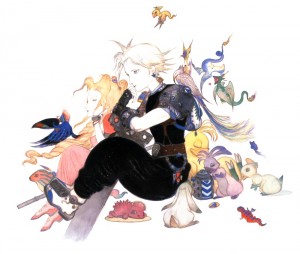
Next, consider that in Parasite Eve II, Cloud and Aerith are referenced together once again. Here, Cloud’s name is that of an anti-virus that the player must deploy and the clue to activating the virus is found in an issue of “Aeris” magazine:
The matter is detailed on pg. 128 of the Official Parasite Eve Strategy Guide (scan courtesy of Clorith).
As with the reference from Final Fantasy Tactics, we are being told something here.
Response:
There is certainly allusion here once more to a significant connection between Cloud and Aerith. Fair argument.
—Claim: In the shopping district of Final Fantasy VIII’s Esthar City, there is a store called “Cloud’s Shop.” An obvious reference to FFVII’s leading man, the store also references Aerith via the ribbons around the wrapped gifts the store occasionally provides the player:
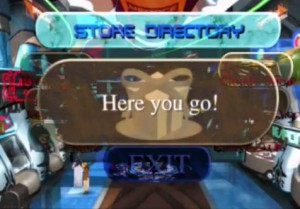
Another reference to their connection from yet another Square title.
Response:
The ribbons on the presents are not in reference to Aerith. All of the stores in Esthar provide identically wrapped presents, including, for example, Johnny’s Shop:
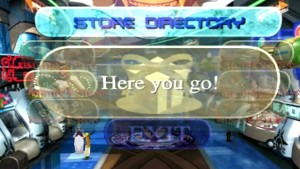
—Claim: After Kuja’s attack on Alexandria relatively late in Final Fantasy IX — an installment that celebrated the series’ history with a host of references to past FF titles —Pluto Knight VII, Weimar, can be found in the city talking to a flower girl next to a ruined building that resembles a church and is identified with “Alexandria/Steeple” on the save data screen when the player first gets the option of saving their progress.
If the player speaks to Weimar as he and the flower girl converse, the knight will say, “To have the chance to meet a pretty flower like you in a destroyed city… Oh, I’m the luckiest guy in the world!” Meanwhile, the flower girl will say, “He’s handsome, but he’s not exactly Mr. Personality…” — all of this quite the obvious series of references to Final Fantasy VII (Pluto Knight VII), Cloud (Weimar being “not exactly Mr. Personality”), Aerith (the flower girl) and Aerith’s church (the building identified as “Steeple”):
Though their lines in the Japanese version aren’t quite the same, they’re pretty close, and still make the same allusions.
Their Japanese lines:
—
Weimar: 「この荒れ果てた町で、こんなひな菊のようにカレンでかわいいコと出会えるなんて、僕はなんという幸せ者なんだ!!」
Flower Girl: 「このひと、顔はいいんだけど、ちょっと性格がねぇ……」
—Translations:
—
Weimar: “What a lucky guy I am to meet a cutie so like a flower in this desolate town!!”
Flower Girl: “This guy has a nice face, but his personality is kinda …”
—
This is yet another in a long line of references outside FFVII itself that point to Cloud and Aerith’s love for one another.
Response:
Seeing a nod to the CloudxAerith pairing in this is actually the reasonable conclusion to draw. Certainly Weimar is not a reference to Zack, even if his enthusiasm seems more befitting of Cloud’s deceased best friend.
Given when FFIX came out, we didn’t yet have Crisis Core and a whole game to spend time with Zack’s personality. While what little we saw of him in FFVII did paint him as more congenial than Cloud, the flower girl says that Weimar “isn’t exactly Mr. Personality,” which is a good description of Cloud, who was already known to FF fans at the time to be kind of awkward and simple.
As far as IX’s developers go, they would be expecting players to associate this flower girl and the Pluto Knight with Aerith and Cloud.
Added to that, even though what the flower girl actually says to describe Weimer is something closer to “his personality is kinda …,” the fact that the flower girl even comments on his personality in this manner makes it sound like she’s implying something negative. At least not positive anyway.
For that matter, Cloud’s personality really is kinda … well, fill in the blank. Dull? Simple? Not as alluring as his face?
It fits.
Besides, looking at a soldier meeting a flower girl (what will that sound like to most FFVII veterans?) and expecting it to sound exactly like Cloud and Aerith talking to one another is expecting too much from a reference in a game that made Madeen a female and Black Mages into condensed spirit poop.
All that said, the follow comments from hitoshura may also need to be considered:
—
Only English fans seem to consider this a reference to FFVII. When the Ultimania Omega listed FFVII cameos in other games, it didn’t say a word about this. It mentions the Cloud sprite in the PS1 version of FFV, it mentions characters’ names appearing in other games, but not this. FFIX’s section mentions Zidane talking about a “spiky-haired guy with a big sword,” but doesn’t mention anything about a romantic cameo of the true couple of FFVII?…
I can see why people believe that, but I am suspicious of it being a “romantic C/A cameo.” This isn’t really like FFT where one is “Aerith” and the other is clearly Cloud. This is an NPC who happens to sell flowers being hit on by a character who sounds, acts and looks nothing like Cloud. Apart from being “Knight no. 7,” he’s completely different. He’s Cloud in number alone.
Haagen is nothing like Squall, Laudo isn’t like Cecil (unless I don’t remember his secret ambition to be an author). The Knights themselves aren’t really references to the past games; it’s more a reference to the number “9” than anything else.
If this is meant to be a romantic cameo, it’s a cameo where one character is nothing like his original counterpart and the other says he is basically just a pretty face.
The FFVII Ultimania Omega mentions dozens of little references to FFVII in other games, including ability names in FFVIII and character names in Crystal Chronicles or the “Cloud anti-virus” and “Aerith” magazine in Parasite Eve 2, but not this one. FFIX’s own Ultimania mentions the weapon shop Cloud reference and Rufus’s welcoming ceremony music, but again not this. “Atla” is a reference to Chocobo’s Mysterious Dungeon, “Wayne” and “Torres” are from Parasite Eve, “no place to put a medal” is a parody of a certain horror game — but nothing about a reference to Cloud and Aerith? No one thought “This is a neat little reference to Cloud and Aerith in FFIX. I’m going to post about it online somewhere so other people can know about it”?
—
—Claim: In the first Kingdom Hearts game, we learn that Cloud is searching for someone and is willing to go to great lengths to find this person — even to the point of cooperating with Hades and using the power of darkness.
As Sora discusses the matter with him after Cloud leaves Hades’ service, Cloud reveals that, like Sora, he is searching for the light in his own life:
—
Sora: “Hey, are you all right?”
Cloud: “Yeah.”
Sora: “So why did you go along with him, anyway?”
Cloud: “I’m looking for someone. Hades promised to help. I tried to exploit the power of darkness, but it backfired. I fell into darkness, and couldn’t find the light.”
Sora: “You’ll find it. I’m searching, too.”
Cloud: “For your light? Don’t lose sight of it.”
—
Though Cloud doesn’t come out and directly say that he is searching for his light, he does make an association here between his search and Sora’s search “for your light.” A parallel of sorts is established between their respective endeavours. Cloud then isn’t seen again until the ending credits of the game, where he is reunited with Aerith alongside clips of other romantic couples being reunited.
Furthermore, in an interview with the Official U.S. PlayStation Magazine for its October 2002 issue (issue #61, pg. 139), Nomura was asked, “What was the thought behind bringing back Aerith?” and gave the following response:
—
Yes, she died in Final Fantasy VII, but there’s no real relation to where she was at or what role she played in FFVII. There’s no relationship from FFVII to the Kingdom Hearts stories. I consider them separate stories. But if you play Kingdom Hearts, toward the end, some of the questions about the relationship between Cloud and Aeris in FFVII might be answered. It’s sort of like a side story, and this was an extra bonus that I wanted to give to players.
—
Though Nomura says that KH and FFVII are separate stories with no relationship, he does suggest that one might be able to serve as commentary on the other, particularly with regard to Cloud and Aerith’s relationship.
The meaning at work here is clear: Cloud was searching for his light, and his light is Aerith, the woman he is in love with — a fairly direct parallel to the situation between Sora and Kairi.
It is otherwise made evident in the Kingdom Hearts mythos that someone’s light is their romantic partner — the person they’re in love with. This is most evident in the relationship between Sora and Kairi.
Even the original Kingdom Hearts makes it clear that Kairi is Sora’s light. We know, after all, that Sora was searching for his light, and also that he was searching for Kairi, whom he is in love with. This fact is directly stated in Kingdom Hearts: Chain of Memories, however, where Naminé says the following to sora:
“But there’s another promise you made — a promise to someone you could never replace. She’s your light. The light within the darkness.”
Regardless of whatever complications may have been introduced to Cloud and Aerith’s Kingdom Hearts story in later titles that included Sephiroth and Tifa, the fact remains that they were the only two characters central to Cloud’s tale that were present in the original Japanese release, and whatever truth there is to be found about Cloud’s search for his light must be present within the original release.
Furthermore, according to Tetsuya Nomura on pg. 525 of the KH Ultimania, Cloud was actually added to Kingdom Hearts to expand Aerith’s story presence:
—
Aerith
At the time of FFVII, some of my comments weren’t what I intended, and I actually had hoped to amend them, but it was too late. Until midway through, this role was supposed to be filled by Aya from Parasite Eve, but there were requests from staff who worked on FFVII, so this appearance for Aerith came about and the story was expanded from there with Cloud. There are multiple cases where the development of characters’ stories were born out of exchanges such as this.
—Japanese text:
—
エアリス
FFVII当時に、意図と違う表現が自分の言葉になっていて、正しい表現への差し替えをお願いしたのですが、手遅れでした。この役は、途中まではPEのアヤにする予定で し たが、FFVIIを担当していたスタッフからの要望もあり、今回のエアリスの登場が実現し、そこからクラウドとのお話が膨らんでいきました。キャラクターの物 語の展開は、 こういったやり取りの中から生まれる場合もあります。
—
In summary, Cloud was added to Kingdom Hearts as an expansion of Aerith’s presence, Aerith is his light/romantic partner, and he was searching for her. Furthermore, these facts are reinforced by a theme from the ending credits of the first Kingdom Hearts, where Cloud and Aerith are reunited as several other romantic couples simultaneously reunite.
Response:
The first and most obvious problem with the foundation of this whole line of reasoning is that not every person has a romantic partner nor even someone they are in love with, much less a person who reciprocates those feelings. This fact would exclude a great many people from possessing a light in the manner described above, yet everyone has light and darkness within them in Kingdom Hearts’s cosmology — with exception to the Seven Princesses of Heart, whose hearts are without darkness.
One’s light may be their romantic partner, but it is also made clear within the series that a person’s light comes from within them. As the mechanics of this particular element of the Kingdom Hearts mythos have never been fully explained, it would be most prudent to conclude that a romantic partner — or anyone else of especial significance to a particular person — is able to serve as a steward of sorts for their light, housing it within them. Such an example might include when Kairi’s heart took up residence within Sora following the loss of her own heart.
The second issue in need of address here relates back to the first. There’s simply no confirmation that being someone’s light is an inherently romantic thing. The only time we know of it happening is with Sora and Kairi. This one example should not necessarily be taken as a standard that every other situation must follow.
Up next, it’s frequently overlooked but notable that Cloud does not say that he made use of the power of darkness in his search for his light, nor does he even state that he is looking for his light. The English localization may leave one with that impression, but even there it’s clear that he made use of darkness in a search that was already underway, and — as a consequence of using darkness — “couldn’t find the light.”
For accuracy’s sake, though, what he actually said is that once he fell into darkness, he lost sight of the light. He then immediately warns Sora not to do the same: “Don’t lose sight of it.”
Here is the Japanese text of Cloud’s line from the game:
「闇にとらわれ、光を見失った」
“I was caught in the darkness, and lost sight of the light.”
Here also is his subsequent line where he urges Sora not to do the same (note the identical wording in Japanese):
「見失うなよ」
“Don’t lose sight of it.”
This being said, a player of the original Japanese release of Kingdom Hearts — or even the North American release of the game, for that matter — could hardly be faulted for concluding that Cloud was searching for Aerith anyway. The information gone over under the “Claim” header above still seems to paint a rather clear picture: Cloud is searching for someone just as Sora is; Sora is searching for his light; Sora’s light is Kairi, whom he is in love with; Cloud is reunited with Aerith in the game’s ending; Cloud must have been searching for Aerith; Aerith must be Cloud’s light; and all this can be taken as a comment about their relationship in the Final Fantasy VII canon.
Truth be told, at the time of Kingdom Hearts’s original release and the release of its Ultimania, this would have been a powerful argument. Perhaps an unbeatable one when combined with Cloud’s “I think I can meet her… there” line from the original game, as well as the Final Fantasy Tactics cameos and FFIX reference.
Of course, exactly what commentary could be made on the original by the meeting in KH was characteristically left unclear by Nomura. Again, though, at the time of the initial release of Kingdom Hearts, it would not be unreasonable to draw romantic conclusions from it.
However, the situation quickly became more complicated. The North American release of Kingdom Hearts saw the inclusion of Sephiroth as an optional boss. Very soon after that, Kingdom Hearts: Final Mix was released in Japan and Sephiroth was concretely identified as the person for whom Cloud had been searching — even by Aerith herself.
After meeting Cloud in the Olympus Coliseum world and then closing the Keyhole in Agrabah, if one returns to Traverse Town and speaks with Aerith in the Dalmations’ house, the following exchange takes place:
With the recent release of the Kingdom Hearts HD I.5 ReMIX collection around the world, there is now — eleven years later — even an official English translation of this dialogue from the Final Mix edition of the game, though the translator’s choice of wording in reference to Sephiroth is more than a little odd (as well as inaccurate as a translation of the Japanese line):
In any case, Cloud himself later confirms that he was searching for Sephiroth during a conversation that takes place with his recurring rival after the player has defeated Sephiroth at the Coliseum:
(translation by Thorfinn Tait)
—
Cloud
やっと会えたな
So we meet at last.Sephiroth
俺も探していた
I was searching for you too.Cloud
おまえが存在する限り
俺は悪夢から覚めることができない
As long as you exist,
I can’t wake from this nightmare.Cloud
お前は俺の闇だ
You are my darkness.Sephiroth
ならば闇へと誘おう
If that’s so, I shall draw you into the darkness.Sephiroth
永遠に光を奪い、
覚めることのない悪夢の中へ
Into the nightmare that forever deprives you of light,
from which you can never awaken.
—
The official English dialogue from the KH HD I.5 ReMIX release is very similar to Thorfinn Tait’s translation from eleven years ago:
—
Cloud
I’ve been looking for you.Sephiroth
As have I.Cloud
As long as you exist, I’ll never
wake from this nightmare.Cloud
You’re my darkness.Sephiroth
I’m a part of you, am I?Sephiroth
Then join me in this
eternal nightmare
untarnished by light.
—
The argument that this information should not be considered canon because it wasn’t present in the original Japanese release of the game doesn’t hold water for what should be obvious reasons. If they aren’t quite, then hopefully this will put the matter in perspective:
The original Japanese release of Final Fantasy VII lacked the Emerald and Ruby Weapons (both of whom are featured in an FMV in the North American and Japanese International releases), as well as Tifa’s flashback to finding Cloud at the train station in Midgar’s Sector 7, and even Cloud’s flashback depicting his escape with Zack from the Shinra Mansion to the outskirts of Midgar, where Zack is gunned down (a sequence included in Reminiscence of Final Fantasy VII and adapted for Crisis Core).
These details — much of them crucial backstory for Cloud — were not in the original Japanese release, and yet they are most assuredly canon. Vital, in fact, to the FFVII that we know and love today.
As originally released, FFVII left quite a confusing conundrum with regard to how Cloud ended up in Midgar with AVALANCHE. These crucial missing details explained not only that, but also what became of Zack, how Cloud ended up in a SOLDIER’s uniform, why he believed he had done things that were actually performed by Zack, where he got the idea to be a mercenary, how he acquired Zack’s sword, and how Tifa found him.
For that matter, even in the KH Ultimania, Nomura said that Sephiroth was intended to have been present from the first release. This exchange comes from pg. 534:
—
―”If there is a sequel, will Cloud and the other FF characters appear again?”Nomura: “Certainly, if there is a sequel, Cloud will show up again. As a matter of fact, XXXXXXXXX will be appearing in the overseas edition of Kingdom Hearts.”
―”Ah!”
Nomura: “That being the case, I’d like to expand Cloud’s dialogue from here on out.”
―”The overseas edition won’t be the same as what you have now then?”
Nomura: “A few extra elements are being included. For example, XXXXXXXXX is newly added. With the domestic version, the design was finalized and the polygon model was also created, but due to time constraints, it had to be cut. Such things are being restored. I guess because my staff had never been this involved with a game, pretty much everyone said, “I want to fight a strong enemy.” Many opinions were considered, and we performed as much fine-tuning and refinement of portions that raised concerns as we could in the limited time available.”
—Japanese text:
—
――つぎがあるなら、クラウドとかの『FF』キャラクターも出るんでしょうか?
野村 そうですね、クラウドは、つぎがあるんだったらまた出したですね。じつは、海外版の『キングダム ハーツ』では×××××が×××××んですよ。
――おおー!
野村 なので、いろいろクラウドの話は今後はふくらませられるかなと。
――海外版はそのままの移植ではないんですね?
野村 プラスアルファの要素がいくつか入ってるんですよ。たとえば、×××××が新たに入ってたり。国内版では、デザイン起こして、ポリゴンモデルもできてた のに、時間の 都合でどうしてもカットしなきゃいけなかったんですよ。そういうものが復活してたり。あと、ウチのスタッフが、こんなにやりこんだゲームはないだろうというぐ らいにみんな やりこんでたんで、「強い敵と戦いたい」と言う声も多かった。そういう、もろもろの意見を反映させて、かぎられた時間で可能なチューニングや追加、気になった 部分の強化を しています。
—
Nomura reiterated this fact in an interview on pp. 723–724 of the KHII Ultimania, as well as revealed that the developers had originally wanted to include Tifa as well:
—
―”What was the process for selecting characters from the FF series?”Nomura: “We got a sense of which characters had a lot of demand for an appearance. Although many opinions from the fans were weighed, a lot of the requested characters overlapped with each other.”
―”Tifa from FFVII was introduced.”
Nomura: “As a matter of fact, the staff wanted to include her when making KHFM. ‘As a brawler, it would be interesting to battle with her,’ they said, and they actually wanted to add both Sephiroth and Tifa; however, the schedule we were working under didn’t allow us to include more than one, so Sephiroth was selected for KHFM. Because of that, we discussed having her appear this time. Because the voice recording for KHII and FFVII Advent Children (hereafter, FFVIIAC) was being performed at the same time, it started to seem like we were doing KHII one day, then FFVIIAC the next (laughs). I think it was beneficial that the voices were recorded during the same time period.”
—Japanese text:
—
――『FF』シリーズのキャラクターは、どういう基準で選んでいったんですか?
野村 要望が多いキャラクターを出す、という感じでした。ファンのかたがたの意見の両方から考えるんですけど、やっぱり要望多いキャラクターは重なってきます よ。
――『FFVII』からはティファが登場しましたね。
野村 じつはティファは、『KHFM』を作るときに、スタッフのほうから出してほしいと言われていたんです。「肉弾戦という意味で、ティファとのバトルはおも しろくなりそ うだ」と言われて、本当はセフィロスとティファを追加したかったんですけど、スケジュール上ひとりしか入らないということで、『KHFM』ではセフィロスを選 択した。そう いうこともあったので、今回はティファを出そうという話になりましたね。『KHII』のボイス収録は、ちょうど『FFVII アドベントチルドレン』(以下『 FFVII AC』)と同じころにやっていたので、今日収録は『FFVII AC』、明日は『KHII』……みたいになってまし(笑)。同じ流れのなかでボイスを録れたので、良かったなと思います。
—
But ignore all this. Go ahead and make the argument that Cloud wasn’t searching for Sephiroth because Sephiroth wasn’t in the original release of Kingdom Hearts. In the process, one would have to essentially destroy the plot of Final Fantasy VII — not to mention cast aside all the significant new details from Kingdom Hearts II: Final Mix, the altered Chaos Reports in the North American and Universal Tuning releases of Dissidia Final Fantasy, retcons from Dissidia 012 and the retcons and added footage from Advent Children Complete.
A great host of details would need to be cast aside, despite their obvious status as canon. If one wishes to debate the canon, then one must be willing to accept the canon.
That matter settled, let’s move forward.
With the release of Kingdom Hearts II, the solidarity of prior conclusions were cast further askew. Just as Sephiroth had been revealed to embody the darkness in Cloud during Kingdom Hearts: Final Mix — a plot point reiterated by Cloud in Kingdom Hearts II (“This time we settle it. Me, and the one who embodies all the darkness in me”) — Tifa appears here and is revealed to be the embodiment of the light within Cloud.
Though this is never directly stated in-game like the nature of Sephiroth’s existence, it becomes clear with a minimum of detective work. These lines from Sephiroth’s set it all up:
●”Cloud is the one who hungers for Darkness.”
●”That last bit of light is always the hardest to snuff out.”
●”The darkness comes from your own dark memories. Do you think you can erase the past?”
●”Face it—you turn your back on the present and live in the past. Because the light of the present is too much.”
Note that last line in particular. Cloud is turning his back on his own light, synonomous here with the present and moving forward, and wallows in his darkness, synonomous here lingering in the past — the same thing he was doing in Advent Children, from which his and Tifa’s designs for Kingdom Hearts II were drawn.
By an understanding in which Tifa is not the manifestation of Cloud’s light, the Kingdom Hearts incarnation of Tifa becomes a bumbling, pathetic woman who looks behind random walls and checks under tables in her search for Cloud when he really just wants her to leave him alone and runs away whenever she draws near. This is invariably the perception of her taken by those of an anti-Tifa positioning.
Nevermind that such activity hardly sounds like the behavior of a real person (more like that of an abstract idea made manifest, perhaps?). Ask yourself if Kazushige Nojima and Tetsuya Nomura (respectively, the writer and director of both Advent Children and Kingdom Hearts II) would go to such lengths to craft a ridiculous presentation of Tifa in order to humiliate a character they have otherwise described in positive ways (e.g. emotionally strong, not clingy, etc.). The two notions simply do not jibe.
While an anti-Tifa perspective would hold that Tifa’s light was unsuitable for Cloud and blinded him when she tried to assist him during his battle with Sephiroth, a more honest analysis would recall that Sephiroth (Cloud’s darkness) said that Cloud turned his back on the light within him because “the light of the present is too much.”
That is, after all, what Cloud’s story arc in Kingdom Hearts II is all about: accepting the light within himself.
As he sets out on his quest to defeat Sephiroth early in the game, Sora makes the following comment to Aerith: “He’ll be fine. I’m sure there’s some light in him somewhere.” As well, Aerith had told Cloud, “No matter how far away you are…once you find your light…I’m sure it will lead you back here again.”
Notice that Aerith herself acknowledges that Cloud’s light is something separate from herself.
Next, recall again these lines of dialogue from Sephiroth:
●”Cloud is the one who hungers for Darkness.”
●”That last bit of light is always the hardest to snuff out.”
●”The darkness comes from your own dark memories. Do you think you can erase the past?”
●”Face it—you turn your back on the present and live in the past. Because the light of the present is too much.”
Think, now, of what happens when Cloud closes in on Sephiroth during the Heartless invasion of Radiant Garden. Right after Sephiroth remarks that Cloud turns his back on “the light of the present,” Cloud retorts “You don’t know me!” only for Tifa to show up and call out to Cloud. As he turns to look at her, he is blinded by a white light tinged with blue, demonstrating exactly what Sephiroth was just describing.
Sephiroth then adds, “I know. Because…I am you,” his dialogue having summarized precisely the situation we see presented visually in the same scene. Cloud, of course, then takes flight from Tifa in pursuit of Sephiroth, further reinforcing Cloud’s preoccupation with darkness and his past in rejection of the present and his own inner light.
Cloud finds himself blinded again during his showdown with Sephiroth after the player has defeated Sephiroth in battle. Tifa steps up to take on Sephiroth for Cloud’s sake, and as she struggles to land a blow while evading Sephiroth’s attacks, Cloud is once again overcome by “the light of the present.”
Tifa’s light (i.e. Cloud’s light) is what he needs. He’s denying part of himself, “[turning] his back on the present and [living] in the past.” It isn’t until he steps up to defend Tifa (his manifestation of light) from Sephiroth (his manifestation of darkness) that he faces the present long enough to gain the power to fight Sephiroth, becoming surrounded in a gold aura like the one that surrounded Cloud as he defeated Sephiroth in Advent Children.
One may then argue that this then means the gold aura is Cloud’s inner light and something different from what Tifa had offered him (the white light tinged with blue). However, Cloud only gains the golden aura after calming himself and finally emanating the same white light tinged with blue that had appeared because of Tifa — a move that elicits a panicked “Stop!” from Sephiroth and a desperate attack.
Were that light not antithetical to Sephiroth, Cloud’s darkness, what then prompted such a reaction? The answer is clear to all who wish to see it: Tifa is Cloud’s light in the Kingdom Hearts reality.
Notice further that at no time is Cloud’s evasion of Tifa nor his rejection of “the light of the present” presented to the player as a positive thing. It is, in fact, this very behavior that continues to resurrect Sephiroth. As Sephiroth later observes, “Defeating me is meaningless. You know that more than anyone, Cloud. No matter how many times I fall, your darkness keeps calling me back!”
On pg. 718 of the KHII Ultimania, Kazushige Nojima even openly noted the parallel between Cloud’s behavior in Kingdom Hearts II and Advent Children, where he was denying himself the comfort of family and looking to the future while languishing in the past:
—
—”This was the first appearance of Tifa from FFVII.”Nojima: “As a matter of fact, Tifa wasn’t initially planned to show up. As Tetsu and I talked about what Cloud should be doing in Hollow Bastion, we decided that while he’s pursuing Sephiroth, Cloud should be pursued by something as well. Although Cloud’s really running from something, he claims to be following Sephiroth. So we decided that he’s running from ‘warm feelings’ like what Tifa desired in FFVII AC.”
—Japanese text:
—
――『FFVII』からティファが初登場しました。
野島 じつは最初、ティファは出る予定がなかったんです。クラウドはホロウバスティオンで何をしているのか、という話を哲さんとしていて、クラウドはセフィロ スを追いかけ ているけど、クラウドもまた何かに追われている、という方向性になって。クラウドは、本当はあるものから逃げているんだけど、自分ではセフィロスを追っている と称している わけですね。それで、「『FFVII AC』でティファが求めているような”温かいもの”から逃げている」という設定にしました。
—
Tetsuya Nomura also revealed in an interview in an interview on pg. 724 of the KHII Ultimania that Nojima had originally intended to have this connection openly stated during the game, but that Nomura himself then decided to make the matter slightly more ambiguous so that players might still interpret Tifa as an ordinary human being like the other residents of Hollow Bastion:
—
—”Speaking of Tifa, there’s an event after beating Sephiroth where she interacts with Cloud.”Nojima: “In Nojima’s scenario, the connection between Cloud and Tifa was discussed more concretely, but I chose to erase that. I thought it would be more interesting for players to think about it instead. For example, with the meaning that ‘if Sephiroth is Cloud’s darkness, then Tifa is his light,’ one may take the understanding that Tifa isn’t human. It may be because Tifa isn’t human that she doesn’t talk with anyone but Sora’s group. Of course, since she was also presented in a way where she could be seen as a resident of Hollow Bastion like Cid, Aerith and the others, I think one can freely ponder that.”
—Japanese text:
—
――ティファと言えば、セフィロスを倒したあとに、クラウドをまじえたイベントが用意されていますね。
野村 あそこに野島さんのシナリオだと、クラウドとティファの関係がもっと具体的に語られていたんですけど、自分のほうで削除させてもらったんです。遊んだ人 に考えてもら ったほうがおもしろいだろうな、と思って。たとえば、「クラウドにとっての闇がセフィロスならば、光はティファである」という意味で、ティファを人間ではない 存在としてと らえてもいいんじゃないかと。ティファがソラたち以外の人と会話しないのは、人間として存在していないからなのかもしれない。もちろん、シドやエアリスたちと 同じようにホ ロウバスティオンの住人だととらえることもできるような表現になってますから、そのあたりは自由に考えてもらっていいと思います。
—
No matter Nomura’s preference for letting players figure things out on their own, the intent remains clear all the same. Aerith may yet even be Cloud’s romantic interest in the universe of Kingdom Hearts, but Tifa is undoubtedly the embodiment of his inner light — for whatever that’s worth.
While Nomura has certainly suggested that we may draw commentary upon the FFVII canon from the tales of this alternate universe, what we can take from it is unclear. As being someone’s light does not necessarily mean the other person is in love — particularly when one of the “people” in the equation is actually the embodiment of a facet of the other person — there is little we can reasonably draw from KH to say about FFVII.
Sephiroth’s ubiquitous role in both Clouds’ lives as a recurring antagonist may have a self-evident meaning for his being KH Cloud’s darkness, but any dissertation on what meaning we should take from KH Tifa being KH Cloud’s light would unavoidably wax more speculative and subjective than I wish to.
Likewise with the ending of the first Kingdom Hearts when Cloud and Aerith are reunited. The meaning to be drawn could literally be anything — especially in light of the Compilation of FFVII having not yet been planned. The meaning at work could easily range from “In any world, Cloud and Aerith will have a special connection” to “Lovers reunited!” to “Cloud’s wish to see Aerith again got fulfilled, even if it’s not really them” to “They could only ever see each other again in an alternate universe where death has not come between them.”
Others may, but this author has no interest in going down any of those roads.
In seeking to settle the LTD, we’re, thus, forced to rely upon solely the details found in the Compilation of Final Fantasy VII materials and their related metatext (developer interviews, etc.). And those, as we’ve gone over at length, point to a Cloti conclusion.
Before finishing this response, one final point that merits making is this: The pervasive claim that there is a theme of lovers being reunited during the ending credits of the first Kingdom Hearts is baseless. Jasmine and Aladdin are the only ones. Furthermore, their scene is on neither side of the moment at Hollow Bastion, so it doesn’t even serve to provide that scene with context by bookending it.
We do not see Beast with Belle. We do not see Mickey with Minnie. Nor do we see Donald with Daisy, Aurora with Prince Phillip, and neither Cinderella nor Snow White with their princes. Simply put: No such theme exists.
—Claim: The opening video for Dragon Quest & Final Fantasy in Itadaki Street Special (hereafter simply referred to as “Itadaki Street Special”) has a significant preoccupation with showing Cloud and Aerith together, while Tifa is never very near either of them — rarely even in the same frame:
At the 0:22 mark in the opening video, Cloud and Aerith are seen walking down a street together for a few seconds before they come to a stop as they take notice of the light in the sky that is soon noticed by other characters from the Dragon Quest and Final Fantasy series:
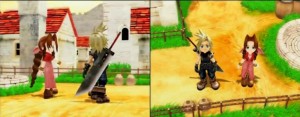
They are seen again at the 00:42 mark, still together as many characters assemble in the town square to observe the event taking place. Tifa, meanwhile, is off by herself on the far left side of the frame:
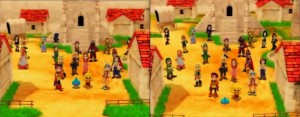
Furthermore, as the characters assemble here, Squall and Rinoa — an established, inarguable romantic coupling in the Final Fantasy series — are seen coming into the frame together as well, presumably having been walking together as Cloud and Aerith were.
When next seen at the 0:47 mark, Cloud and Aerith are running toward the glowing castle, she a few steps behind him:
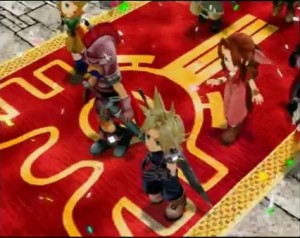
A mere three seconds later, at the 0:50 mark, Cloud is now chasing after Aerith as they make their way into the castle, but stops to clasp hands with the Hero of Dragon Quest V:
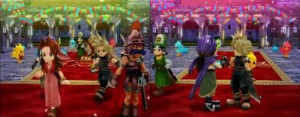
When next seen at the 1:01 mark, Aerith is briefly by herself while throwing a die, but she is seen alongside Cloud again a few short seconds later at 1:05, while Tifa is in the tier behind them next to Rikku (Tifa briefly comes into view on the extreme right side of the frame at 1:07, but is clearly visible in this position next to Rikku a moment later at 1:21).
Squall and Rinoa, meanwhile, remain next to one another during this entire sequence, just like Cloud and Aerith.
Furthermore, the disc art for Itadaki Street Special shows us the same thing — Rinoa beside of Squall and Aerith beside of Cloud:
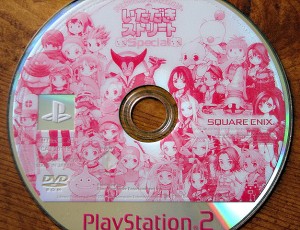
Tifa, meanwhile, is once again off to the side on her own.
While Cloud stands next to both of them in the roster seen on the Character index of the official website for Itadaki Street Special, each on either side of him, on the page of the site specific to FFVII’s characters, he stands next to Aerith, with Sephiroth on the other side of him and Tifa then on the other side of Sephiroth:
The parallel being drawn here is quite blatant.
Response:
When making claims such as this, one must be aware of all the comparisons they’re inviting. If a theme involving romantic couples were actually intended by the placement of characters in Itadaki Street Special’s opening cinematic and related artwork, it certainly plays a confusing game.
Tidus and Yuna from Final Fantasy X are an established pairing that I hope requires no argument to prove — yet they receive absolutely none of the attention from this purported theme. In fact, they often couldn’t be placed further apart.
In Tidus’s first appearance in the sequence at the 0:37 mark, he isn’t by himself, but he isn’t with Yuna either:
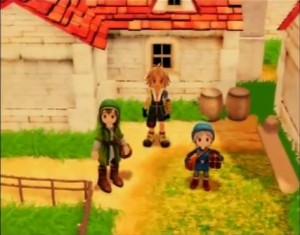
He’s with the Hero of Dragon Quest VII and Terry, the latter depicted here as he was seen in Dragon Quest Monsters: Terry’s Wonderland, a prequel to Dragon Quest VI: Land of Illusion.
When Tidus is seen next at the 0:42 mark, assembling in the town square with many other characters, Yuna is also present, though the two aren’t near one another at all. Tidus is more toward the upper-left of the screen while Yuna is toward the bottom-right — the distance between them actually approximately as great as that between Tifa and Cloud:

Yuna is next seen at the 0:48 mark running toward the castle with all the others, Tidus nowhere in sight:
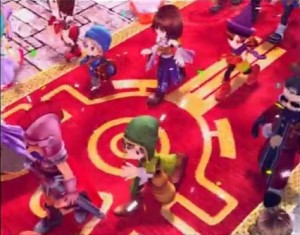
He does, however, appear almost immediately thereafter at the 0:49 mark, though Yuna is far in the background as both continue running toward the castle. She doesn’t even reach the position he is spotted in for three seconds after he has already ran on ahead:
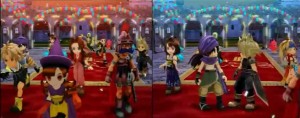
Yuna can then be seen dancing without Tidus — again, he is nowhere in sight — at the 0:53 mark, while Rikku and the Hero of Dragon Quest VII dance in the foreground:
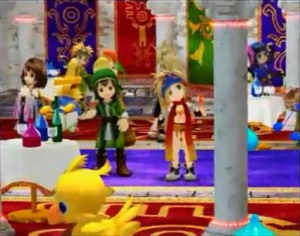
Tidus can then be seen in the center of the room at the 0:59 mark, Yuna nowhere near him. Indeed, she is nowhere in the frame, even as the camera zooms out:
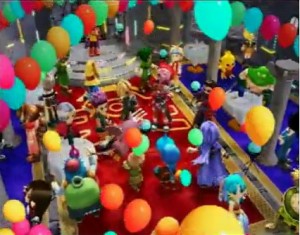
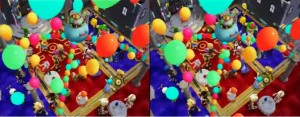
Tidus can then be spotted at the 1:02 mark, making a move on the game board — again without Yuna anywhere in sight:
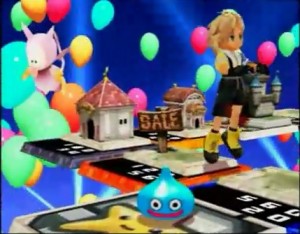
It is until 1:05 that we actually see Yuna and Tidus in something that qualifies as close proximity to one another, and even then they are standing on different tiers of the assemblage and are closer to a number of other characters than to each other:
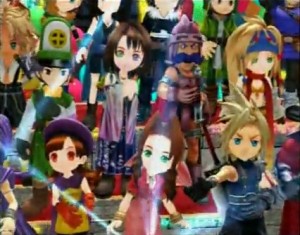
Even when the camera focuses on Yuna as she catches the orb of light at 1:24, Tidus’s shoe is still visible on the tier behind her, both of them still closer to others than to one another:
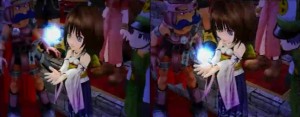
Finally, in the closing shot of the opening sequence at 1:31, Yuna is far in the background while Tidus is all the way in the foreground, slightly obscured by the game logo:
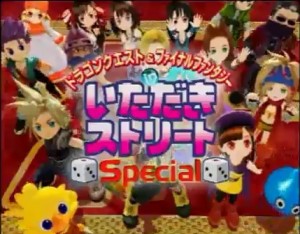
Tidus and Yuna aren’t even near one another on the game box cover nor the cover of the Itadaki Street Special Perfect Guide:
The only depictions of the two next to each other when in groups of several others come in the roster from the Character index on the official site and on the game’s disc art:
In both cases, though, Tidus is next to either Yuna’s FFX or FFX-2 incarnation while her alternate depiction is far away from him. FFX-2 Yuna is with Rikku and Paine on the top row of the character roster from the official website. FFX Yuna is in the upper-right of the disc art, just above Auron.
Yuna and Tidus are actually seen together in Itadaki Street Special’s imagery less than Cloud and Tifa.
Even more confusing in terms of this asserted theme regarding romantic couples is that the canon couple from Dragon Quest V: The Heavenly Bride — Bianca and the Hero of the game — are seen together even less than Tidus and Yuna, while the Hero is frequently presented alongside Flora, the third point in that game’s love triangle.
Around the mid-point of DQV’s storyline, the player is given the option of having the Hero marry either Bianca, his childhood friend, or Flora, a woman he has just met. The Nintendo DS remake of DQV would later add a third choice to become the Hero’s bride, Flora’s older sister Debora, but — as the DS remake would not come out until 2008 while Itadaki Street Special was released in 2004 — only Flora and Bianca are featured here.
One can be sure that Bianca is the Hero’s canon wife for a number of reasons, which we will now go over.
First, whoever marries the Hero will bear him a son and a daughter, both of whom share their mother’s hair color. In other words, if the Hero marries Bianca, his children will be blond. If he marries Flora, they will have blue hair. In all their official artwork, the Hero’s son and daughter have blond hair, including in one image that also features Bianca in a wedding dress:
●Hero’s Son
●Hero’s Daughter
●collage that includes Bianca in a wedding dress
Just as telling, all official figurines of the Hero’s son and daughter also feature them with blond hair. This includes figures from the Dragon Quest V Character Figure Collection manufactured by Square Enix for release in July 2004 and figures from Volumes 2 and 3 of a franchise-wide set — the Dragon Quest Character Figure Collection — released by the company in 2008:
●DQV Character Figure Collection
●Volume 2 of the DQ Character Figure Collection
●Volume 3 of the DQ Character Figure Collection
Furthermore, out of the many releases of DQV, Flora has only been present once on the back cover of the Japanese DS release’s packaging while Bianca has been featured prominently on each front and back cover — usually with her blond children present as well. Consider the following covers used for the game:
●Super Famicom release; front and back covers
●Super Famicom release; cartridge
●PS2 release; front and back covers
●DS release Japan; front and back covers
●DS release North America; front and back covers
While the covers alone would not necessarily prove anything, for a game whose subtitle is “The Heavenly Bride,” there’s quite a preoccupation with displaying one of the player’s choices for who becomes the Hero’s bride.
In the interest of full disclosure, however, be aware that the PS2 version’s disc art featured no characters, nor did the included bonus preview disc for Dragon Quest VIII.
Added to all that we have already gone over, Dragon Quest creator and writer Yuji Horii has himself said that Bianca is the best choice for a bride, as seen in this interview on pg. 60 of the February 2009 issue of “Nintendo Power” (issue #238):
—
If you were a single man of Dragon Quest V hero’s age,
which heroine would you choose to marry?
Now that’s a tough question! Normally, I’d lean towards Bianca, but emotions are a very tricky thing! There’s something about Debora’s wicked nature that I find appealing, so I would probably go with her. But then my life would become a wreck, and I would regret not choosing Bianca when I had the chance! Life is full of some difficult decisions, isn’t it?
—
Most telling of all, however, are Bianca’s cards from Monster Battle Road II Legends, part of the Monster Battle Road series of Dragon Quest spin-off games in Japan’s card battler genre of arcade games. Both on her cards and in-game, she is referred to as “the Heavenly Bride, Bianca” in Japanese (天空の花嫁ビアンカ) — and with the same kanji as “The Heavenly Bride” subtitle in Dragon Quest V: The Heavenly Bride’s complete title (ドラゴンクエストV 天空の花嫁) — while Flora and Debora are referred to on their cards as “the Noble Maiden, Flora” (貴族の娘フローラ) and “the Third Woman, Debora” (第三の女デボラ) respectively:
●Bianca
●Flora
●Debora
Not surprisingly, the Hero’s son and daughter are also blond in the Monster Battle Road game series, as in these screenshots from Monster Battle Road Victory:
The undeniable canonicity of Bianca and the Hero’s marriage established, let’s now look at how they are presented in relation to one another in Itadaki Street Special’s opening sequence.
When the Hero first appears at the 0:33 mark, he is by himself:
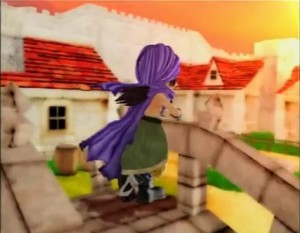
Similarly, when Bianca is first seen at 0:42 assembling in the town square with many other characters, the Hero is nowhere in the frame, nor is Bianca particularly close to anyone else in the shot:

The only time the two are seen in close proximity to one another is during their mutual next appearance at the 0:47 mark:
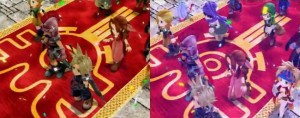
Ironically, though, even in this moment, Flora is also right alongside the Hero as he runs up to pass Bianca:
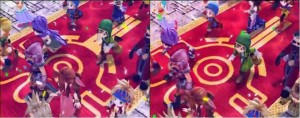
The next of the two to be seen is the Hero at the 0:49 mark, now with neither Flora nor Bianca anywhere in sight. Though the shot does ultimately focus on the Hero, it does so with he and Cloud stopping to clasp hands, presumably in some show of respect:

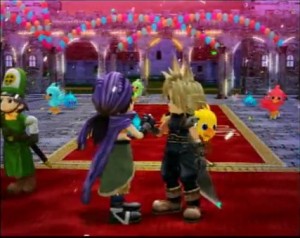
Next, Bianca and Cloud can be seen conversing or possibly dancing together behind Rikku and the Hero of Dragon Quest VII at 0:53 — again, without the Hero anywhere in the shot with her:
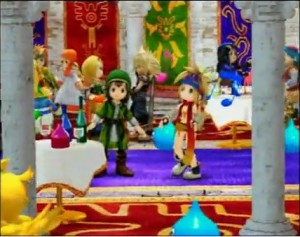
Though both Bianca and the Hero can be seen in a following shot beginning at the 0:59 mark, he is positioned more toward the bottom-right of the frame while she is in the upper-right. What’s more, Flora is actually extremely close to the Hero, though not interacting with him directly here:


At 1:05, the Hero and Bianca are positioned roughly the same distance from one another as at the 0:59 mark, he in the bottom tier of assembled characters, she in the top tier:
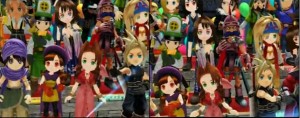
They maintain these positions up to the video’s final shot, even past Sephiroth and the Dragonlord’s arrival — though it becomes clear at this point that Flora has been right beside the Hero:
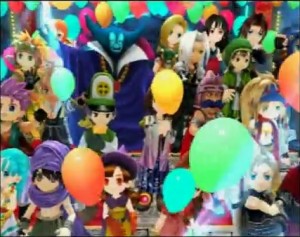
In the opening sequence’s closing shot at 1:31, Bianca appears once more without the Hero, slightly obscured by the game logo:

Referring now back to the game’s disc art, we once again find the Hero and Bianca nowhere near one another — she positioned to the left of the hole at the center of the disc while he is positioned in the far upper-left of the art piece:

Ironically, on this occasion, Flora is positioned much closer to Bianca, being slightly above and to the left of her.
While the Hero stands at the top of the art adorning the game’s box cover, Flora and Bianca positioned on either side of him, looking again at the cover of the Itadaki Street Special Perfect Guide, we find the Hero is once again near neither woman, though Flora is the only one of the two to actually also appear in the image:
What, then, are we to make of all this? Is there a parallel to be drawn between Flora and Dragon Quest V’s Hero to Squall and Rinoa? Aerith and Cloud? A parallel such that irrefutable declarations that Bianca is the Heavenly Bride and the mother of the Hero’s children are rendered null and void due to the positioning of characters in the opening sequence of a real estate video game with cameo appearances of characters from other franchises?
Perhaps there is a parallel to be drawn here for the Hero and the Heavenly Bride after all. Let us look further.
Based on the moment in Itadaki Street Special’s opening sequence where Cloud and the Hero pause to acknowledge one another, it stands to reason that some association is being made between the two. Such an association is reinforced by this wallpaper from the official Itadaki Street Special website that features just the two of them:

Perhaps the association being alluded to is just that they’re the central characters in the most popular titles from their respective franchises — but perhaps it’s something more.
Despite the player having other options, Dragon Quest V’s canon story is that the Hero marries Bianca, his childhood friend. Players of Final Fantasy VII can influence events such that Cloud goes on a date with — or even has a physically intimate moment accompanying a declaration of romantic love — his childhood friend, Tifa. Rather akin to the straightforward declarations that Bianca is the Heavenly Bride of Dragon Quest V, there are also declarations that the moment of romantic confession between Tifa and Cloud took place in Final Fantasy VII.
Perhaps then this wallpaper — also from the official website — featuring only a handful of characters is meant to convey a similar commentary about Cloud and the Hero of DQV. Cloud next to Tifa, Aerith absent, the Hero next to Bianca — perhaps we are to see the two men as two heroes who not only starred in their respective franchise’s most popular offerings, but also ended up with their childhood friends:
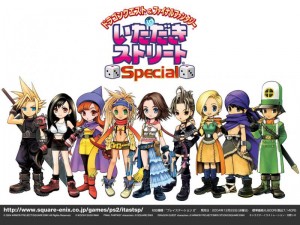
Cloud is, after all, slightly closer to Tifa than Aerith on the game’s box art, arguably the first and most frequent image related to the game that players will see:
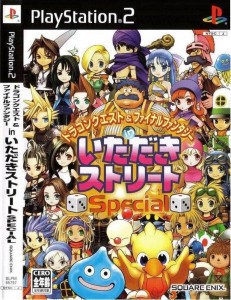
Perhaps there’s a meaning to be found there.
Perhaps there’s also something to be made of Cloud being seen dancing with both Bianca and Tifa during the course of the game’s opening cinematic — Bianca at 0:53 and Tifa in a shot beginning at the 0:59 mark:


While Cloud dances with Tifa in the bottom-left of the frame there, Aerith is at a notable distance from them apparently conversing with the Prince of Lorasia, the Hero of Dragon Quest II.
Or perhaps not. None of this is necessarily the intention behind the arrangement of characters in any of Itadaki Street Special’s imagery, but one should certainly be aware of the comparisons they invite when they begin drawing conclusions of significance from such things as the disc art of an absurd “Monopoly”-style video game unrelated to the continuity of any actual narrative.
Such cameos as this are the absolute last place one should look for illumination.
—Claim: In the March 9, 2013, issue of Famitsu Mobage (issue #14), serial numbers were provided to the first in a series of themed FFVII summon character cards being released for Final Fantasy Brigade/Final Fantasy Airborne Brigade. This first card featured Cloud in the traditional garb of the Japanese emperor, albeit with the Buster Sword rather than a shaku (a scepter traditionally held by Japanese nobility in formal situations):

Matching Cloud’s theme, another serial number was provided on March 14, this time for Aerith in the traditional garb of the Japanese empress:
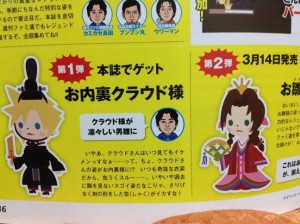
In the weeks to follow, there would also be matching themed outfits for Tifa and Zack, this time in Japanese school uniforms:
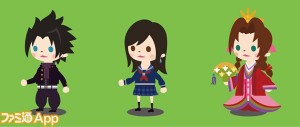
The release of these themed outfits coincided closely with the Japanese holiday Hinamatsuri on March 3 and the beginning of the Japanese school year in April. What’s more, Hinamatsuri doll sets based on media like anime typically pair up romantic couples as the emperor and empress — e.g. Sailor Moon and Tuxedo Kamen from “Sailor Moon,” Konata and Kagami from “Lucky Star,” and Kitty-chan and Dear Daniel from the “Hello Kitty” franchise:
That’s without even looking at this official cellphone wallpaper of Tidus and Yuna as the emperor and empress, released through Kingdom Hearts Mobile’s Point Art Gallery in recognition of Hinamatsuri in February 2011:

Being that the emperor and empress are married, this is as profound and straightforward as any statement from Square Enix has ever been.
Along similar lines, only three short months earlier, Square Enix opened its Artnia cafe next to their headquarters in Tokyo’s Shinjuku ward. Among the desserts on their menu are a strawberry parfait themed around Aerith and a chocolate parfait themed around Cloud — complete with Aerith’s ribbon atop her ice cream and a chocolate Buster Sword atop Cloud’s:

They are the only two Final Fantasy party members to have their own such desserts.
Added to all this, as a pre-order promotion for Lightning Returns: Final Fantasy XIII, a Cloud garb was unveiled for Lightning in July followed by one of Aerith in September:
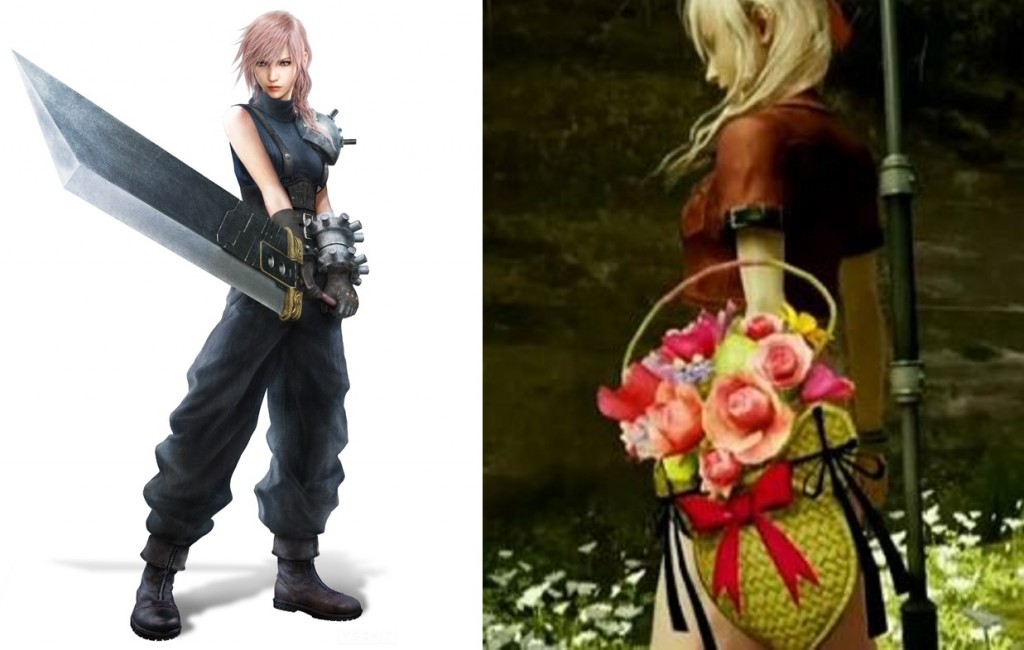
Square Enix knows exactly what tree they’re barking up with all of this, particularly in releasing all of it within a year of each other.
Response:
While it’s not stretching things too much to see the Cloud and Aerith Hinamatsuri set as a nod to the Clerith pairing like the Tactics cameos and FFIX references, it’s not a silver bullet by any stretch of the imagination. Do the Zack and Tifa cards constitute a set? Sure. Do they imply a romantic coupling? Certainly not.
Likewise Aerith and Tifa’s matching bikini set from the first eleven days of August of the same year may not necessarily be intended to imply any romantic association simply because the two are featured together in a matching set:
Furthermore, if Cloud and Aerith’s being featured together in this way is meant to convey a romantic association to players, what then do we make of a summon character card for Zack being accompanied in an event the last week of the same August by an ability card featuring Aerith performing her Fury Brand Limit Break?:
The same question then applies for a set from the previous week’s event, featuring a summon card of Cecil as a Dark Knight and an ability card of Rydia casting Radiant Breath/summoning Mist Dragon:
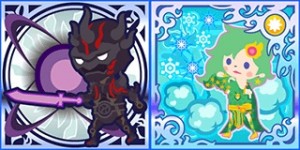
The question comes up again for Terra and Setzer, both of whom had summon cards featured in an event from April 12 to April 16:
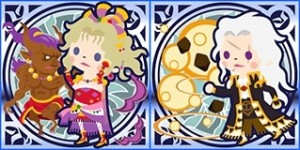
Twice the question comes up for sets involving Yuna summon cards once from an event early in February of 2013 that included an ability card featuring Auron performing his Overdrive Banishing Blade, and a second time during an event from the first two weeks of July 2013 in which an ability card featured Jecht performing Ultimate Jecht Shot:
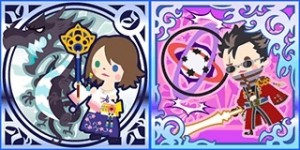
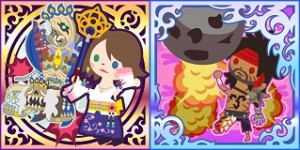
Certainly she has a special relationship with both, and the coupling of these cards may reflect that, but she doesn’t have a romantic relationship with either.
The uncertainty especially comes up when one takes into account one of the earliest promotional sets released for the game, released — like the Hinamatsuri and school days sets — via serial numbers in the April 26, 2012, issue of Famitsu Mobage and May 17, 2012, issue of Weekly Famitsu. The former included a code for a Tifa summon card featuring her perform her Meteor Strike Limit Break and an ability card featuring Cloud performing his Cross Slash Limit Break. Meanwhile, the latter included a code for a Cloud summon card, also featuring him perform Cross Slash:

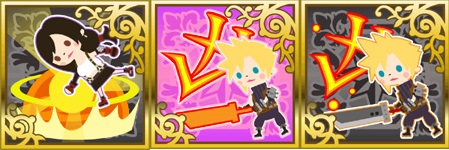
What is this supposed to mean if the Hinamatsuri set should be taken as indication of Square’s position on Cloud and Aerith? Particularly when considering that this Cloud and Tifa set was released almost an entire year before the Hinamatsuri set came along, was the first set of its kind to be released, and didn’t feature Cloud alongside either his game’s secondary main protagonist nor even its primary antagonist, does the deliberate selection of Tifa to feature alongside Cloud not then seem particularly noteworthy if viewing everything through a romantic lens?
From here, establishing any romantic links whatsoever gets only more unlikely. This is most apparent with regard to three summon sets released via capsule dispensers in August 2012 — one featuring Lightning, Noel and Caius; a second featuring Terra, Locke and Kefka; and a third featuring Ashe, Seifer and Vivi:
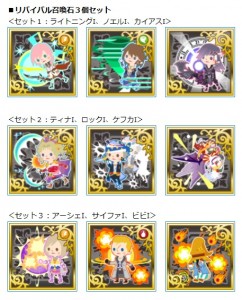
While Hinamatsuri sets based on anime and other media do, in fact, typically pair up romantic couples as the emperor and empress, it would make as much sense in this case for FFVII’s main hero and heroine to have been selected for the main roles from the doll set simply on the basis of their roles in FFVII.
As hitoshura once put it:
—
Airborne Brigade is a little spin-off game, and the emperor and empress cards are a reference to Hinamatsuri, a cultural event that happened when they released them. Just like pairing Zack and Tifa as school kids was a reference to the start of the new school year.School romances are a common cliche — hundreds and thousands of shoujo manga books on this theme must fill the shelves of Japanese book stores. All the TV dramas and movies, all the novels. You’d have to be in denial to not admit that. What significance (beyond FFVII being popular) does pairing Tifa and Zack have? What is SE trying to say with that choice? That they’re just side characters relegated to getting the scrap roles not fit for emperors and empresses?
—
This author is probably more willing than most to accept the emperor and empress cards as a subtle nod to the potential romance Cloud and Aerith could have had. However, I am simply unable to buy that “this is how Square sees them” was the primary intention when the announcement and release of the Hinamatsuri holiday specials were accompanied by the school uniform Tifa and Zack specials in reference to the start of the school year.
If “this is how Square sees them” applies to one set, then what are they saying about the other? To make the first into some definitive romantic statement requires either applying an inconsistent logic where the other set is concerned or ignoring it outright — neither of which makes for a sound approach.
The only consistent logic you can bring to the whole thing is that the main characters of FFVII got the emperor and empress roles while the secondary characters were relegated the less notable appearance.
This same reasoning would apply to the Cloud and Aerith ice cream at the Artnia cafe. They are two of the most popular and recognizable characters in Square Enix’s catalogue, and the main characters of their game — itself the most successful and popular Final Fantasy title.
In general, FFVII dominates the decor and offerings at Artnia. While they offer alcoholic beverages based on the ubiquitous Shiva, Ifrit, Phoenix and Titan summons, they also have drinks based on the rather game-specific red and blue materia.
It’s not as though Tifa is ignored at the cafe. Some of the establishment’s napkins feature the Seventh Heaven logo, as does one of the chocolates from one of three sets wherein FFVII again dominates the aesthetic.
Even most of the coasters not based on FF mascots (e.g. chocobos and moogles) are based on FFVII. Likewise with the menu’s pancakes.
The matter is simply that — as with the Hinamatsuri promotion for Airborne Brigade — the main characters of FFVII (the dominant title at the cafe) got the more notable presentations.
With respect to the Lightning Returns garbs, there are a number of explanations for Cloud and Aerith’s selection beyond SE trying to be cute and make romantic references via Lightning (by herself) wearing the clothing of characters from other games.
In the first place, Cloud and Aerith are not the only characters whose outfits Lightning is receiving, nor were they announced together. After teasing the possibility of Lightning getting a Cloud outfit back in January, Yuna’s Summoner garb from Final Fantasy X was revealed in June, then Cloud’s SOLDIER 1st Class uniform in July, the female Miqo’te outfit from FFXIV: A Realm Reborn later the same month, and then Aerith’s outfit in September.
Secondly, most, if not all, of this has been for promotional purposes as part of the Final Fantasy Go There campaign. Yuna, who — like Cloud and Aerith — is a main character from her game, has the FFX|FFX-2 HD Remaster coming out soon. FFXIV: A Realm Reborn had just been released, and itself is receiving DLC in which Lightning appears and her original outfit from FFXIII is available for players to place on their own characters. Lightning Returns is, of course, an upcoming release.
Not only that, but players of A Realm Reborn will also have the opportunity to receive Snow’s outfit from FFXIII. It stands to reason that Snow and Lightning were selected together not because of any romance between them (there is none), but because they are the two primary main characters of FFXIII, as Cloud and Aerith are in their game.
That only leaves FFVII to be explained. Not that it is difficult to. FFVII has always been Square’s go-to source for promotional content, even as far back as 1997 when Cloud was included as a controllable unit in Final Fantasy Tactics.
Next up in need of consideration, at the design stage, Lightning was conceived with the idea in mind that she be “someone like a female version of Cloud,” per FFXIII director Motomu Toryiama’s request:
—
EGM: What can you tell us about the heroine of FFXIII?
Motomu Toriyama: We can’t tell you all the details, unfortunately. Looking at the history of the FF series, there were already female main characters, like in FFVI, FFX, and FFX-2. This time, one of the characteristics of this heroine is that she’s not that feminine. I tried to make her someone very strong, independent. When I asked Mr. Nomura to design this character, I requested someone like a female version of Cloud from FFVII.
—
Rather fitting, then, that she would receive his outfit in Lightning Returns.
Lastly, Lightning’s Japanese voice actor, Maaya Sakamoto, also voices Aerith — as well as Diva from Final Fantasy Type-0 and Aya Brea in Parasite Eve: The 3rd Birthday. That alone provides sound reason for Aerith’s outfit to be made available for Lightning, as with the case of The 3rd Birthday’s cross-promotion with Dissidia 012, in which Aya Brea’s outfit is an alternate costume for Lightning, while Lightning’s outfit from FFXIII was an alternate for Aya in The 3rd Birthday.
Bringing this assessment back round to the Hinamatsuri set from Airborne Brigade and wallpaper from Kingdom Hearts Mobile, if we’re looking at how these games have represented the Final Fantasy VII cast for holiday promotions, we simply can’t overlook these other Kingdom Hearts Mobile wallpapers (first and third image) and mobile phone texting stationary (second):
Featuring Cloud accepting a box of Valentine’s Day chocolate from Tifa, the two decorating a Christmas tree together and the two of them looking at Christmas lights while Cloud affectionately places his hand on her shoulder, these images are infinitely more romantic. Unlike Hinamatsuri, these are actually romantic holidays for young couples in Japan — the two most romantic holidays, in fact.
While western traditions don’t see Christmas Eve as such, for young adults in Japan, Christmas Eve is comparable to western views of Valentine’s Day, as explained in this Wall Street Journal article:
—
Akino Koshiba’s vision of a perfect Christmas begins with lingerie shopping and a visit to a beauty salon, the way she would prepare for any special date.On Christmas Eve, a Tom Cruise look-alike picks her up in his BMW, and they drive to a fancy French restaurant. He gives her a gift that shows how well he knows her taste.
“If it weren’t for Christmas, I’m not sure if I’d go out of my way to find boyfriends,” Ms. Koshiba said.
While many Americans dream of a white Christmas, Japanese dream of romance. In Japan, where Christmas is often a workday, the holiday morphed over the years into a kind of Valentine’s Day for young couples.“Everywhere you go, you are constantly reminded that you don’t have a girlfriend,” said Tomohito Shimazu, a 20-year-old university student. He and his single male friends plan to get together for drinks on Christmas Eve, but one recently dropped out, confessing he met a woman. “We call him a traitor,” Mr. Shimazu said.
—
Even the comments made by these young people sound like the comments made by young people in western countries regarding Valentine’s Day.
As for Valentine’s Day itself, that’s done a little differently as well. While a western man may be expected to go to some special effort in putting together a romantic evening for he and his girlfriend, in Japan, Valentine’s Day is a day in which women and girls give special chocolates to the men and boys they’re interested in — husbands, boyfriends and prospective boyfriends.
There are actually two types of chocolate they give: giri choco (義理チョコ) and honmei choco (本命チョコ). The former, whose name literally means “obligation chocolate,” is given to male friends, male coworkers or other men whom a woman may feel bad about not giving something to. Honmei choco, meaning “true feeling chocolate,” is given to a male whom the female has genuine romantic feelings for.
As noted by tumblr user, passinglurker:
—
In Japan (as shown in shoujo manga/anime/games), besides the tradition that girls are the ones to give chocolates on Valentine’s, there are also two types of Valentine’s chocolates they can give — “honmei choco” and “giri choco.” “Honmei choco” is basically homemade chocolate, given to a person one has romantic feelings for. “Giri choco” is known as “obligation chocolate,” which is a type of chocolate given to friends and people they are obligated to give chocolate to (like a mentor or a person who helped them in the past).Now here’s the kicker. Accepting “honmei choco” is equivalent to accepting the other’s feelings and also reciprocating them. There is a reason why a lot of “popular” male characters in shoujo manga refuse to accept honmei choco from girls they are not interested in — accepting them means going out with them, as in, as boyfriend and girlfriend. This is also why, to a lot of girls, giving this is equivalent to confessing, and having them not be accepted means rejection. Honmei choco is a big deal.
Now, what is Cloud doing in this picture? He is accepting Tifa’s chocolate. And it’s obvious that it’s honmei choco because it is heart shaped (seriously, Google honmei choco and that’s the first thing you see). You can’t give heart-shaped giri choco, because that’s mixed signals. It’s also obvious that he’s reaching out to it, because he is. And don’t forget all those hearts surrounding them.
Put two and two together, and what do we get?
“Confirmation of mutual feelings,” maybe?
Words aren’t the only way, indeed.
—
Finally, that leaves us with one other KH Mobile wallpaper depicting a romantic situation between Cloud and Tifa. In this wallpaper, the two can be seen holding hands at King Mickey and Queen Minnie’s wedding:
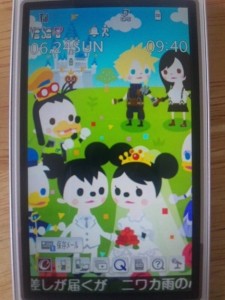
If there is any doubt that these images are official, by the way, that can be confirmed despite the KH Mobile service being discontinued since April 30, 2012.
This February 24, 2012, tweet by Japanese Twitter user nekoswitch refers to the Valentine’s Day wallpaper (バレンタイン is “Valentine” or “Valentine’s”; クラティ is “Kurati” — or “Cloti,” as it’s written in Japanese). Likewise, a number of message board postings on this Japanese webpage refer to the Valentine’s Day wallpaper, both Christmas images and the wedding of Mickey and Minnie wallpaper.
クリスマス is “Christmas.” クラティサンタコスのデコメ is “Cloti Santa costume decome,” with “decome” (デコメ) being short for “decomeeru” (デコメール), or“decoration mail” — cellphone-based stationary users can add their own text to. Lastly, 結婚式 is “wedding.”
This post in particular mentions all of these event-related images:
—
Cloti appears in KH Mobile whenever there is a seasonal event, such as Xmas, Valentine’s or the wedding.
—Japanese text:
—
KHモバイルってXmasやバレンタイン、結婚式とか、季節の行事あるたびにクラティ出してくれるよね
—
Now, is all this to say that we have an “end to the LTD” via these images alone and that they supercede all else, including material actually canon to the Compilation of FFVII itself? No, but it is to say that — as with the Itadaki Street cameos — one should be mindful of the comparisons they invite when we seek to base our analyses upon them.
As with so much else that we have examined in this analysis, if you have to look so far beyond the primary sources (i.e., the Compilation of FFVII) and immediate secondary sources (e.g., Ultimanias and developer interviews) to verify an idea about the characters, chances are high that you’re simply doing it wrong.


